ONE HUNDRED YEARS
EJOT moment 01 >> 2022 1 01 //2022 moment Magazine
Unit Construction Quality – and sustainability
W. Kocherscheidt A visionary with foresight and the courage to take risks Market Unit Industry Much more than just a screw
Market
Hans
Editor
EJOT Holding GmbH & Co. KG
Im Herrengarten1
D-57319 Bad Berleburg
Phone +49 2751 529-0 www.ejot.de
Editorial staff
Andreas Blecher
Annemarie Bremer
Eva-Maria Hormighausen
Heinrich-Georg Homrighausen
Christian F. Kocherscheidt

Jutta Rathmann
Katrin Strübe
Andreas Wolf
Design
reaze GmbH, Siegen
Print
Vorländer GmbH & Co. KG, Siegen
Copyright
All contributions published in the magazine (texts, photos, graphics, logos and tables) are protected by copyright. The copyright lies with EJOT Holding GmbH & Co. KG – if not stated differently. Reproduction, inclusion into databases, online services and Internet pages as well as duplication on data carriers are subject to prior written approval by EJOT Holding GmbH & Co. KG.
Frequency of publication
moment is published semi-annually
Acquisition
Phone +49 2751 529-0 or at www.ejot.com
Cover: reaze GmbH, Siegen
Dear partners of the EJOT Group,
the title of this issue of moment gives it away, it is a special year for our group. We have joined the circle of centenarians. This is a point where we pause, look back, but also look forward. A year full of activities, projects and celebrations. However, it is also a year in which the war in Ukraine made it clear how easily things can slip away and what has been achieved can be jeopardized. So once again, a year that will not be easy to navigate.
This year, we are also paying tribute to the many activities with this copy of moment, because instead of two issues, we will only produce one issue in this anniversary year – but a substantial one! To this end, we have settled somewhere between a “commemorative magazine” and a look into the future.
Where do we come from? The long road from “nail shack” to a technology and industry leader in fastening technology is outlined. The discovery of application technology as a “gamechanger” that highlights the greater benefit of eliminating expensive processes over the smaller benefit of a ‘slightly lower price’.
In the course of the 100 years, people have always shaped us and led our group on new paths, which is why we would also like to introduce you to some of these people in this anniversary issue. It is people that make the difference, because we – and all our competitors – can use the same raw materials, machines, tools and equipment. These are usually available to everyone – and yet there is a difference, which we experience in the finished product or in the product’s development. If all other things are equal, it is us humans who make the difference. At EJOT this has been a success story.
We want to courageously continue this into the future: To the next 100!
Yours sincerely
Christian F. Kocherscheidt Managing Director
01 >> 2022 EJOT moment 2 Imprint
Editorial
Hans Werner Kocherscheidt
4 Lawyer and entrepreneur
7 A visionary Company anniversary
10 And so the next one hundred years begins
Market Unit Industry
14 The way to the top – industry leader as a matter of principle
16 Market Unit Industry – much more than just screws

Market Unit Construction
22 Highest quality – sustainable
24 Professional applications for the building envelope
Technology
30 From nail to functional part
Quality management
32 Quality remains a prerequisite for success
Advisory board
54 The advisory board – an important control body for the company’s success
Corporate Design
56 The colour doesn’t matter, as long as it’s white
58 The EJOT architecture
60 EJOT and Triathlon: An unprecedented success story
People at EJOT
64 Women and technology – that’s the way
66 From shop floor to Head of Maintenance
68 Georg Dickel – A sought-after specialist for 53 years
70 From apprentice to technical manager
License Management
72 Machines are his passion
74 Around the world in 30 years
76 EJOT is a family matter for the Hauer household
78 Balancing act between Germany and the Middle Kingdom Digitalization
History
EJOT moment 01 >> 2022 3 CONTENT
and logistics – now and in the future
EJOT becomes carbon neutral
Project Treeathlon® – EJOT reforests
Expanding
in global growth markets
of license management
staff children
34 Consequent use of digitilization opportunities Logistics 36 SCM, purchasing
Sustainability 40
44
EJOT International 46
presence
48 Potential and benefit
Family-owned company 50 Holiday camp for
Vocational training 52 Focusing on “career through apprenticeship” again
The
course
PT
screw revolutionises the fastener market
Success story EJOT in Tambach
Portraits of the subsidiaries
80 How it all began at the “nail shack” 84 The cradle of the clever (EJOT) heads 86 A strategic coup:
merger of Böhl and Jaeger 90 Historically grown: EJOT on expansion
92
®
96
98
Hans Werner Kocherscheidt lawyer and entrepreneur
His great passion was pleading in court – especially when it came to criminal defence. He also convinced with his speeches – not just his employees, but also many others in the course of his long life.

Hans Werner Kocherscheidt was born on 7 October 1928 in Kleinhammer (Werdohl), in today's Märkischer Kreis region, along the Lenne river. He died at the age of 88 on Good Friday 2017 in Bad Berleburg as a result of a serious operation. His father was an elementary school teacher, his mother a housewife. When Hans Werner was just five years old, his father died young, leaving the family, which also included a brother and a sister, with only a small pension. His brother died in the war and his sister died of cancer in her mid-50s. Hans Werner Kocherscheidt once told me that it would have been even more difficult without having a vegetable garden, so it was good that his mother still had many relatives in Wittgenstein, especially in Berghausen. They helped, especially the uncle, Adolf Böhl, who had no children and was happy to take care of his nephew Hans Werner. The visits to Wittgenstein took place by train. With a train connection that no longer exists in this form, namely from Altenhundem through a tunnel that connected the Lenne river with the Eder river back in the 1930s. Uncle Adolf had been a master wainwright, but then from 1922 he started producing nails in Berghausen, and quickly changed to making screws. This then became the Adolf Böhl company and later the EJOT company, as we know it today.
The war years were stressful for the high school student Kocherscheidt at the high school in Altena, he had to enlist as an anti-aircraft warfare helper at the age of 14 and had a very intense experience of the last year of the Second World War. But then came graduation (the German “Abitur”) in 1949. Hans Werner Kocherscheidt decided to study law in Mainz and Bonn with Uncle Adolf’s help, he passed his first state exam and then spent
his legal traineeship in the district of Siegen. After the second state examination, the decision was made: Hans Werner Kocherscheidt wanted to become a lawyer. He spent the time that was still necessary as a trainee lawyer in Essen, where he married his wife Gisela in 1959. Although she lived in Essen at the time, she was born to the Frank family in Laasphe-Banfe. The young couple first moved to Laasphe, but then soon after to Berleburg. In 1959, Hans Werner Kocherscheidt was initially employed in the Glöde law firm on Bismarckstrasse before founding his own law and notary's office at Bahnhofstrasse 1a. The law firm continues to exist today in the same premises as the lawyer company Bald and Henk.
As a lawyer and notary, Hans Werner Kocherscheidt was extremely successful. Within a few years, together with the employed lawyer Elisabeth Achinger and his partner Hartwig Achinger, and later with my college friend Albrecht Beitzel, he had one of the most renowned law and notary’s offices in South Westphalia. Hermann Josef Terahe in Olpe, Waldemar Grotepass and the law firm Schleifenbaum in Siegen were well-known law firms. I met him at the end of 1975. As a young assessor, I became his employee for a few months and almost stayed because he would have liked to have me as his partner. He had the room directly to the left of the entrance. He could be heard as soon as he entered the house. Then there was a fresh start among the complete team.
The professional focus of Hans Werner Kocherscheidt certainly was the commercial and corporate law. Many enterprises in Wittgenstein are still working well with the partnership agreements
1922
In the workshop behind his parents' house in the village of Berghausen near Berleburg, Adolf Böhl began producing nails in 1922. He got the nail press from his friend Wilhelm Herberg from Altena.
1924
In the issue of the Wittgensteiner Kreisblatt newspaper from 11 February 1924, an official announcement states that Adolf Böhl applied for 'approval from the trade police to erect a factory building with a turbine system' on his property in Trufte. The
01 >> 2022 EJOT moment 4
HANS WERNER KOCHERSCHEIDT
>>Text: Winfried Schwarz
water from the Trufte stream was to be dammed up in an existing feeder and used to drive a turbine.
1926
In 1926, Adolf Böhl moved production to a small new building in the Trufte, where he could rely on licensed hydroelectric power. Pictured is the small production facility in the village centre of Berghausen.
1928
In 1928, Adolf Böhl succeeded in hiring Heinrich Henk, a native from Wittgenstein with knowledge of wire processing. Henk had acquired his knowledge at the company Knipping in Altena. The company Knipping later became Lennewerk. Another
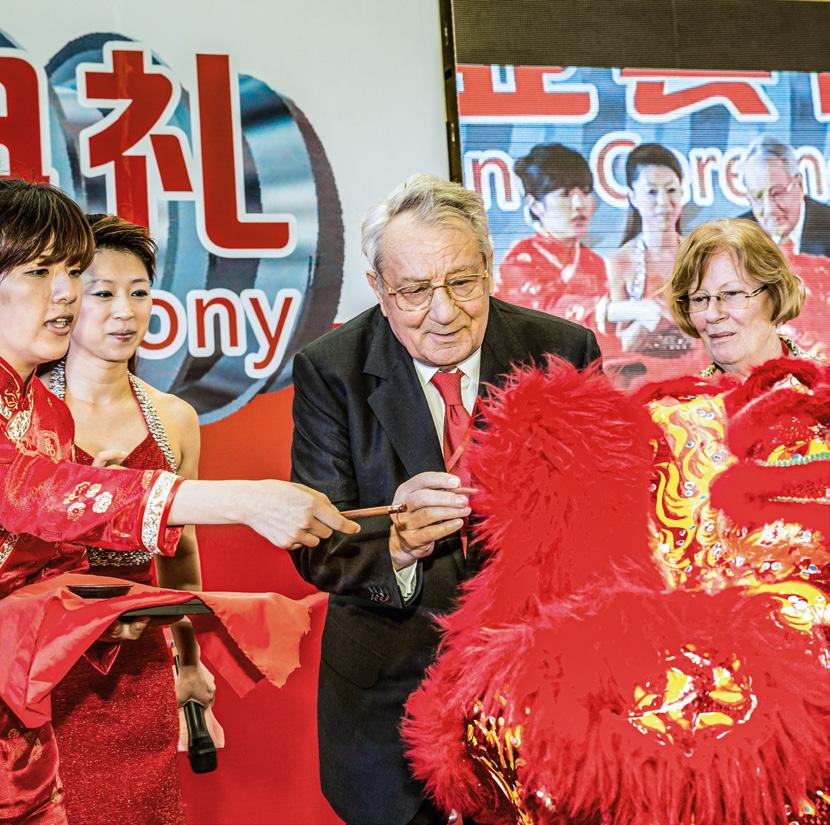
skilled worker was the locksmith Wilhelm Wagner from Berghausen, who was soon able to make pinching tools for the pin presses.

EJOT moment 01 >> 2022 5
that he had designed. But his real passion was actually criminal law. He was a genius defence lawyer. He fought for his clients and was proud when his defence strategy had been successful. He was then on an equal footing with the famous criminal defence lawyer Rolf Bossi, against whom he had to appear twice and was able to successfully reject an appeal in one case.
As I later heard from his children Christian and Kathrin, the time for EJOT actually was the Saturday morning. In 1960 his uncle Adolf transferred his company to him, and Eberhard Jaeger joined in 1965. On Saturdays he talked to his foreman Adolf Sonneborn and his managing director Kurt Machate in the office. In 1922, Adolf Böhl was persuaded by his comrades-in-arms to go into screw production. The specialists for this came from the cradle of German screw production, from the Lenne valley. Sonneborn was from Wittgenstein, but Machate came from Altena and was a knowledgeable screw specialist. The Mister EJOT, Hermann Großberndt, also came from there. In 1977, after laborious and time-consuming preliminary work, he succeeded in inventing the PT® screw and 20 years later the Delta PT®. As chief developer in the 1980s and 1990s, Großberndt was responsible for the development of the entire range of screws at EJOT.
Hans Werner Kocherscheidt was good with people. He had a charisma that captivated those around him. Somehow he knew who and what could help him and his company. The outsourcing of the construction screw and the first European branch offices made the company continuously larger. He knew them all personally, his managing directors and many employees anyway, but above all the foreign managing directors, who can often report on personal experiences with him.
I have even seen employees ask him for legal advice several times. That went without saying for him. This often resulted in a special relationship of trust, which ensured good employee loyalty.
He was lucky to have his son Christian as his successor who has been fascinated by the topic of cold forming the same way as he was. Christian had just graduated with a degree in business administration and was planning to work as a trainee in an American screw factory for a year. Through various customer contacts, he and his father met Don Surber at a trade fair in Atlanta. Mr. Surber, owner of the company Accurate Threaded Fasteners (ATF) and
then chairman of the American Screw Association, drove with the guests to the ATF headquarters in Chicago, where Christian then worked for a year. ATF then became a licensee and partner in other companies, most notably for the founding of Asyst in Kenosha. Not only did a good business relationship develop with ATF and the Surber family, but also a close friendship.
The acquisition of qualified employees was almost like a hobby for him. Once he invited me to go sailing with him and his wife on the Edersee. In addition to the sailing boat ‘Sophie’, he also had a small holiday home there. He had invited an applicant from Thuringia there, whom he wanted to get to know and employ for a job at the Tambach plant. Mrs. Kocherscheidt was sent on a ship of the ‘white fleet’ with the wife who was travelling along. The three of us then cruised on the Edersee and got to know each other very well. A hearty barbecue in the holiday home was the perfect way to end the day. The employee was hired. He advanced an important invention for years and is now Managing Director.
An entrepreneurial feat was the takeover of the Tambach screw factory from the trust agency in 1993. The promise to employ 202 people has not only been kept: In fact, there were more than 300 from day one. Tambach has now hit the bull's eye both in the manufacture of screws and in the hardening and tempering of screws and in the production of technical plastic parts. But here, too, it was and became very personal. Hans Werner Kocherscheidt appeared regularly with his wife Gisela, stayed in one of the three apartments set up for the family and guests in the factory and spoke to the people. And of course, he was there at the Christmas party. That went without saying for him.
And EJOT grew and grew. However, such a continuous growth also caused problems. Crises are always good when they can be overcome successfully and when you have learned from your mistakes. That happened to us in 2002 and 2005 but also in 2008 like to many other companies. We approached the employees with great openness, but above all the works councils and trade union IG Metall, and finally got the problems under control with important employee agreements and company wage agreements. That would not have been possible without Hans Werner Kocherscheidt. True to the motto – if the company is doing well, the employees should also do well – the old-age pension program SENECA and the contingent commission SENECA PLUS were introduced.
1935
In 1935, when the company had four employees, Adolf Böhl hired a 16-year-old young man, Adolf Sonneborn from Berghausen, who later had a decisive influence on the company's fate for over 50 years.

1935
Between 1935 and 1939, sales revenues for nails deteriorated. The company switched to the production of screw nails. A manually operated flat jaw roller was purchased for this purpose.
1937
At the end of the 1930s, the production of wood screws with a one die single header for screws with 2.4 and 2.7 mm diameter and 10 to 20 mm shank length was started. The business is expanded, new machines are purchased.
01 >> 2022 EJOT moment 6
HANS WERNER KOCHERSCHEIDT
EJOT really lives the topic of work and family. There is a flexible response when there are problems with the employees. It is particularly important that young mothers are reintegrated into working life after a pregnancy. And Hans Werner Kocherscheidt wanted it all, helped shape it and supported it.
He had a special way to approach his employees. It always included a bit of a demand. He recognised that the quality of the work goes along with education very early on. That’s why he
initiated and founded what was then the industrial training workshop Wittgenstein, today’s Wittgenstein Training Centre (BZW), more than 40 years ago. Qualified training for young people in all trades was important to him and he was really proud when, in 2016, an EJOT trainee became the best tool mechanic in Germany for the first time.
None of us expected his sudden death on Good Friday 2017, he will be fondly remembered by many. E
Schwarz Manager
A visionary with foresight and a particular instinct for people
The first encounter with the lawyer Hans Werner Kocherscheidt dates back to 1964. Kurt Machate, CEO at Adolf Böhl in Berghausen, whom I know professionally from our time together at the Lennewerk Altena, invites me to visit Berleburg and introduces me to Hans Werner Kocherscheidt.

The first impression: Almost the same age, very eloquent, decisive, conversational, follows words with deeds: When I leave his house, I have an employment contract in my pocket. On my first working day at the Böhl company, I drive to his office to personally announce that I will be starting work.
As we continue to work together, I find out that he knows his company inside and out and also surprises others with his indepth knowledge: We are at a meeting of the German Screw Association in Düsseldorf, where he makes it clear to the group that he is a lawyer and not a screw specialist like the participants
of the meeting. A few minutes later, when the conversation turns to special headers and technical details, Mr. Kocherscheidt gives a presentation on double-blow headers from various manufacturers. He goes into detail about wire dimensions, speed and section lengths and even supplies accurate price information. Never again did anyone believe that he was just a layman in the screw business.
Hans Werner Kocherscheidt is inquisitive, and even the smallest details do not go unnoticed. His favourite “tool” is the telephone: He is on the phone with all his senior employees – but not only
1938
In 1938, 16 years after the company was founded, it was entered into the commercial register in Siegen. Production stagnated during the Second World War, and operations were temporarily suspended towards the end of the war.
1945
As mayor and local group leader of the NSDAP, Adolf Böhl was classified as 'NS-incriminated' by the American occupation authorities and was detained from 1945 to 1948. During this time, the company was under the trusteeship of Otto Stahlschmidt.
1946 /1947
Eberhard Jaeger (right) establishes a screw factory near the Bad Laasphe train station and begins manufacturing commercial screws - with a Hilgeland double-blow header, a slotting machine and a thread rolling machine.
EJOT moment 01 >> 2022 7
Winfried
at EJOT Holding GmbH & Co. KG from 2000 to 2017
>>Text: Bruno Kayser
them – anywhere from once to several times a day. You may ask yourself how he knows all these things. After all, he is a lawyer and also represents and processes contracts for company employees; and while he already has them in his office, he also knows the necessary questioning techniques in order to get all the information that interests him and absorbs it like a sponge.
He is the “boss”. All major investments in machines, cars, buildings, etc. are co-determined and negotiated by him. Hence, his detailed knowledge. Nevertheless, his senior employees are free to come up with their own ideas, projects and developments. Hans Werner Kochscheidt wants to know them all, and then supports them. He accompanies the development of contacts to new customers, expansions and operational innovations, e.g. the development of facade screws, PT® screws and later also the EJOWELD® research project. This also includes the establishment of new sales offices and branch offices abroad. Hans Werner Kocherscheidt came up with the idea of going into the processing of plastics in addition to screw production. He’s quite an entrepreneur with the courage to take risks, because this is a new area of production that the company has no experience in.
He receives daily reports from sales about incoming orders, with the names of the most important clients. And he wants to know how to increase sales. He contributes his own ideas and makes suggestions. An important concern for him is to utilise the full capacity of plants, the running time of the machines and minimisation of the set-up times due to larger order quantities per dimension.
During an evening or weekend walk with his dog, he often stops by my apartment for a short visit. The conversation quickly turns to company business. He always gives suggestions and explains his ideas. He wants the companies Böhl and Jaeger to grow, also abroad. The umlauts in the company names bother him. This is how the idea was came about to create a common name: EJOT –but not the former sign of Eberhard Jaeger. A few designers are commissioned to create drafts for a company logo. A draft by the designer and graphic artist Ulf Höppner from Berleburg impresses the most. From now on, the red EJOT logo applies to all business papers and can be seen on every company building and on every car. No matter where a building is rented or built, at home or abroad, Hans Werner Kocherscheidt is there to ensure that his ideas about the image are implemented, because corporate identity is important to him.
Hans Werner Kocherscheidt is a visionary and thinks ahead. In his early years, he invested in machines in the hope that his sales team would take care of the orders incoming. For example, he buys a rolling machine with attachment devices for several washers, but there is no need for them yet. There are certainly other similar examples. He is constantly on the lookout for suitable experts and also invests beyond current needs. Ultimately, his decisions are always right.
Over the years, Hans Werner Kocherscheidt was aware of how many fates depend on his decisions: He likes to celebrate – also with his staff. Also on the occasion of his 60th birthday. During the
1948
The development of the Adolf Böhl plant is extremely sluggish under difficult conditions. Single-blow headers and rollers, cutting machines and head slitting machines are available. The economy mostly runs on barter transactions only.
1950
In the beginning of the 1950s the economic situation improves at Adolf Böhl. By 1960 the number of employees had been increased to about 60, with sales of DM 2 million per year.


1953
Eberhard Jaeger invests in a new building at the location In der Bienhecke in Bad Laasphe with production hall and office building. The customers come from the electrical industry and purchase slotted screws according to DIN. At this time, the company has six employees.
01 >> 2022 EJOT moment 8
HANS WERNER KOCHERSCHEIDT
1957
The first galvanizing plant is built at Jaeger at the Bienhecke location. Zinc, copper, brass and nickel coatings can be applied to the screws. Even then, the operation of this plant was associated with the obligation of wastewater detoxification and neutralization, but by no means to today's standards.

preparations, we consider how many people will come together (including spouses). I tell him: “We have about 400 employees.” He replies quite harshly: “But now you've really ruined my day.” The explanation for this statement follows immediately: “You forgot the women and children who are all attached to the company and for whom I am responsible.”
Hans Werner Kocherscheidt came from a very Christian home, which he openly stated. No matter who he invited, for example a business dinner at home or in a restaurant, before the meal he bowed his head and folded his hands in a short, silent prayer of thanks. In the Monday talks with his senior staff, he reported on his Sunday visits to one of the churches in Wittgenstein, after which he liked to visit the plants (he had a master key) in order to inform the plant manager on Monday about everything that caught his eye.
Twice in all those years I've seen something upset him: When the electro-plating shop at the Bienhecke site in Laasphe caught fire and we helplessly watched on as it burned – he had tears in his eyes. He didn’t let anything get in the way of his closest colleagues and friends, especially Adolf Sonneborn. When someone said something negative about the plant manager in a meeting when he was not present, Hans Werner Kocherscheidt could not keep quiet. Rarely have I seen such fiery eyes and heard this sharpness in his voice.
He came up with the idea of visiting East Germany to find out about their screw industry shortly after the fall of the Berlin Wall in 1989. The negotiations and deliberations both in Tambach and later in Berlin with the Treuhandanstalt were usually led by him. The acquisition of the Tambach screw factory was the largest investment to date, with the number of employees suddenly doubling from 650 to 1,050 and with it the feeling of growing responsibility.

He loved personal contact and also wanted to get to know the people in Tambach-Dietharz quickly, which is why he invited the department heads and foremen to a relaxed get-together at the local sports club, which at the time belonged to the screw factory, and everyone had to introduce themselves by name, position and career. He wanted to create trust. He also expressed this, by aiming the first investment directly at the workforce: it was the renovation of the washrooms and toilets. Only then did the renewals in operation and administration follow.
1958
For the time, the Adolf Böhl company had quite a considerable machine park, including double-blow headers for metric threaded and sheet metal screws.

EJOT moment 01 >> 2022 9
E
Gisela and Hans Werner Kocherscheidt, Winfried Schwarz and Bruno Kayser (f.l.).
1960
Adolf Böhl passed away in 1960 at the age of 71. As the legal heir, his nephew Hans Werner Kocherscheidt takes over the company. Hans Werner Kocherscheidt invests and, among other things, creates the basis for a modern, more competitive production with the purchase of two high-performance double-blow headers from National.

1962
Addition of a production hall and manufacture of extra-long slotted screws. As the market for slotted screws is under pressure, the product portfolio is converted to stainless steel screws.
1963
Kurt Machate joins Adolf Böhl from Lennewerk Altena as the new Managing Director. Together with Adolf Sonneborn, who is responsible for the technical part, they form a very successful team in the production and marketing of sheet metal and chipboard screws.

01 >> 2022 EJOT moment 10 101 100
ANNIVERSARY
And so the next one hundred years begins
“Great
their shadows
as the saying goes. The same goes for the celebration of a great anniversary, even if, at first, it seems a long way away. But the more we think about it, the more we realise that a centenary is something worth celebrating. But the question is, how exactly?
It soon becomes clear that the aim here is not to throw as much money as possible in the shortest time possible at the centenary event, but instead to link the celebration of the centenary with a future vision that will carry us into the next century. A vision that says “To the next 100 years.” We didn’t want to focus on the past, as significant as it has been for our company's development. Instead, we wanted to affirm that, even 100 years on from the foundation of our company, we remain a vibrant organisation with great hopes and aspirations. Our team around the world should take confidence from this fact and feel encouraged to continue developing and improving products and processes which provide additional benefits to and improve the experience of customers, thus strengthening our relationships even further.
At the same time, the occasion will of course be used to celebrate the past 100 years of EJOT. Initial thoughts on this go all the way back to 2019. We invited event planning agencies to workshops, listened to their ideas and compared them to our own ideas, as well as having what were at times heated discussions as to which direction the project should take. And, yes, we even asked around to find out how other companies have commemorated similar anniversaries. This proved to be an important process, during which it became increasingly clear that we could do a lot ourselves, even without an event planning agency. Our centenary celebration shouldn’t be an event full of glitz and glamour and just be for show. We should stay grounded, as EJOT always has done.
Over the entire centenary year, there will be celebrations at each respective EJOT site with events including family days,
1965
In 1965, Hans Werner Kocherscheidt acquires the Eberhard Jaeger company in Laasphe. The company Jaeger also produces metric slotted screws, but those screws were sold in other market segments. For the company Adolf Böhl this meant a market expansion.

1965
At Jaeger, 22 employees with relevant knowledge are available. Another important aspect in the course of the takeover was the fact that Jaeger was authorised to operate a galvanic plant, which could be used for both companies after a necessary expansion.
1967
The company name EJOT is "born": With the investment in a teleprinter at Jaeger, a name abbreviation must be set as the address. At Eberhard Jaeger the first letters E and J where used and the J was then amended to JOT due to the phonetic pronunciation in German.

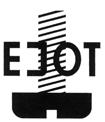
EJOT moment 01 >> 2022 11
events cast
ahead,”
>>Text: Christian Kocherscheidt and Andreas Wolf
music festivals and centenary concerts as well as steamboat trips and open factory doors. At some sites, the centenary celebrations will be combined with the inauguration of new production halls or new production buildings.
We also want to take this opportunity to give something back to all the people at EJOT sites who have helped the business successfully grow over the last decades. For this purpose, the employees at our locations have come up with charity campaigns, which focus on how we can help people and do our bit to help protect nature and the environment. The result has been numerous local projects, in which employees have gotten involved in a wide variety of ways, including campaigns supporting social institutions and athletes with disabilities as well as one which donated an electric vehicle to make the daily working lives of employees with disabilities easier. Another important aspect of these charity campaigns has been the commitment to protect nature and the environment, demonstrated, for example, by both reforestation and planting campaigns as well as a waste collection campaign in a nature reserve. Many of the campaigns are designed to be sustainable and are to carry on beyond the celebrations.
Right at the beginning of the centenary year, we went live with our centenary platform: At www.ejot100.com the EJOT family can meet to exchange stories, pictures, videos, music, take part in games or even competitions. The platform is the heart of the centenary year celebrations. The EJOT song “Bringing it together”, composed and produced by the band Billenial Collective made
up of three young musicians from Bad Berleburg, Germany, also helps people to connect and engage with the company’s history. The audio version of the song is available to stream on all streaming services. The video, shot at our production site Herrenwiese in Bad Berleburg, is also available to view on our platform, on our social media pages as well as on Youtube.
We have also completely rewritten – and put to film – the history of the screw, which, believe it or not, dates back far beyond our 100year company history to the Stone Age, a time shortly before EJOT arrived on the scene as a fastening technology specialist. A satire, not entirely serious but humorous story.
One of the questions at the heart of this centenary year is: How can we carry our success of the past decades into the future? The answer to this question is connected to the realisation that ideas for products or processes do not simply come from nothing, but instead emerge when we get to know the practical tasks of our customers and initiate a subsequent development process. Not only that, the more demanding the goals of our customers as industry leaders in their respective segments, the better. Demanding goals require sophisticated solutions – solutions which we can invest in going forward.
The question is will we continue to find these customers at home in Germany, or Europe, our core markets, or do we have to look further afield? And if we do have to look further afield, will it still be the case that the questions to all of our most demanding
www.ejot100.com/de/birthday-videos

1968
Addition of a new production and storage hall at Bienhecke for the production of drilling screws with sealing washer. Also at this time, the first self-made packaging line is built. A roller conveyor picks up the transport containers from the production
line. In front of the scale, a tipping device is installed which can hold and slowly tilt a container allowing controlled filling of the screws. The filled cartons are then transported on roller conveyors and labeled and closed at the same time.
1970
“Birth year” of the Engineered plastic Components Business Unit. For strategic reasons, the screw segment is expanded to include a further mainstay. But it is a long way to implementation.
1971
Powder metallurgy – A powder metallurgical process is used to produce contact tubes for gas-shielded welding technology. The driving force behind this development is Horst Dieter Klees.
01 >> 2022 EJOT moment 12
ANNIVERSARY
customer goals will have to continue to be addressed and answered by German employees in a German holding company? Or could more diversity, more experience and novel ways of thinking hold the key to our continued success?
This thought experiment turned out to be the start of a fundamental organisational topic, a topic which we have called “EJOT 2025”. Consequently, a global matrix organisation with a strong regional substructure was created, which, going forward, will replace the previous EJOT structure in the following years. This includes the transformation of EJOT GmbH & Co. KG to EJOT SE & Co. KG –a legal form that strengthens the character of the family business of European origin: The preservation of the family business EJOT, which as a company independent of the capital market with a broad clientele retains its independence and can pursue its own strategies.
Another important aspect is increasing technological dynamics, such as digitalisation, emerging changes in the mobility industry, as well as requirements to make climate change policy work for us all. In order to remain at the forefront of these technological changes, the EJOT Group will focus more strongly on markets in North America and Asia and intensify cooperation with demanding and dynamic customers based there. This approach is necessary for EJOT to remain a technological leader in industry. Technology leadership and innovative strength are – and will remain – the key guarantors to our success.
We should not rest on our laurels and bask in the success of the last 100 years, but instead should boldly move forward with the courage to welcome change, look at the new world of today and see what tools we should take with us on our path into the future.
With the development of application technology for direct fastening of thermoplastics over 40 years ago, we as a company embarked on a path to become technological leaders in our field. We did so because we realised that there was not yet any purchasing demand for our first important product development, the
EJOT PT® screw, and we first had to convince the customer designers of the advantages of this product. So it was up to us to show our customers the savings they could realise and how much they could improve the quality of their own components by using this screw. According to Michael E. Porter's theory, which became famous at the time, this approach was called “quality leadership”. Shortly thereafter the EJOT slogan was born: “EJOT. The Quality Connection”.
Over the years, we learned that other companies from all over the world were more than happy to copy our products and patents. In Chinese culture, for example, if a manufacturer copies a product it is seen as recognition of the other manufacturer's achievement. Other companies were also not shy to reuse our slogan under their own company names. As a result, support steadily grew to update our company claim, and to make it as internationally applicable as possible. As we did not want a potential change to our existing claim to be taken lightly, the decision was made to do so as part of a greater brand update. The centenary year lent itself perfectly as an appropriate time for such a change. Decorated with fresh secondary colours to the classic “EJOT red on white”, these aspects now come together under slogan for the 100th anniversary, “Bringing it together”, expressing how EJOT brings together parts and components, people, customers and suppliers.
We believe we can look ahead to the future with optimism and confidence. Even if two long years of the COVID-19 pandemic, the resulting problems for our supply chains, and now Russia's invasion of Ukraine are all repeatedly denting our confidence.
With our product and service solutions, we are keeping speed with the major developments of our time: thermal insulation, energy efficiency, renewable energies, electromobility and digitalisationwe can provide support for all these topics. For this reason, in this centenary year we are building a TecCenter for our Construction Division in Bad Laasphe, Germany, a new large screw production site in Çerkezköy (Türkiye), a second site for our profile production for thermal insulation composite systems in Croatia and a new building for EJOT SORMAT in Finland. We are also unveiling new revolutionary technology developed to enable the coating of even the smallest of screws using a zinc flake process at the site in Tambach-Dietharz, Germany.
Because when our customers are counting on us for success, we want to be ready with the appropriate solution. EJOT. Bringing it together. E

1971
Foundation of the construction screw sales department headquartered in Laasphe. The construction screw product is new to the market and therefore requires explanation to customers. Salespersons who are trained in construction technology are employed as field representatives.
1973
Construction of the production hall in Berghausen with the start of the first plastics production. The injection molding machines of the time require individual operation and great skill on the part of the machine setters. The product range at that time consisted, among others, of small plastic containers, packaging for small beer kegs or boxes for long-playing records.
1976
Construction of the warehouse at the Laasphe site for shipping with an area of approx. 600 square meters. For the finished goods warehouse, five-story pallet racks are installed, operated by fork trays.
EJOT moment 01 >> 2022 13
www.spotify.com/de
The way to the top – industry leader as a matter of principle

It can be assumed that at the beginning of its economic activities, every company thinks about which individual path it would like to take in the market. That of extensive renunciation in order to always be among the cheapest providers. Or the path to always be among the best; with excellently trained employees, in-house development and ideas for innovative, high-quality products, outstanding services, the best production conditions and many other things.
1977
Development of the EJOT PT ® screw for thermoplastics. A special threaded screw, tapping its own female thread. The patent application follows in 1978.
1978
At the end of the 1970s, EJOT receives a manufacturing license from Parker Kalon (USA) for the production of self-drilling sheet metal screws (DrillKwick). With this product EJOT gradually becomes the most important manufacturer of these screws in Germany.
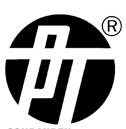
1979
The strategy of diversification was continued with the inclusion of a plastic injection moulding company, where technical moulding, fastening elements in the combination plastic / metal, are produced. At the end of the 1970s this product range is expanded
01 >> 2022 EJOT moment 14
>>Text: Heinrich-Georg Homrighausen
MARKET UNIT INDUSTRY
The environment in which you find yourself undoubtedly plays a major role. In a country with high social standards and a remarkable tax burden, it is difficult to imagine being a price leader and being economically successful at the same time.
Of course, there are other directions to choose from at the “decision crossroads” described above. The middle ground, for example, where you can choose a little bit of everything. Perhaps one saves on the training of the team, or even on the quality of the materials and is then satisfied with an average end result. But the path of this “happy medium” is paved with well-known examples of failure, because of some properties, quality is mentioned here as the most concise, only the maximum is of interest to the customer.
Hans Werner Kocherscheidt stood at this crossroads after taking over the entrepreneurial responsibility from his uncle Adolf Böhl and decided to follow the “path of the best”. He found other allies willing to make the products, sales activities and manufacturing the best in the market. The consistent expansion of production at the highest level, the large number of own patents and innovative market ideas over the past decades illustrate this claim.
The strategy of this performance management can be described particularly impressively using the example of plastic direct fastening. Plastics were used in more and more products because, in many respects, they were superior to the traditional materials. Those responsible at EJOT not only noticed the market development, but also the fact that users were often content with compromises when it came to fastening solutions. It was not uncommon for the screw connections to come loose as a result of thermal and mechanical loads, or the so-called plastic tubes failed as soon as they were fastened.
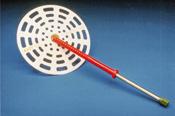
It took many thousands of manufacturing and screwing tests to determine the best possible thread form with the relevant fastening parameters for the different plastic materials. However, the result of this time-consuming and costly development process has given EJOT a strong impetus for today’s market position. In all modesty, it may also be mentioned here that the essential details of the original PT® screw served as a template for many competitive solutions and is still a very common and successful thread form on the market today.
It was also successful because the marketing strategy was further developed alongside the product launch. In addition to the well-known commissioned sales representations, more and more
EJOT engineers now visited the customers, often with degrees from renowned universities with a focus on plastics technology. It was their strategic task to competently advise the customer's developers and designers in the early phases of product development. Many years later, Hans Werner Kocherscheidt looked back with amusement on his decision for the engineers in the screw sales department, because some of his competitors initially ridiculed the idea and then envied him later.
In principle, the way to the top never ends, because the challenges on the market are always new. The latest generation of the plastic direct fasteners, the EVO PT®, is currently showing how, for example, digital tools can be used to map the behaviour and effect of the fastening elements on the customer's components under different load cases and derive corresponding recommendations for dimensioning from this.

A few years ago, the entrepreneur and consultant Dr. Christoph Weiß titled his guide book for entrepreneurs “Doomed to Excellence” (published by Unternehmer Medien, Bonn). Presumably, he wanted to express that once you’ve decided to lead in performance, there’s no turning back. It is put quite provocatively, but still describes the situation at EJOT realistically. The decision for the best products and the best service has been made and customers can rest assured that it will remain so in the future. E
1980
In this sector,
The year was marked by a number of conversions, including the rebuilding of the head office in Berghausen and the construction of a new hardening plant at Bienhecke in Laasphe. The photo shows the shipping department in Laasphe.

EJOT moment 01 >> 2022 15
by elements for the fastening of insulating elements to thermal insulation in house construction.
EJOT develops into the market leader in Germany
Market Unit Industry –much more than just screws
Closeness to customers and their needs is a key success factor for the Market Unit Industry. This close coordination is one of the foundations for the development of an ideal fastening technology solution.
1982

EJOT acquires the company Timper with a turning shop in Laasphe – with the aim of improving the machining operations and the associated knowhow. Powder metallurgy is outsourced there.

1983
“EJOT” is introduced as the new company name and a new logo is presented
1984
Separation of the construction screw department and foundation of EJOT Baubefestigungen GmbH. The origin of the distribution of construction screws is at “Untere Bienhecke” in Bad Laasphe. Sales team, finished goods warehouse and part of the production leaves the parent company facilities and moves to the plant acquired in 1983 at Stockwiese in Bad Laasphe.
01 >> 2022 EJOT moment 16
MARKET UNIT INDUSTRY
>>Text: Andreas Blecher
Essential for this is a broad product portfolio from which the customer can draw in order to be able to implement his specific requirements in the best possible way.
Direct fastening in plastic
Hardly any industrially manufactured component can do without plastics. Since the 1980s thermoplastic materials have experienced an unprecedented boom, in which EJOT participated from the beginning with the PT® screw (Plastic Thread). Previously, there had been no reliable fastening solution for plastics on the market. And the PT® family was continuously improved. In addition to enhanced fastening properties, the DELTA PT® was the
first self-tapping screw to enable predetermination of the screw joint using the DELTA CALC® prognosis program. The latest evolutionary stage in plastic direct fastening is the EVO PT® screw, which offers high standardization potential in production due to its special thread forming zone and also provides the user with FEM-supported component optimization. Special fasteners for foamed thermoplastics and thermoset materials complete the EJOT application range in the field of plastic direct fastening.
Direct fastening in metal
EJOT offers a wide portfolio of different fastening solutions for metal materials. What they all have in common is their self-tapping

1985
The first high rack warehouse is built at the Stockwiese site in Bad Laasphe. Due to the somewhat unusual façade design, the new building has also long been referred to as the "chipmunk".

1985
Foundation of the subsidiary Ecofast, Glasgow, today EJOT U.K. L.t.d., Leeds Sherburn-on-Elmet, GB
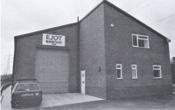
EJOT moment 01 >> 2022 17
1985
Acquisition of EJOT Festesystem

A/S, Oslo, Norway. Initially, only self-drilling and sealing screws are offered. In the following year, a 36-page catalog with an expanded range of construction products is already published
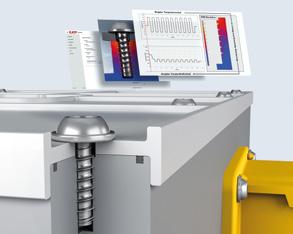
1986
Relocation of the Construction Fasteners branch office in Unna, founded in 1978, to the new building. Thanks to an advantageous location close to several highways, customers can be served faster.
capability, which offers economic advantages in industrial assembly because, compared with metric screws, there is no need for time-consuming part preparation and the number of work steps can be reduced. For example the ALtracs® Plus screw, which is specially designed for light alloys and other non-ferrous metals, can be fastened directly into the cast hole of transmission housings or steering columns. For applications with the ALtracs® Plus screw, the ALtra CALC® prognosis program provides further valuable support, and FEM-supported component design is also possible. The self-tapping SHEETtracs® screw is most suitable for the process-reliable assembly of pre-punched thin sheet joints. A typical application for the SHEETtracs® screw is fastening of housing walls of washing machines or dryers. And for direct fastening into thicker steel materials, the Spiralform® screw guarantees a secure and long-lasting connection.
Fastening technology for composite and lightweight design
Lightweight and composite design is continuously being integrated into almost all components of future vehicles. Auto body construction in particular is characterized by a wide range of materials used. If, in addition to one-sided accessibility during assembly, the removability of the fastener is also important, the flow drilling FDS® screw is the fastener of choice. The screw fastens steel sheets and aluminium without the need of a pilot hole and with exceptional quality. The FDS® screw is constantly being further developed; for example, a version with a special sealing function is used for fastening battery systems of electric vehicles. Another option for joining different materials and semi-finished goods is the so-called EJOWELD® “friction welding”. This innovative development now provides the option to join composite designs, in particular lightweight materials and ultra high-strength steels, with a friction element installation tool suitable for robots. With EJOWELD® the joining process is fast, automated, high strength and reproducible.
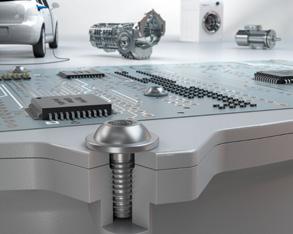
Fasteners for foam and sandwich structures
EPP (expanded polypropylene) foams are often used in applications that need to be as light as possible or that have to absorb large amounts of energy in a very short time in an emergency, such as crash pads in car door modules. EJOT® EPPsys is a product group specially designed for connections in this material.
1986
EJOT participates for the first time in the construction trade show "Roof and Wall". This leading trade fair for the roofing trade is held every two years.
01 >> 2022 EJOT moment 18
MARKET UNIT INDUSTRY
1987
Foundation of EJOT France S.A.R.L., Villé, France (5 employees). Two main reasons were in favor of the location in Alsace: First, the location halfway between the industrial centers of Lyon and Paris, and second, the bilingualism as an advantage in communication.

These plastic fasteners can be screwed directly into the foam. Going one step further, the EPPsys RSD friction weld dome is inserted directly into the EPP foam using the friction welding process, bonding with the molten material. A similar process is also used by the TSSD® thermal adhesive bonding boss, which penetrates the component by means of rotation and the associated heat input and creates a positive-locking connection. In addition to rear window shelfs and loading floors from the automotive sector, the application portfolio also includes the sandwich and honeycomb structures frequently used in aviation, in which the TSSD® can be used to set fixing points in the aircraft galley, lavatory or baggage racks.
1987
Acquisition of the TORX® license



1987
The operational suggestion and recommendation scheme is introduced. An important innovation, which over the decades has led to permanent improvements in everyday production. Employees whose suggestions are acknowledged receive a “reward.”
EJOT moment 01 >> 2022 19
Fastening solutions for the micro range


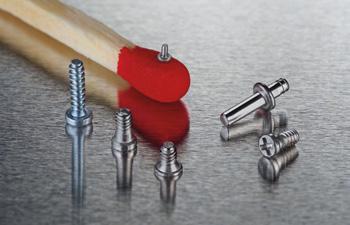
The trend toward miniaturisation of components continues across all industries. “Smaller, lighter, more efficient” is also the demand on the fastening technology. With the self-tapping EJOT micro screws significant weight and costs savings can be realised even in the smallest installation space. They have all the advantages of the larger dimensions and, due to their tight fitting thread, achieve high mechanical strength even in difficult installation situations. Due to their self-tapping geometry inserts are unnecessary. In the final assembly of components the EJOT micro screws can be used flexibly. This ranges from manual assembly to automated serial assembly, which is already standard in the numerous industrial micro applications. The field of applications for micro screws is wide. It ranges from small housings that need to be fastened, for example sensors in radar systems or rearview cameras in modern cars, to circuit board screw connections in the sound processor of a cochlear implant.
Individual precision cold-formed parts
The variety of possible applications for cold-formed parts made of steel, aluminium or copper is virtually unlimited. The EJOFORM® cold formed parts are always tailored to the customer's specific
application. They fulfill a wide variety of functions, for example as a bracket, stop bolt, spacer and contact sleeve, adjusting element or safety-relevant component in braking systems. The individual products are manufactured in a multi-stage cold-forming process. With this technology, a wire section is formed into a complex cold forming part over several forming steps. Individual finishing steps and refinements are then possible, for example machining or coating. In many customer applications, this means that instead of several parts having to be assembled to form a complete functional part, only one EJOFORM® part is used. Particularly in comparison to turned parts with a great deal of material input, the customer also benefits from the economic advantages of this manufacturing process, which become greater the higher the production quantity and thus the material savings.
Hybrid parts and components
EJOSYST® is the term for individually developed functional components made by EJOT. In customer applications, these parts can take on a wide range of functions, such as compensating for manufacturing tolerances or thermally induced length changes, fastening, positioning, sealing or even transferring motion and torques. Various sized headlamp adjustment systems are also part of the EJOSYST® portfolio. Both manual and motorised adjustments are possible. The range of applications includes a wide variety of lighting systems such as halogen, LED or laser applications in cars and trucks. EJOSYST® products are based on plastic injection molding and cold forming technologies. Focus of the development is always the individual solution for customer-specific requirements. The assemblies are found, for example, in electronic parking brakes, car seat adjusters or in the onboard electronics of electric vehicles.
Functional plastic parts
In the field of functional plastic parts, EJOT develops and produces high-precision metal-plastic composite parts using insert
1988
1987
The first international PT ® license meeting is held in Cologne. These meetings serve as a mutual exchange of information on both market developments and technical innovations.
1988
Foundation of the Joint Venture Hi-Tec Fasteners, Haslev, Denmark. Hi-Tec Fasteners is founded as a joint venture between EJOT Verbindungstechnik and Vereinigte Schraubenwerke. Initially, the focus is on the sale of industrial products, followed a few years later by the sale of construction products.
The first fastening laboratory, APPLITEC, is built at Bienhecke in Bad Laasphe. The beginnings date back to 1980, when Stephan Weitzel developed a test stand for component testing.
01 >> 2022 EJOT moment 20
MARKET UNIT INDUSTRY
technology. After a detailed observation and analysis of the customer's requirements, a product that can be implemented in terms of production technology is developed in close project coordination. This product is then transferred into a defined process flow and can be produced at the various EJOT locations worldwide. High-performance thermoplastic materials are used, which are manufactured in a single-stage production process without pre-molding. Housings for sensors and driver assistance systems as well as covers and housings with direct insert moulded metal contacts are the main focus of the product portfolio. The components meet the highest demands in terms of dimensional accuracy, dimensional stability, load-bearing capacity, tightness and appearance – even in constantly changing, demanding areas of application. E


1989
Foundation of the joint venture EJOT & Avdel System AB –together with the renowned blind rivet manufacturer Avdel. The official inauguration takes place in 1990.



1990
The first issue of the company magazine “WirVerbinder” is produced. To this day, the "Verbinder," as it is commonly known, is printed four times a year. Acceptance of the magazine among the employees is high. The picture shows the title page of the first edition.
EJOT moment 01 >> 2022 21
Highest quality –sustainable
In the Construction market unit, global quality leadership in the Building Fasteners and ETICS Fasteners customer segments
Of course, this also applies to the “Distribution” customer segment that was newly created at the beginning of 2022.
“Highest quality – but also sustainable,” one would add today, even if the topic of sustainability is not a trend that came about only recently. Quality and sustainability are by no means contradictory. They are the basis for many innovative products and further developments. With numerous business areas, the Construction market unit is much broader than its well-known competitors. “Everything from a single source” is the customer-friendly idea behind it, which includes not only high-quality application solutions, but also comprehensive services.
In the Building Fasteners area, the original concentration on fastening solutions for the building envelope of industrial buildings (industrial lightweight construction (ILB), flat roof (FLD) and rainscreens (VHF)) was initially supplemented by applications for solar, window and glass facade technology (FGF). Timber as a material has been noticeably gaining in importance for industrial buildings for years, so that EJOT Construction is also taking up this challenge. Especially since the other young business field of anchoring technology is full of synergy effects for timber construction and rainscreens.
The inclusion of synergy effects and the system concept with a view to the big picture are particularly important in the Construction market unit. In the future, we want to not only supply high-quality connecting and fastening elements, but also offer our customers comprehensive and holistic systems.
This system concept also requires a fundamental rethinking in sales, because in the system concept this takes place exclusively as a project business. The focus here is on planners and architects in particular – an important task especially for sales engineers.
“Everything from a single supplier” also means that the business activities of the Construction market unit is by no means limited to products. Service related to the application of the products plays a central role, from the pre-dimensioning to the pull-out test on the construction site to the rental or sale of self-developed setting or assembly devices and the offer of software tools such as ANCHOR FIX (a new and convenient dimensioning software for anchoring products) or the ETICS product configurator.
By definition, an external thermal insulation composite system (ETICS) is related to ecology and sustainability. The high-quality products of the customer segment ETICS are sold exclusively through system providers. This ensures that all components in the system work together. In Europe, EJOT is the industry leader in the field of ETICS anchors with many unique selling points. The ISO family for fastening attachments provides additional products that help to improve the overall performance of an external thermal insulation composite system. The ISO-Bar ECO for greening ETICS facades takes the ecological idea into account in a special way. Profiles for all applications complete the ETICS range.
1990
In January 1990, the construction of the 2800 square meter hall at Bienhecke in Bad Laasphe is completed. The setup of the storage space and the EJOMAT department follows. In addition to the shipping, packaging and final inspection departments, space is also created for a new electroplating shop.

1990
The circle of licensees is expanded: in February 1990, the company Camcar receives the PT® license. Camcar is a company of the American Textron Group, Illinois/USA.

01 >> 2022 EJOT moment 22
MARKET UNIT CONSTRUCTION
>>Text: Jutta Rathmann
was and is the driver behind all developments.
How sustainable are EJOT's ETICS and Building Fasteners products really? In the Construction market unit, improvements are constantly being made, like the use of recycled or bio-based plastic. With EPDs (Environmental Product Declarations) which were obtained on a voluntary basis, Construction already enables its customers to objectively evaluate the product-specific carbon footprint.

Being an industry leader, remaining innovative and actively shaping the future – this includes getting involved in committees, boards and trade associations in the construction industry. This is how trends are set and product developments are designed at an early stage – corresponding to the market development of designs and systems. E
1990
Introduction of the TQM organization with various quality circles The aim of this new quality approach is for all employees to discuss and implement improvements in their respective areas of work in various
quality circles. The abbreviation TQM stands for "Total Quality Management" - the model originates from the Japanese automotive industry.
1990
The first construction fasteners catalog is published after five months of intensive work on concept, text and graphics. A new edition is planned every year.

EJOT moment 01 >> 2022 23
EJOT Iso-Bar ECO application
Professional applications for the building envelope
The EJOT Market Unit Construction caters to selected segments of the building industry with professional applications on facades and for the interior construction of buildings. EJOT offers a wide product range, special fastening know-how and customer-specific service in the different core segments.
Industrial Lightweight Construction
This core segment focuses on innovative fastening elements for attaching trapezoidal profiles and sandwich panels to structures made of steel and wood. The classic product in this area is the self-drilling screw JT3-2H-Plus-5.5. For years, it has been an integral part of the EJOT core business.
The optimised and unique tip geometry of the new EJOFAST® Plus self-drilling screws enables safer application to the surface thanks to the even more finely shaped tip. Displacement or slipping is almost impossible. At the same time, the load-bearing capacity values were improved once again. The slim, single-start threaded drill point produces no sharp-edged swarf that gets stuck in the material and require time-consuming removal.
With the new self-tapping screw JZ5-6.3, EJOT offers a twosteel self-tapping screw with a hardened thread-forming zone, which is characterised by a particularly high level of process reliability when thread-forming. It is the strongest EJOT screw on the market so far. Self-tapping screws, also known as thread-forming screws, do not have a drill point. In a preceding work step, a through hole is created. However, the thread is formed automatically when the screw is then tapped in, eliminating the need for work steps and other tools such as tap drills or additional fastening elements such as washers and nuts. Self-tapping screws are mainly used for particularly thick or high-strength steels, where self-drilling screws reach their process limits.

Timber construction
The goal of the Market Unit Construction is to be able to offer solutions for all building areas in which fastening elements are required. It is therefore a logical consequence to include products for timber construction in the portfolio.
Whether for fastening above-rafter insulation, in stair construction or interior construction – T-FAST® wood screws are ideal for the fastening of wooden components in structural and non-structural timber construction.
With the T-FAST® series, EJOT offers a range of zinc-plated wood screws that are regulated by ETA-18/0812 and correspondingly CE-marked. The wood screws with partial thread enable strong contraction and firm connection of the wooden components with rapid work progress. They can be installed in areas that are not weather exposed or in usage classes 1 and 2 according to EC5.

1990
The new electroplating shop, including the wastewater treatment plant, is opened at Bienhecke in Bad Laasphe with an open house day. The plant is the latest state of the art.
1991
In order to cover the expected demand for fasteners in the new German states, the Dresden branch is founded.


01 >> 2022 EJOT moment 24
MARKET UNIT CONSTRUCTION
>>Text: Katrin Strübe
EJOFAST® self-tapping screw JZ5-6.3
EJOT® self-drilling screw JT3-2H-Plus-5.5
Rear Ventilated Facades
The rear-ventilated facade offers great design freedom and versatility. EJOT is a system provider and reliable partner in this area. The various system components, services and comprehensive advice lead to a homogeneous but individual solution.

Our award-winning CROSSFIX® substructure system is a revolution in rear-ventilated curtain wall construction. It is the first stainless steel substructure that can be equally used for horizontal and vertical support profiles. The use of 100 percent stainless steel significantly reduces the thermal bridge allowance in the system. CROSSFIX® increases the flexibility, facilitates assembly and simultaneously reduces storage costs. The system has an ETA rating, which reduces the amount of planning, creates cost certainty and saves time and money.



1991
Construction work at “In der Aue” location: On the former site of the DAXOROL company, the new site in Bad Lassphe is built on an area of 18,000 m2. There is already a 4,000 m2 hall built by the previous owner in 1967.
1991
A new rotary retort furnace with integrated washing system and tempering oven is installed in the hardening shop at Bienhecke in Bad Laasphe. The entire furnace is equipped with an automatic temperature system, and the master computer can control the temperature in five separate heating zones.

EJOT moment 01 >> 2022 25
T-FAST® wood screw JW2-STS-8.0xL
Horizontal assembly of the CROSSFIX® system
Mounted CROSSFIX® system with self-drilling screws
The JT4-LT-XT-3H self-drilling screw is ideal for fastening flat aluminium composite panels to aluminium substructures. A VARIO self-drilling screw is used for pre-punched stainless steel or aluminium wall brackets on aluminium support profiles or to form sliding and fixed points on substructures. Another indispensable classic in the EJOT rear-ventilated facade portfolio is the insulation support anchor DH for fastening insulating materials to all substrates.
Flat roof
In flat roofing the focus is on fasteners and installation tools for the efficient attachment of insulation and waterproofing membranes to flat roofs and slightly sloping roofs. Depending on the substrate there are different fastening materials available,
The core product in the flat roofing area is the HTK-2G tube washer in connection with our roofing screw (Dabo®) TKR/TKE for securing roofing membranes on substructures made of steel trapezoidal profile, wood and wood-based materials. Both products are available in numerous lengths for a wide range of requirements.

The JBS-R/EcoTek combination of a tube washer and a concrete screw is ideally suited for installing gradient insulation on concrete.

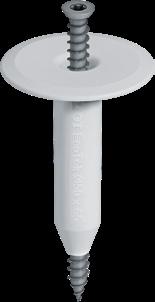
In addition to product development and the optimisation of materials and manufacturing processes in the flat roof area, cooperation with manufacturers of roofing membranes and system tests are particularly important.
Industrial window and facade technology

The window and glass facade technology area deals with high-quality fastening elements for window and door production and their assembly. The portfolio also includes fasteners for use in aluminium/glass facade systems. Also in this business field the product development focuses on more and more complex window constructions. The most essential difference of this field in comparison to the above mentioned fields is the industrial application of the products, for example by automated fastening. The EJOT frame anchor is our fastening solution for window and door assembly. Our frame anchors have proof of burglary-resistant installation according to RC 2 and have also been tested as
1991
Due to the increased number of employees and the ever more complex labor, collective bargaining, tax and social security regulations, automatic time recording is introduced. The traditional time card is replaced by a “plastic ID card”.
1991
The computer-aided quality assurance system “CAQ” will be used in the new factory building at the “In der Aue” site and will automate the previously manual statistical process control (SPC).
1991
Outsourcing of powder metallurgy to Schunk EJOT Metallurgie, Heuchelheim. After 20 years, this business unit is outsourced again, as this technology has nothing in common with the main activities of the Industrial Fasteners Division.
01 >> 2022 EJOT moment 26
MARKET UNIT CONSTRUCTION
EJOT Dabo ® screw TKR-4.8 with HTK2G disc washer
EJOT concrete screw JBS-R with EcoTek stress plate
Direct fastening of windows with the EJOT® frame anchor
fastening elements according to the ETB guideline “Components that protect against falls from heights”.
Fastening systems for solar installations
EJOT offers a large number of high-quality fastening solutions for the correct and secure fastening of solar installations. The product portfolio includes approved fasteners for the assembly of photovoltaic installations on the roof as well as for the assembly of the installations on open spaces.
In the solar business the EJOT Solar Fastenings are the core product. Depending on the requirements for special applications, further fasteners have been developed in the solar business, which usefully supplement the existing EJOT standard range. The EJOFAST® screw JF3-2-5.5x25 is often used in the solar sector for reduced swarf fastening. Due to the reduced formation of drilling chips, the risk of corrosion is minimised and cleaning work is no longer necessary. The material displacement during the assembly process also ensures increased load-carrying capacity. The screw can be used in many ways, e.g. for the


direct attachment of support profiles or for connecting individual assembly components.
Metal and chemical anchors
The fields of application for metal and chemical anchoring technology are versatile, and the respective requirements for the fastening solutions are just as different. Whether for fastening balcony or stair railings or for installing large machines – EJOT products ensure safety and always have high load-bearing capacity values.
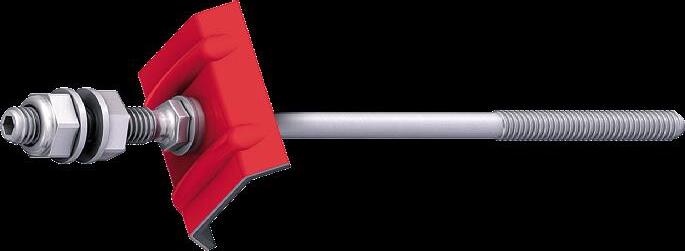
The broad product portfolio includes solutions for mechanical installation in non-cracked and cracked concrete as well as chemical and thus expansion pressure-free products for heavy-duty
1992


EJOT moment 01 >> 2022 27
EJOT® Solar Fastener
Through bolt BA-E Plus Concrete screw JC2-KB Plus
Move into the second production site in Bad Laasphe (“In der Aue” plant) and start of production in the converted plant.
1992
Expansion at EJOT Construction Fasteners. As a result of the removal of the powder metallurgy department, the Stockwiese site in Bad Laasphe can be expanded. The areas of shipping and packaging are moved.
fastening in concrete and masonry – so that your projects will be a success.
External Thermal Insulation Composite Systems (ETICS)
EJOT offers comprehensive system accessories for External Thermal Insulation Composite Systems in the areas of anchors, mounting elements and profiles. Together with the cross-segment 360° service, this results in a complete offer tailored to the needs of our partners. Only available from EJOT.
Anchors
The range includes special anchors for fixing insulation in external wall insulation systems.

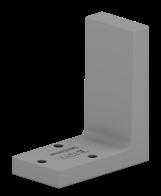

The ejotherm® STR U screw anchor has been the absolute master product in this business area for many years, thanks to its countersunk installation to avoid anchor marks on the facade and its universal field of application. But existing products are also continuously developed at EJOT. The STR U 2G has recently been supplemented with the possibility of use in insulated ceiling soffits. With the all-rounder ejotherm® STR U 2G, EJOT is the only anchor manufacturer to offer approval-compliant solutions for all areas of application in ETICS. In addition, the product segment was expanded to include another specialist: the ejotherm® S1 short was specially developed for the use of particularly thin insulation boards. It impresses with a short under-head area and a short installation depth. The innovative ejotherm S1 tool enables an optimal setting position and a high level of assembly comfort
Mounting elements
EJOT offers a wide portfolio of mounting elements for securely fastening attachments to external thermal insulation composite systems.
With the Iso Team, EJOT has compiled a product group for the planned and subsequent fastening of attachments to ETICS facades which offers a solution to all fastening problems. For all products in the business area, the focus is on thermal bridge-optimised embedment and reliable sealing to protect against the ingress of moisture. The EJOT Iso-Corner mounting bracket for the planned fastening of, for example, French balconies to floor-to-ceiling windows reduces thermal bridges through thermal decoupling and therefore offers real added value compared to conventional steel solutions. In addition, the product was the first mounting element

1992
New construction of the Engineered Plastic Components plant in Berghausen: The expansion, which is divided into four sections, is completed in 1992. A fire-protected tool store, an anchor testing room on the first floor and offices on the upper floor are built.

1992
Open house day at the In der Aue site in Bad Laasphe with the official inauguration of the new location with all employees and numerous guests. Particularly noteworthy are the large paintings made by architecture students of TH Darmstadt university that are hung in the plant.

01 >> 2022 EJOT moment 28
MARKET UNIT CONSTRUCTION ejotherm ® S1 ejotherm ® STR U EJOT Iso-Corner Iso-Bar ECO
for attachments on the German market to receive zero carbon house certification. The EJOT Iso-Bar is the right choice for subsequent and therefore particularly flexible fastening of marquees, for example. Its material enables a low thermal bridge effect with a high bearing load at the same time. Thanks to the supplied seal, it permanently seals the facade against the ingress of moisture. The product range is completed with the EJOT Iso-Bar ECO, a thermally separated fastening element for subsequent and therefore flexible fastening on thermally insulated facades. This product, which won the DETAIL Product Award, is based on the EJOT IsoBar and enables the flexible and user-friendly installation of cable systems for facade greening in connection with all the known advantages.
Profiles
With the EJOT ® Pro-Line profiles, EJOT offers profiles for high-quality plaster connections. EJOT Pro-Line profiles are ideal for precise edge formation, for permanently driving rainproof, flexible component connections in ETIC systems and
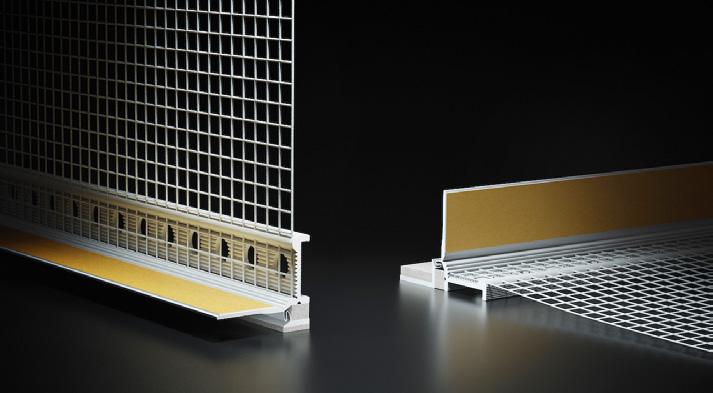
much more. Reveal beads with mesh represent the transition between the facade surface and building openings such as windows and doors. Different movements of the plaster shell and the window occur at these transitions, for example due to temperature-related effects. These movements have to be taken up by the reveal beads with mesh in order to enable a permanent, driving rain-tight connection of the components. The membrane technology of the EJOT Pro-Line Giga Flex profiles enables an even better three-dimensional movement for the highest requirements, e.g. for windows built into the insulating material or with large windows. The new Giga Flex slim reveal bead with mesh impresses with its narrow construction width of 7 mm and the resulting wide range of applications with simultaneous high movement absorption. The same applies to the roller shutter connection profile RAP Giga Flex slim. It ensures a uniform plaster application even with thin and medium-layer systems. Another plus point: flush mounting on the roller shutter guide rail is now even easier thanks to the stop leg. E
1993
Change of the company names to EJOT Engineered Plastic Components (EJOT Kunststofftechnik GmbH & Co. KG) and EJOT Industrial Fasteners (EJOT Verbindungstechnik GmbH & Co. KG).
1993
EJOT acquires part of the Tambach GmbH screw factory in Thuringia. The contract with the Treuhandanstalt is signed shortly before the turn of the year. This marks the beginning of an exciting new era for EJOT. With the expansion, EJOT becomes the European market leader for thread forming screws overnight.

EJOT moment 01 >> 2022 29
Reveal bead with mesh Giga Flex slim (left) and roller shutter connection profile Giga Flex slim (right)
From nail to functional part
Starting in the “nail shop ” in the small village of Berghausen, EJOT has developed into a globally competitive company with 3,980 employees and more than 22,000 products. But how exactly did the variety of products develop in the field of cold forming?
The year 1922: Adolf Böhl starts the production of nails in Berghausen. Simple forming consisting of a punch and a die-plate is sufficient for classic nail production. The base material is drawn into the machine by straightening rollers and cut off by means of a shearing blade. The wire section is then transferred to a stationary die-plate. The nail head is formed by the forward stroke of the punch.
The production of a simple screw geometry cannot usually be realised with just one forming blow. For a Torx or Phillips drive, for example, another forming step must be taken into account with the so-called two-blow heading process (1 die-plate + 2 blows). The thread of a screw is formed by the thread-rolling machine. In the last step, the screw undergoes a hardening process and surface protection through electroplating. Over the years, EJOT has

1993
The growth of the EJOT Group makes it necessary to provide larger premises at the Berghausen site also for the administrative area. For the areas of accounting, financial accounting, human resources and EDP more offices are planned in an annex to the existing building.
1993
Foundation of the sales office EJOT CZ s.r.o, Prague, Czech Republic
The initial focus is on the construction sector, where a warehouse is also to be set up as quickly as possible so that customers can be supplied from there. Sales for industrial products are to follow subsequently.

01 >> 2022 EJOT moment 30
>>Text: Dr. Dominik Wick
TECHNOLOGY
developed into a world market leader in screw manufacturing. A major milestone dates back to 1977. The invention of the EJOT PT ® screw, self-tapping fasteners for thermoplastics, which are usually manufactured with the “double-blow headers”.


With larger screw heads and smaller shank diameters, the twoblow heading process reaches its limits and further blow forming is required. The headed blank for this type of screw can then be manufactured using the 2-die, 3-blow process. In the first step, an extrusion is formed, with the diameter being reduced to the shank diameter. The head shape is produced by pre- and final header dies. Further process stages such as thread-rolling, hardening and electroplating arise according to the customer requirement.
As the complexity of the parts increases, multi-stage heading technology with up to seven forming stages is used. The parts often have no thread geometry, so the designation “functional part” is used here. A quick look at the pictured functional parts shows that extruding, piercing, bevelling and deburring processes are necessary for production. For sharp edges, undercuts, drill holes and tighter tolerances, multi-stage machining technology is gaining in importance, which can also be used to remove burrs and flitters.
Just looking at the product development in the field of cold forming, the quick adjustment to new customer requirements such as e-mobility (especially copper parts), it is obvious how well EJOT is positioned and how well it can meet the requirements of the market.
1994

Open house day at the company in
After an unprecedented feat of reconstruction, an excellent opportunity to introduce the company to the population in the region.
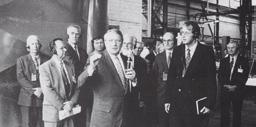
E
Tambach-Dietharz.
Quality remains a prerequisite for success

EJOT ® The Quality Connection. This is the premise that EJOT has set for itself and which each of the more than 3,900 employees stands behind. This is also appreciated by EJOT’s customers and partners. The last few years have been extraordinarily successful, despite all the crises that we have overcome together and that continue to challenge us.
1994
EJOT in Türkiye: The new sales office in Istanbul with two employees, takes care of customers of the large suppliers such as Bosch and Siemens as well as some automotive manufacturers.
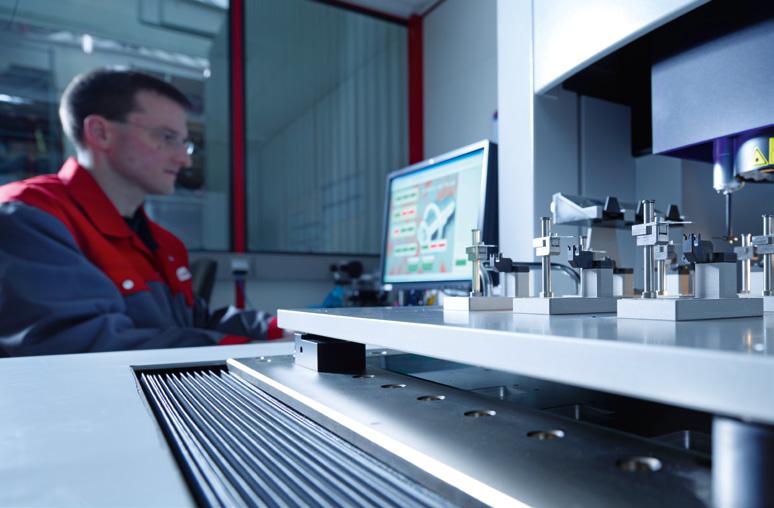
1994
EJOT is certified according to the quality assurance system DIN ISO 9001. The organizational and quality assurance system that has been in place for years is thus officially confirmed. The quality philosophy was already initiated by the introduction of TQM and has been continuously developed.
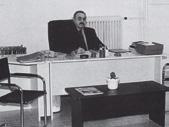
01 >> 2022 EJOT moment 32
>>Text: Michaela Klein-Schmidt
QUALITY MANAGEMENT
In the 75th anniversary issue, we explained how we implemented the “path to central quality assurance” and thus ensured steady growth at EJOT. 25 years later, we don’t “just have quality assurance”, we also deal centrally with quality management, and here EJOT is just as successful.
What does that mean? Classic quality assurance is essentially concerned with the requirements of the products and processes, so that at the end of the manufacturing process, the product that comes out is exactly as specified in drawings and standards and what is expected by the customer. The quality management system is practically the set of rules, the guidelines, the framework and it provides specifications, process descriptions and templates.
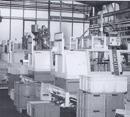
Especially in industry and the automotive sector, the requirements have become even greater: here EJOT faces standards and norms such as ISO 9001 or IATF 16949, with fulfilment of the requirements. To support decision-making, quality management determines key figures for the evaluation of processes. On this basis, measures are introduced that meet the quality requirement and ensure the continuous improvement of products.
The task for the future is to further expand this constant quality improvement in order to be prepared for changing market situations and to meet the high demands our customers and partners place on the EJOT Group. We also think outside the box. We can further strengthen our market position with connection solutions for the aviation industry. Here we are examining the requirements placed on our QM system.
An important aspect is that we develop ourselves, train staff in the area of quality, build up the so-called learning effect in the whole group and support each other across locations. Standardisation in the quality department, such as the harmonisation of process descriptions, test procedures, evaluations and reporting is also part of this – in cooperation with other departments and locations. This is not new, but we see even more potential here.
We make use of the know-how of our colleagues at the other locations and take advantage of the “fresh” and unbiased view from the outside, so that solutions are also worked out together here. We will expand on this with our internal audits, with central and detailed QM methods such as test procedures, measuring equipment, etc.
The next steps are logical. Based on our “lessons learned”, we are standardising our processes and manufacturing solutions in the areas of QA and QM step by step.

1995
1995
Acquisition
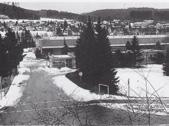
EJOT moment 01 >> 2022 33
E 3D measuring machine
Remodeling work is completed at the Berghausen site. In the production hall, the two-die / three-blow headers originating from Tambach are installed, and in the Engineered Plastic Components area the entire injection molding production will be redesigned.
of the new production and shipping site in Bad Berleburg EJOT buys the 50.000 m2 property of the Thielmann company, which had abandoned the site after a fire. The existing buildings on site are a 12,000 m2 hall, an office building, and changing and social rooms.
Consequent use of digitilization opportunities
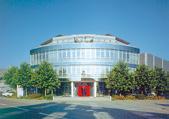
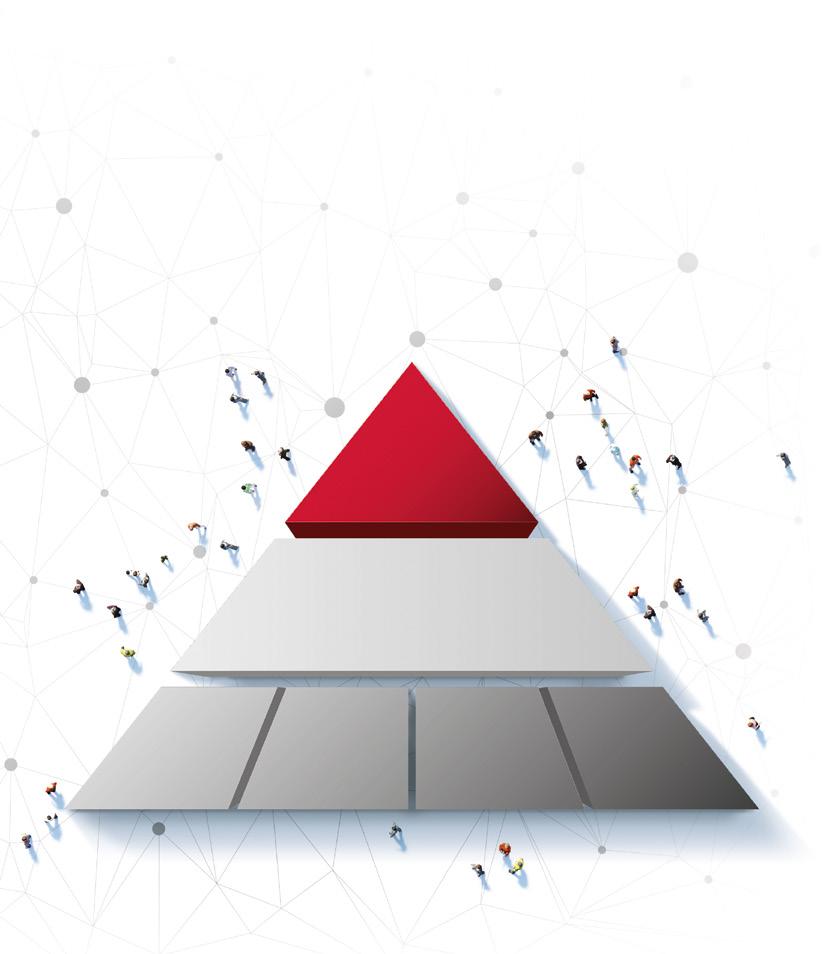
A production machine stops and sends a warning to the smartphone of the operator in charge: “My tool is showing increased wear and reporting a defect”. The operator, an experienced colleague with many years of experience in the production process, thinks to himself: “Yes, I expected that too.”
In April, the EJOT Group takes over 70 percent of the Lista Group in Dozwil/Switzerland and operates under the name EJOT Kunststofftechnik Dozwil AG The product lines include technical plastic parts for industrial applications as well as filing systems for office use and containers for tool storage. On a production area of 10,000 m2, 28 injection molding machines are used.
1996
Foundation of the joint venture ASYST Technologies L.L.C., Lincolnwood, IL, now Kenosha, EJOT Engineered Plastic Components now also in the “New World”: On April 30, 1996, the shareholders’ agreement of the newly founded “ASYST Technologies, LLC” is signed in Chicago. ASYST is a joint venture between EJOT Holding and the owners of the American licensee Accurate
01 >> 2022 EJOT moment 34
>>Text: Andreas Fey
EJOT Vision and Mission Statement Digitilization Vision and Mission Statement Digitilization Strategy Company 4.0 Product and Service Innovation Customer experience People, culture and leadership DIGITILIZATION 1995
This is how one of the visions of digitalization at EJOT can be vividly described. Located in the field of artificial intelligence (AI) it has the task of collecting data during production and using this data basis to provide information on the current state of the machine and the quality of the finished part. In the event of faults or emerging defects, the machine should independently make an adjustment or stop and inform the operator. If this does not occur, there is a risk that minor wear in the tool will remain undetected for a long time and meanwhile time and energy will be invested in faulty and unusable parts that will eventually have to be scrapped. This can be avoided through permanent data control and evaluation. This increases efficiency and conserves valuable resources.
The team that deals with production data and its analysis at EJOT, including artificial intelligence, is currently being set up. The first milestones with the creation of a database have been reached, but a great deal of fine tuning still lies ahead of us. Compared to building a house, the planners have completed the (data) architecture and the statics, the solid foundation is in place and the first rooms have been bricked. These rooms are being used for the first time and it is becoming apparent that it will be a good building. It is becoming increasingly clear how the finished building will be used in the future.
In the example described at the beginning, the intelligence of the machine will not replace humans, but support them. This is especially important when our experienced colleagues are leaving the company for retirement and it is becoming increasingly difficult to find qualified junior staff. The fact that the use of digitalization should support people in their work is one of the core aspects of the digitalization mission statement at EJOT. It is a fundamental principle that digitalization at EJOT is oriented towards people.
There was no clear roadmap when EJOT began to work intensively on developing a digitalization strategy. The process, which was intensified in 2016, was entitled “Opportunities through Digitalization” and was intended to send a clear signal: digitalization has a positive connotation, for the benefit of employees and customers.
Industry 4.0 was the hot topic in production companies at the time, including EJOT. The project launched for this purpose tried to initiate the right measures. Many things seemed sensible and useful, but clear prioritisation was not easy. It quickly became clear that a strategy was needed. Under the deliberately positive title “Opportunities through Digitalization”, a start was made on
anchoring digitilization in the company in a targeted manner. The digitilization vision and mission statement are derived from the company vision. Since these seem theoretical at first, a direct attempt was made to make the topic tangible with illustrative lighthouse projects. Digital lighthouse projects have an impact on the company and show that digitalization works and has a benefit.
The digitilization mission statement
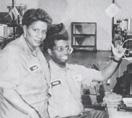
“At EJOT, we proactively shape digitilization partnerships. With curiosity, openness and a joy of experimenting, we digitilize products, services and processes all over the world in order to create the greatest benefit for our customers, our employees and EJOT. We develop innovative digital business models and set trends in our industries.”
In the category “People, Culture & Leadership”, the projects are related to the EJOT employees. One of these projects is the development of the EJOT employee app – as a milestone on the way to creating the flexible and modern working environment of the future. Today, all of EJOT’s 3,980 employees have the opportunity to access information and work together virtually via the communication and collaboration platform.
The alignment of digitilization with our customers is done through the projects in the categories of Customer Experience and Product and Service Innovations. EJOT stands for accessibility, knowhow and quality. With our internally developed digital services, we create tools that we make available to our customers online and around the clock. Whether with the ETICS configurator (External Thermal Insulation Composite System) to calculate the right anchor or with the CAE (Computer-aided Engineering) service tools to calculate the optimal connection with our industrial products.
The customer benefit always lies in being able to answer complex inquiries quickly. Through a very precise calculation, the exact number of anchors, for example, can be calculated. This prevents waste caused by ordering too many parts and thus leads to cost saving. E
Threads Fasteners (ATF). The name ASYST refers to the terms “assist” and “system” and is intended to express the fact that small assemblies, rather than individual parts, are produced and sold.
1996 EJOT takes on an important task in the industry association for the first time: Hans Werner Kocherscheidt is elected Vice Chairman of the German Screw Association (DSV).
1996
Relocation of EJOT Ecofast to the new site at Fox Way, Hunslet, Leeds, which offers better opportunities for further expansion in a newly developed industrial area.

EJOT moment 01 >> 2022 35
1996
Establishment of the sales subsidiary EJOT Hungária Kft, Ócsa, just outside the capital Budapest. Initially, it is only a small residential building with a warehouse. The warehouse includes the main products for the first start of the company.
1996

Between the old office building and the high rack warehouse of EJOT Baubefestigungen in Bad Laasphe, a new building wing is constructed in which meeting rooms and further offices are set up. In the back area


01 >> 2022 EJOT moment 36 LOGISTICS
SCM, purchasing and logistics now and in the future
What is EJOT doing to meet the challenges?
Especially during the pandemic, we have learned to act flexibly. We have also learned that flexibility is difficult to achieve in places with high complexity and a lack of transparency. Unfortunately, the supply chains have become more and more complex in recent years. They often span several continents, different modes of transport and information flows with system discontinuities. All of this can lead to vulnerabilities. Just think of the container ship EVER-GIVEN, stuck in the Suez Canal, the closure of ports and factories in China against the background of the ZeroCovid strategy, or the supply bottlenecks in semi-conductors due to the disruptions in the supply chains caused by the pandemic.
Flexibility and transparency in the supply chains
So we need to work on taking complexity out, for example from our supply chains, by optimising the number of partners and continents involved.
Transparency in the supply chains must also be increased. Knowing the status of a product through production and transport at any time in the supply chain is certainly still a dream of the future. Still, it doesn't seem unattainable. From our point of view, this is one of the exciting questions of the future.
How do we create transparency across different systems? Today we use our scheduling and planning system in the ERP environment. Each of our delivery partners does the same with their own
systems. Data exchange for orders takes place, if at all, via EDI. Unfortunately, this is often a dead end for information, because it does not provide any indication about the status of the order.
Strongly fluctuating delivery call-offs are a constant challenge for the system today. From backlogs in production to overflowing warehouses for finished goods, we have experienced everything in the last two years. That’s difficult to control. Ongoing digitisation can at least lead to more transparency and less time delay. That is what we are working on.
Perhaps blockchain technology can make a contribution here in the future to overcoming system breaks and exchanging information in a timely manner. We at EJOT believe in it. That is why we are working together with the Fraunhofer IML and three important suppliers to implement a pilot project in our supply chain.
Resilient Supply Chain
The last two years have shown how important stability and resistance are in the supply chain. We also refer to this as resilience. We will also have to deal with crises in the future. That's why we have to make our supply chains resilient, with the ability to adapt quickly and survive despite unforeseeable influences.
In order to be able to ensure this stability in the long term, we have to deal with risks. Who would have thought that a flooding
1996
is space for a workshop and a demonstration room. The old office building is redesigned so that it fits harmoniously into the overall appearance.
During routine maintenance work, which always takes place on weekends, a malfunction of a switch causes a fire in the electroplating shop in Bad Laasphe. The bath heating, which is not switched off as a result, sets fire to the container and later to the entire hall, which cannot be prevented even by the fire department.

EJOT moment 01 >> 2022 37
>>Text: Markus Rathmann
The crises of the last two years have shown how fragile supply chains can be in our time. Agility and flexibility are required, now and in the future.
1997
Foundation of EJOT Technika Mocowan Sp.z.o.o. Poland, in Kedzieryn-Kozle, approx. 150 km southeast of Opole, for the distribution of roofing and cladding products. Foundation of EJOT Tworzywa Sztuczne Sp.z.o.o for anchor production. The first anchor production plant in Poland was established in Ciasna. In 1998, 20 to 25 million insulation anchors will already be produced.
1997
Screw production, located at the Berghausen site in the so-called “screw hall”, moves to the new plant at Astenbergstrasse. The task is demanding because no production day can be lost, due to the good order situation. 19 headers, 40 roller, pinch pointing and special machines are moved.

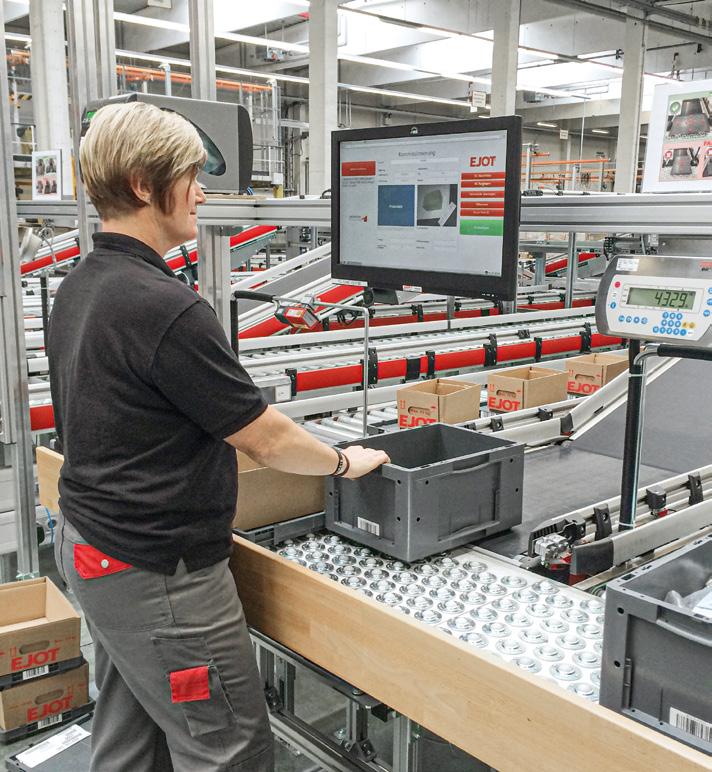
01 >> 2022 EJOT moment 38
LOGISTICS
The containers are automatically conveyed to the picking station area.
disaster like the one of summer 2021 would hit a region with Altena and Hagen, which is home to probably the largest cluster of European wire drawing plants, more or less shutting down important companies for weeks. The term “single sourcing”, which we consistently try to avoid on the purchasing side, must certainly be expanded in the future to include the geographical dimension and perhaps mean avoidance of “single region sourcing”.
But long supply chains spanning several partners and continents are also prone to disruption. For example, a product manufactured in Asia that is transported by sea to a European port and then transported by truck to its final destination may no longer be the blueprint for the future. Too many partners, too many disruptive influences, too much risk.
But our SCM processes can also be prone to failure, especially if they do not follow the defined standard. Here it is important to recognise already beaten tracks and create transparency. We rely on process mining. With the findings, we want to shape our administrative processes in an innovative yet robust way in the future.
Sustainability and Carbon Footprint
A major challenge for the SCM area lies in controlling the supply chain against the background of sustainability. Sustainability goes beyond CO2 reduction, even if climate friendliness is a central point. It is also about environmental protection in general, human rights and decent work conditions.
How sustainable are our supply chains today and how can we shape them in the future?

There are a few starting points for this. We want to work on this topic together with our suppliers and achieve improvements. First
of all, we have to create transparency. We will tackle this with a sustainability rating for all of our suppliers on a digital platform. We will then see where we stand, what progress we are making towards sustainability and where there are areas for action.
We certainly have a lot of leverage here in purchasing. In many companies, up to 80 percent of CO2 emissions are generated in the supply chain. At EJOT, too, this is a significant proportion. If we want to reduce it, we have to realign our supply chain along sustainable principles.
On the distribution logistics side, it’s about structuring our flow of goods worldwide in such a way that we generate the lowest possible CO2 emissions with an optimal level of delivery service. To this end, we have launched a project called Logistics Network 2025. Based on an analysis that we did together with the Fraunhofer IML in Dortmund, we want to redesign and optimise transport routes and warehouse turnover. Simply by designing the network correctly, CO2 savings of well over 30 percent can be achieved compared to the status quo.
Our goal is to emerge stronger from troubled times. We have had quite a few successes in the supply chains, but we still have a lot to improve, for example in sustainability. We will work on that together. E
1997
The electroplating shop is rebuilt in record time of only seven months. More than 50 individual trades had to be coordinated, which demands a high level of commitment and reliability from all those involved. One of the first measures is the complete enclosure with a weather protection hall.

1997
EJOT has its first website at www.ejot.de
The name has remained the same until today.

EJOT moment 01 >> 2022 39
www.e ot de www.ejot.de Webflow - The Ultima Wbfl Th Ulti bflo TheUltimat TheUltimatte CSS S Ge G S
Fully automatic conveyor technology optimises the material flows between warehouse and goods dispatch.
EJOT targets climate neutrality
The EJOT Group wants to become climate neutral by the year 2035, reducing CO 2 e emissions from 188,400 tons to net-zero. An ambitious goal that the family-owned company has set itself in its 100th anniversary year.
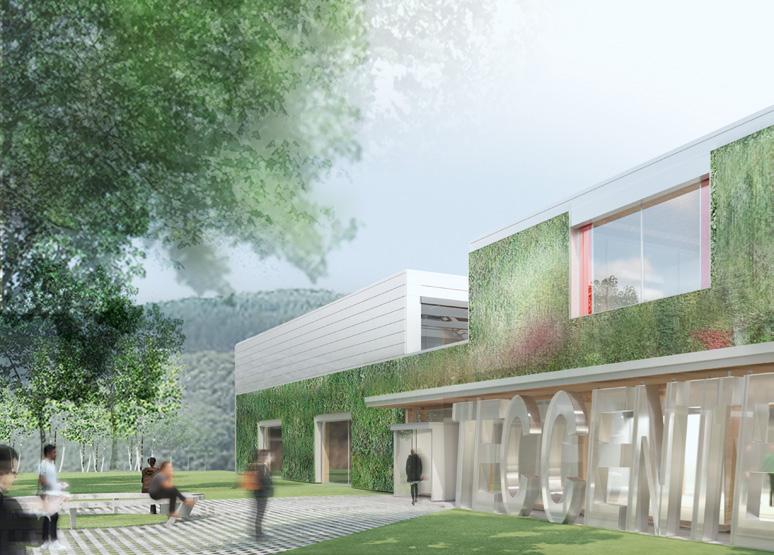
1997
Business development at EJOT & Avdel in Sweden is positive. As at many other EJOT locations, there is a lack of space. The new building is conveniently located at the Europen route E20 (Stockholm-Göteborg).
1997

Ten years of EJOT France under the sign of continuous growth. With a further building measure the office building is increased and has now an area of 500 m2, in addition a hall area of 1,500 m2 is available, in order to supply the customers optimally.

01 >> 2022 EJOT moment 40
>>Text: Heiko Stötzel
SUSTAINABILITY
The company is sending a clear message that preventing emissions takes precedence over reducing or offsetting them. The company feels the need to act now, not only as a result of increasing demands from customers and legislators, but particularly due to the company’s responsibility toward its employees and future generations.
We are already living in a global, human-induced climate emergency. Even the agreement reached at the 2015 Paris Climate Agreement to limit global warming to well below 2°C, and preferably to 1.5°C above pre-industrial levels by 2100, cannot hide this fact. Climate experts themselves are at loggerheads as to whether the 1.5°C target can be achieved at all. Scientists of the Intergovernmental Panel on Climate Change see realistic
chances only if all states take immediate and radical action now: The prerequisite is that CO2e emissions are significantly reduced before 2030 and are at zero emissions from 2050. Heat waves, droughts, heavy rainfall with flooding and melting glaciers have long since reached us. Extreme weather conditions are having devastating consequences for both flora and fauna. We see one consequence in the German low mountain ranges, with the destruction of the forest by the bark beetle – a consequence of the prolonged drought of 2018, 2019 and 2020.
In Germany, plans have been made to halve greenhouse gas emissions by 2030 with the use of solar energy, the phase-out of coal by 2038 at the latest, and the move toward greater sustainability in the construction, transport and agricultural industries. But so
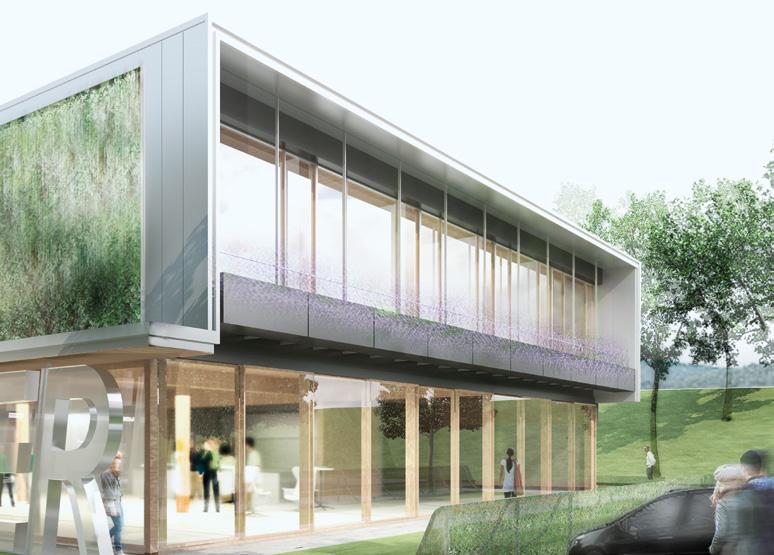
1997
The EJOT Group celebrates its 75th anniversary with a big open house day.
1998
Start of production at the joint venture in Kenosha, Wisconsin (USA). Nearby are some well-known automotive suppliers. Headlamp adjustment systems are produced on an area of 3,900 m2

1998
Analogous to the quality assurance system already in place, work is actively underway on an environmental management system. The fundamental goals are summarised in a catalogue of measures and regularly assessed and evaluated.
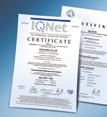
EJOT moment 01 >> 2022 41
far, Germany has fallen far short of its targets: the goal to reduce greenhouse gas emissions by 40 percent above 1990 levels, which was the goal initially set for 2020, was not achieved in 2021 either. It is the responsibility of businesses and industry to develop and implement climate protection measures. Each and every one of us has a responsibility to take action now.
As a leader in technology, the EJOT Group already makes important contributions in numerous areas to the circular economy and energy saving thanks to its product diversity, including the fields thermal insulation, electromobility, car body construction and solar technology.
In order to achieve the ambitious goal of climate neutrality by 2035, EJOT is focusing, among other things, on preventing emissions by installing photovoltaic systems to produce solar energy which can be harnessed to convert the company’s own vehicle fleet to electromobility and promoting employee leasing of e-bikes.
EJOT is also increasingly focusing on climate neutrality in its construction activities, as is the case with the construction of the new TecCenter in Bad Laasphe, Germany. The innovative TecCenter will have a “passive house character,” including facade greening, photovoltaic systems, geothermal energy with heat pumps, and charging stations for e-vehicles in front of the building – the TecCenter thus fulfils the KfW investing and development bank requirements necessary for German companies to receive funding designed to promote climate neutrality through sustainable construction projects.
From 2025 on, EJOT will exclusively purchase “green electricity” at all its sites – the pioneers of the group, EJOT Austria and EJOT Poland, have already been purchasing electricity from renewable energy sources for years. Furthermore, we plan to produce up to 10% of our own electricity for all EJOT buildings through renewable energy sources by 2030. The new building at the EJOT Türkiye site will directly fulfil this quota through a 2,000 kWp PV system.
At the EJOT Polska site in Ciasna, Poland, all devices and systems in the building and its surroundings have been monitored and managed since 2017 via the use of an integrated Building Management System (BMS) to ensure energy-efficient production. The system can react to changes in real time and automatically regulate optimal and efficient energy consumption.
At the China site, heat is already generated from geothermal energy with a heat pump.
At the beginning of 2022, EJOT France, together with other companies and the French municipality of Villè, started an energy partnership project: Sustainably produced electricity will be sold regionally and all participating companies will be able to make a concrete contribution to the energy transition.
On its path to climate neutrality, EJOT knows it can also count on the support of its employees: At the end of 2022, EJOT will introduce a financial participation scheme for employees – as another important step on the path to climate neutrality. Employees worldwide can share creative ideas for reducing greenhouse gas emissions and, depending on the GHG savings achieved, will be awarded financial participation rights, thus also profiting in the financial success of the company, a form of capital participation without voting rights. The financial contributions made are invested exclusively in sustainable projects to reduce GHG emissions.
Employees are also involved in reforestation projects, for example at the sites in Germany and the UK, and thus they help firsthand to promote biodiversity and nature conservation.
An international steering committee has been established to implement the sustainability strategy in all areas of the company. Progress made by the company in reducing its GHG emission levels is systematically tracked by the committee using key figures and targets Since 2013, EJOT has been transparently publishing data on all its GHG emissions directly and indirectly caused by the company’s activities in a Corporate Carbon Footprint Report according to the standards of the international Greenhouse Gas Protocol. The EJOT Carbon Footprint is measured on the basis of three emission sources, the so-called scopes: Scope 1 emissions include the release of GHG’s within the company, for example from heating systems or the company’s own vehicle fleet. Scope 2 emissions take into account the energy that the company obtains externally – primarily, electricity and district heating. Scope 3 includes all other emissions caused by the company's activities, for example via suppliers or end consumers.
EJOT is committing itself to the path of climate neutrality. The challenge of achieving climate neutrality will shape our very future. It is a task which requires great responsibility, but it is one
1998
After a six-month construction period, the new warehouse with an area of 1,000 m2 and the new office building are finished at the EJOT CZ Ricany-Jazlovice site near Prague. A modern location with good transport links.
1999
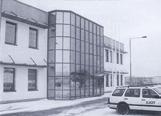
First Electronic Construction Catalog in the form of a CD-ROM. With this new technology the customer can retrieve information about EJOT in general as well as about the products of EJOT Construction Fasteners. All approvals and test certificates are included in the CD and linked to the products. In addition, an order can be printed directly from the delivery program.

01 >> 2022 EJOT moment 42
SUSTAINABILITY
that EJOT cannot solve alone. 77 percent of EJOT’s worldwide emissions are attributable to Scope 3. This is a share that cannot be directly influenced by us. However, our strong partnerships with suppliers and service providers, some of which have been in place for many years, make us optimistic that we will also achieve this goal – the reduction of the share of Scope 3 GHG emissions – together with our partners.
EJOT supports the use of green granulate and green steel as well as a GHG-free logistics chain. Only through a joint effort from all parties involved in the supply chain can EJOT achieve climate neutrality by 2035. So let's do it. Let’s shape our future together.
Emission sources






Reducing of the emissions of the EJOT Group







Scope 1
Scope 2
Scope 3
Growth
1999
20 years after the market launch of the PT ® screw the Industrial Fasteners Division presents its new “flagship” fastener for plastics – the DELTA PT ®. In addition to the screw, a computeraided calculation program is developed for the design of the joint, this allows the screw joint to be simulated over a long period of time and creates more security for the application.

1999
Mourning for Hermann Großberndt. The inventor of the PT ® screw dies at the age of 68. Mr. Großberndt had a decisive influence on the technical development, first at Eberhard Jaeger and later at EJOT. As early as the 1950s, he invented the first cold-formed self-drilling screw tip and thus revolutionized fastening technology worldwide.
EJOT moment 01 >> 2022 43
E CO2 SF6 CH4 N2O HFCs PFCs SCOPE 1 direct SCOPE 3 indirect SCOPE 2 indirect 180,000 160,000 140,000 120,000 100,000 80,000 60,000 40.000 0 40,000 20,000 t CO 2 2020 2025 2030 2035
Projekt TREEATHLON® –

EJOT’s contribution to the reforestation effort
On the occasion of the EJOT Group’s centenary in 2022, the company is supporting the reforestation effort in the Wittgenstein region. Together with the Wittgenstein Berleburg’schen Rentkammer, the forestry administration of the family zu Sayn-Wittgenstein-Berleburg, a 3.2 hectare area at Albrechtsplatz will be reforested with a climate-stable mixture of deciduous and coniferous trees.
1999
Foundation of EJOT Austria GmbH in Voitsberg. The sales office for application technology and sales for industrial products exists since 1992. In order to accommodate the positive sales developments and the expansion of the product range to include
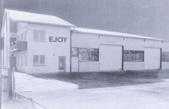
building products, the new national company is founded: The building with storage space can already be moved into, and plans for a separate warehouse and office building are also underway.
2000
Foundation of EJOT Slovakia, s.r.o., Kosice, Slovakia. Kosice is located in the east of Slovakia about 80 km west of the Ukrainian border and 20 km north of the Hungarian border. The company is the result of close cooperation with a major construction group.
01 >> 2022 EJOT moment 44
>>Text: Andreas Wolf
SUSTAINABILITY
Under professional guidance, around 2,000 seedlings will be planted per hectare in the EJOT company forest: Douglas fir, coastal fir, larch, sycamore maple and red oak. The plants are selected according to current scientific findings and many years of operational experience of the forestry experts of Wittgenstein Berleburg'schen Rentkammer.
In the anniversary year, EJOT Group employees in Wittgenstein will each plant one red oak seedling in the company forest, which spans a total of 1,200 m². The red oaks will be planted in the shape of the red EJOT company logo so that the EJOT logo will later be easily discernible from the sky.
In total, this reforestation project will remove an average of approx. 24 tons of the greenhouse gas CO 2 from the atmosphere
per year over the coming decades. To put that into context, that is enough CO 2 to fill up a cube with a height of 192 m. In 2019, each German citizen produced an average of 11.6 tons of CO 2
The 24 tons of annual CO 2 savings that EJOT is making with this initiative are therefore more of a symbolic contribution to climate protection. For EJOT, the reforestation project TREEATHLON ® is also about raising awareness among its employees and their families of forests, nature and climate and to observe how the EJOT company forest develops in the next 25 years. For this purpose, regular campaign and information events will held in the EJOT company forest even beyond the anniversary year. EJOT is striving to create an educational space which helps impart knowledge on sustainable forestry and, to this end, has agreed a long-term project partnership with the Rentkammer.
After three extremely dry years in 2018, 2019, 2020, the bark beetle has attacked thousands of trees in the Wittgenstein region – with dramatic consequences. The affected trees must be felled and transported out of the forest as quickly as possible. Entire patches of forest have disappeared and forest owners have lost out on millions due to the damage caused. E
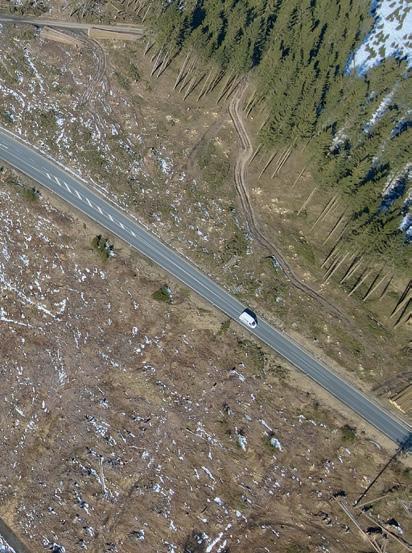
2000

Acquisition of the majority shareholding of the company Tezmak, Istanbul, Türkiye, and foundation of the joint venture EJOT Tezmak. EJOT has already been represented in Türkiye with a sales office for seven years. Tezmak is a Turkish screw manufacturer.
The know-how from both companies is combined to compete in an emerging market. The site is located in the European part of Istanbul and aims to achieve QS9001 certification first.

EJOT moment 01 >> 2022 45
Drone image from the afforestation area of the EJOT TREEATHLON® in March 2022.
Expanding presence in global growth markets
If we look to the future, we will see significant changes in the economy, technology and society. The next generation of automobiles will be primarily electrically driven; perhaps soon in such a way that humans will completely hand over control to the machine, including control over their own safety. Digitalization will continue to establish itself in more and more areas of life at high speed.
2000
Successes at the joint venture in the USA: Four years after its establishment, the development is very positive. The company now has 80 employees working in a modern production facility. The joint venture is now the market leader for headlight adjustment systems.


2001
Reorganization of the group structure and connection of the companies to EJOT Holding GmbH & Co. KG. The EJOT Group has grown strongly, however, due to the complicated tax circumstances restructuring has been avoided so far. However, with
a tax reform comes the possibility of restructuring. With the exception of EJOT France, all companies will be connected below the holding company. At the same time, an advisory board is set up.
01 >> 2022 EJOT moment 46
>>Text: Dr. Markus Duchardt
INTERNATIONAL
These are just a few of the challenges that we have to acknowledge and overcome as a company. With regard to new product and process developments, there are radical changes and certainly great opportunities that we want to take advantage of. However, the most important technological growing markets are currently in the USA and Asia. The 2020 Annual Report of the WIPO (World Intellectual Property Organization) states that Asia and North America together account for around 75 percent of global patent applications. In addition to Europe, the pacesetters for technical innovations that are relevant for us are therefore increasingly located in Asia and America and must consequently be supported from there.
In the future, mobility will almost certainly be dominated by electrically powered vehicles and aircraft. Global companies in the American and Asian markets will supply a large number of people with electric vehicles and establish a cycle of energy generation
and raw material processing, around whose standards we may then have to orient ourselves.
We are not unprepared for this development. We have a broad portfolio of products and product features developed specifically for this application environment. Today, the majority of our application engineers and developers are already working on the conversion of fossil combustion applications to climate-friendly technologies. From battery technology and the increasing number of vehicle sensors, to the lightweight and mixed construction of body shells, to charging stations for electricity and many other areas of application, electromobility offers enormous starting points for our joining technologies and for other complex coldformed and plastic parts from the EJOT Group portfolio.
In addition, the transformation to electromobility goes hand in hand with another major topic: autonomous driving – not feasible without a significant increase in video, radar and lidar systems as well as other sensors and the networking of vehicles with each other. An autonomous driving vehicle has a 360-degree perception of its surroundings, consisting of a network of small sensors with cameras, radar, ultrasound and three-dimensional laser scanning. Here, EJOT also has successfully implemented customised products, for example in the area of micro screws. Numerous technology leaders in these areas are also located in Asia and America.
As the European market leader, the EJOT Group will continue to expand its presence in the growth markets of America and Asia, which it started years ago. With the aim of being the global leader in problem solutions in the areas of fastening and forming technology. Anyone seeking fastening technology solutions thinks of EJOT first. Worldwide. E
Foundation of the Global Fastener Alliance (GFA). In order to offer customers a worldwide presence, the GFA is founded after a long period of negotiations. In addition to the European companies EJOT and Ribe, the American companies ATF and MacLeanFogg, the Brazilian manufacturer Micheletto, and from Japan the company Owari and from Korea JINHAP are part of the alliance.

Foundation of EJOT Italia s.r.l., Torino, Italy. In the first step, there is only one sales representative. Supply is made through Germany.
2001
Foundation of the UAB EJOT Baltic, Vilnius, Lithuania. The successful three-year business relationship with Hiltus has now given rise to the new company in Vilnius with responsibility for the Baltic States. The focus is on the sale of anchors for external thermal insulation composite systems.
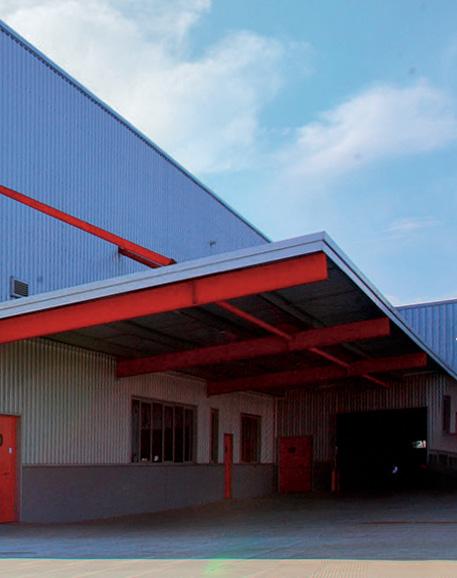
EJOT moment 01 >> 2022 47
2001
EJOT Fastening Systems in Taicang, China 2001
Potential and benefit of license management
As early as the 1980s, EJOT started to set up worldwide license management due to the strong demand for its products in direct fastening. In 1982 the first PT ® License was sold to the former screw factory Vereinigten Schraubenwerke (VSW).
The British PSM was the first foreign company with which a license contract was concluded. One year before, the PT ® screw had been introduced in Great Britain for the first time on the occasion of the Birmingham Motor Show.

2001
Foundation of EJOT Romania s.r.l., Pitesti, Romania. As a result of further development in Eastern Europe, EJOT is also turning its attention to the market in Romania. With two employees, a small warehouse is set up near Bucharest.
2001
Foundation of EJOT Wostok, Moscow, Russia. The largest market to the east must also not be missing on the EJOT map. A connection of several years with the new managing director of the national company enables the establishment of EJOT Wostok (East Russia).
2001
Foundation of EJOT Spojna Tehnika d.o.o., Zagreb, Croatia. After the foundation of EJOT Austria, the expansion towards the countries of former Yugoslavia is also a logical step. Slovenia can still be supplied from Austria.
01 >> 2022 EJOT moment 48
>>Text: Dr. Markus Duchardt
INTERNATIONAL
The expansion of the license management to the American continent followed. The first order of 30 million screws for a licensee in the Chicago area resulted in further license contracts. In 1989 the first PT ® license was sold to Japan. This was followed by the worldwide introduction of further licensed products such as DELTA PT ® and ALtracs ® Plus. In 2018, the first license for the third PT generation, the EVO PT ®, was signed. Today, around 50 licensees in 17 countries act as important multipliers for EJOT. They strengthen our brands worldwide and increase the brands’ availability.

Being an EJOT licensee is interesting for many companies. The trick is to have enough good suppliers in the market. This requires great care in the selection. The worldwide market should be well supplied with the product but not flooded. There are many inquiries by interested companies. But many do not fit in with the EJOT quality philosophy.
The licensee programme also guarantees that EJOT products are available worldwide in a consistently high quality. In order to meet this demand, EJOT provides its licensees with extensive
support in the areas of application technology, production and quality and even marketing. In addition to the manufacturing standards, the licensees gain access to licensed tool manufacturers; the basic prerequisite for high-quality end products.
Furthermore, the licensees have exclusive access to digital calculation programmes such as EVOCalc ®. This means that torques and clamp loads can be pre-calculated and component optimisations can be made as early as the design stage. This saves time and costs.
Employees of licensees are comprehensively trained and prepared for customer visits or – if desired – accompanied on a regular basis. Comprehensive component tests in the EJOT Applitec are also part of the service programme, as well as training and seminar support. The licensees are intensely familiarised with the product and its application. A broad approach to support that goes far beyond the mere sale of the product – an approach many customers abroad are not familiar with.
Germany: 1
France: 1
USA: 7
Spain: 2
China: 7
Japan: 6
India: 2
Malaysia: 2
Brazil: 2
Mexico: 2
2001
Addition of a floor to the EJOT Construction Fasteners building at Stockwiese in Bad Laasphe. In parallel, the exterior facade was finished in the EJOT design.
Italy: 1
Romania: 1
Turkey: 1
Singapore: 1
Vietnam: 1 South Korea: 5
Taiwan: 2
2001
The stamping and forming division and the raw materials warehouse (construction fasteners) are relocated to the building at Lahnuferstraße in Bad Laasphe. In addition, special machine construction is located there.

EJOT moment 01 >> 2022 49
E
2001
Merger of the companies EJOT Verbindungstechnik GmbH & Co. KG and EJOT Kunststofftechnik GmbH & Co. KG to the EJOT GmbH & Co. KG with the divisions Industrial Fasteners and Engineered Plastic Components.
2001
The kick-off event marks the beginning of the year-long SAP implementation project at EJOT. Together with the service provider KPMG, five sub-projects will be launched, which have to be implemented in different phases until “go live”. After the usual “birth pangs”, SAP becomes normality.

2002
EJOT publishes its first annual report. In addition to the latest developments, such as new products and innovations, current figures, data and facts as well as a management report are also published.

01 >> 2022 EJOT moment 50 A FAMILY BUSINESS
Holiday camp for children of EJOT employees
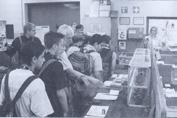
In 2011, EJOT was awarded the audit certificate “berufundfamilie” (work-life balance) by the non-profit Hertie Foundation for the first time. EJOT had prepared extensively before receiving the audit certificate, which was designed to analyse, evaluate and improve company activities to help employees strike a better work-life balance.

The starting point at that time was initially the successful reintegration of young mothers into working life. “The young women were not only very well trained in their respective roles, but, as skilled workers upon completion of their training, they also became an important part of the company”, says Winfried Schwarz, HR Managing Director of EJOT Holding GmbH & Co. KG until 2017. To enable female employees to rejoin the workforce at an early stage following the birth of their child, the company kept in close contact with the expecting mothers both during their pregnancy and while they were off on maternity leave so that individual and flexible working time models could be agreed upon to help them rejoin the workforce. “Back then, that was by far not as widespread and self-evident in the working world as it is today,” emphasizes Schwarz.
More than 10 years later, EJOT has just completed its third re-certification. Efforts to improve the work-life balance of employees have now been expanded to include even more aspects of employee life: holiday camps for employee children, flexible working hours and holiday time regulations in factory and administration positions and the promotion of employee health have been an integral part of an employee-oriented personnel policy for years. Additionally, there are many individual examples from everyday working life which are flexibly implemented in the departments and teams on a daily basis: Swapping shifts and reducing working hours in order to
temporarily care for a family member, mobile work from home if a child is sick, parental leave and further training opportunities in the framework of the EJOT Academy and much more.
The main targets of the current target agreement, the implementation of which are checked externally once a year, include, among other things, the promotion of digital personnel development with a view to make the training and further training of employees as well as the career paths of skilled workers and management personnel more flexible. Mobile work is just as much a part of the target agreement as is the flexible organisation of shift work according to special personal or family reasons of employees. Management personnel have a central role to play in this regard. As “service providers and coaches”, they support employees to harness existing potential and perform to the best of their abilities as well as providing advice on issues relating to the work-life balance of employees.
We can only successfully fulfil challenging tasks within the company if our employees can fully concentrate on their work and customers. The future success of EJOT is fundamentally dependent on how well we manage to tie qualified and committed employees to our company. Offering employees a healthy work-life balance plays an important part here, especially for future generations. E
2002
The new ALtracs ® screw, a self-tapping screw for light metals, is presented. A patent-protected product with clear product advantages, such as special flank angle thread forming zone and metric compatibility.

2002
First day of training at In der Aue in Bad Laasphe. In cooperation with the Siegerland Metal Industry Association, information is provided about apprenticeships and dual training. With these information events EJOT wants to attract young people for vocational training.
EJOT moment 01 >> 2022 51
>>Text: Andreas Wolf
“Career with apprenticeship” putting focus on dual training again
Distinct self-control mechanisms bring the supply of apprenticeships on the part of companies and the corresponding demand on the part of students into line with each other almost without state intervention and ensure very low youth unemployment, which is envied in many parts of the world. At the same time, a companies’ demand for skilled workers and managers is met precisely and at a high level. Unlike other countries, in Germany “VOCATIONAL training” always has priority over “WORK training”. Through nationally standardised curricula, cross-company and cross-product content and competences are taught, which ensures future employment in other companies as well. With attractive further training opportunities to become a master craftsman, technician or specialist, vocational training can be the springboard to a career. Even studying without an Abitur diploma is possible today due to the vocational training.
Hans Werner Kocherscheidt also discovered the great potential of dual training for EJOT at an early stage. He took on the first apprentices as early as the 1960s. Hundreds were to follow in the course of the decades. Thanks to the initiative of Hans Werner Kocherscheidt, the industrial training workshop was founded in 1975 as an inter-company training facility in Bad Berleburg. The development of the training workshop, today’s Bildungszentrum Wittgenstein (BZW), is still intensively accompanied and promoted by the managing partner Christian Kocherscheidt. As a long-standing chairman of the vocational training committee of the Chamber of Industry and Commerce, vocational education and training is particularly close to his heart. Apprentices as the “future of EJOT”, are a value for the company itself and not just a personnel reserve, but instead they guarantee steady renewal and high-quality performance.

Over the years, developments at EJOT have also progressed in leaps and bounds. Analogous to the technological change and the growth of the entire company, the training also changed. In the early years, the apprentices racked their brains in the subjects “technical knowledge”, “technical calculation” and “technical drawing” and worked for months on U-steels until their hands blistered, today the professions and their requirements have changed enormously. Today, EJOT regularly has more than 100 apprentices under contract in 19 different apprenticeship professions. Every year, around 30 apprentices pass their final exams and are taken on as permanent employees. New apprentices are recruited and start their training in the same number. The focus today is not only on traditional professions, such as tool mechanic or industrial clerk. The apprenticeships offered follow the ever more rapidly changing needs of the world of work. New professions such as e-commerce clerk, media designer, chemical laboratory technician or digitalisation management clerk provide new impetus and make a significant contribution to further strengthening already important functions with well-trained specialists in a few years’ time. And if there is no suitable apprenticeship that fits the company’s needs, EJOT goes its own way. With the specially developed combined training to become a “production IT specialist”, the two apprenticeships "machine and plant operator” and “IT specialist” are merged. The increasing convergence of technology and information technology due to digitalisation and Industry 4.0 is thus taken into account with its own dual training course. A unique concept that did not exist before and which was taken up and adopted by other companies quickly.
Further proof that such concepts work are our apprentices like Marius Latt from Bad Berleburg. The “production IT specialist” in
2002
Innovation Days in Berghausen:
Promoting creativity and inventiveness. This was the motto of the Innovation Days. On display were product innovations and in addition numerous suggestions for improvement from a wide range of areas.
2003
EJOT has to cut jobs for the first time due to the crisis. This was followed by a reorganisation of the Industrial Fasteners, Engineered Plastic Components and Building Fasteners Divisions. The new organizational structure is based on a clear
division of responsibilities between the holding company, which defines financial and management tasks as well as the strategic direction of the Group.
01 >> 2022 EJOT moment 52
With dual education, an outstanding idea was born in the last century. The German vocational training system is known worldwide for its excellent quality.
>>Text: Andreas Kurth
JOB TRAINING
training recently completed the first part of his apprenticeship as a “machine and plant operator” with the grade “Excellent” and 98 out of 100 points. The best result of all exams taken in Germany in this profession. One of three “national winners” at EJOT in the last six years.
Nevertheless, the dual training system is under enormous pressure. Just ten years ago, local companies were still receiving countless applications from young students who were looking for apprenticeships and dual study programs. At EJOT, too, the now oft-cited “laundry baskets” filled up quickly with job applications.

First digital screw configurator: After entering the fastening data and joining parameters, the customer receives a suggestion for the right screw. Then he can enter the desired delivery quantity and delivery date. This can be sent as an e-mail to the sales department and serves as the basis for a quotation.

New location, new building and new name: After a three-year project period, the new building at the Sherburn-in-Elmet site is finished. The site is located east of Leeds and offers space for expansion on the surrounding land. Last but not least, the name is changed to EJOT U.K.

EJOT moment 01 >> 2022 53
2003
2003
The selection of suitable candidates could hardly be narrowed down, and it was not possible to train as many people as there were potentially available. Many companies remember these times wistfully, because the job market has now completely changed: back then, young people spent a lot of time creating the perfect application portfolio and presenting themselves in the best light, but today it’s the employers who are fighting to recruit young talent. Numerous companies are unable to fill their available training and study positions and are left empty-handed. The reasons for this are complex. In addition to demographic changes, increasing academisation is a major concern. If the drastically reduced number of students also increasingly prefers academic courses to conventional training, this will exacerbate the existing skills shortage long-term.
In the competition for the still existing talents, EJOT prepares itself with great commitment. Just like students did a few years ago, now we try to submit the perfect application to the young people with diligence, effort and creativity and recruit them for training or studies at EJOT. Annual job fairs (hands-on
technology) meet with a strong response, as do the activities of our training ambassadors in schools.
Here it is important not only to focus on the smaller number of students who are still interested in education. Rather, the overarching goal must be to increase the basic population of young people willing to undergo dual training again. Since cohorts with a low birth rate can no longer be influenced in retrospect, it is important to put dual training back into perspective. A broad social discussion must succeed in bringing the German education system, which is still envied in the world, back into the focus of young people and their parents. The fact that dual training has turned into a second-class education pathway in parts of society is a development that is more than questionable. A “career with an apprenticeship” is still a “win-win situation” for young people and for businesses. This is impressively demonstrated by the countless apprentices who have been trained over the past decades and who today form the backbone of the EJOT Group as responsible specialists and managers.
2003
The first General Manager Meeting with the managing directors of the foreign subsidiaries takes place. The main topic is the restructuring and the associated changes for the national companies.
2004
Merger of the Polish organizations into EJOT POLSKA Sp. zo.o The expansion of the European Union is one of the reasons for the concentration process. Due to the retirement of a managing director, the two previous companies are merged.

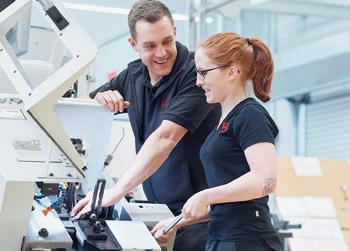
2004
New hardening plant in Türkiye: After the joint venture was founded in 2000, it quickly became clear that the aging salt bath hardening plant would have to be closed. It is replaced by a modern plant based on European standards.

01 >> 2022 EJOT moment 54
E JOB TRAINING
The advisory board – an important control body for the company’s success
The first meeting of the new advisory board was held on 2 May 2001. For the EJOT Group, the event marked the beginning of a new chapter in its management organisation. With the reorganising of the group structure, the decision was also made to found an advisory board.
Alecture held at the University of Witten-Herdecke by Prof. Rainer Kirchdoerfer, a representative of the law firm Hennerkes, Kirchdörfer & Lorz, was to prove key to the later decision. It was Prof. Dr. Hennerkes himself who was tasked with preparing a proposal on the shape that an EJOT advisory board should take.
The advisory board at EJOT was established as an advisory and controlling body for the management of the holding company. The board was also to accompany the new generation of the family business.
In modern “stock exchange language”, the advisory board could also be described as a kind of supervisory board for family businesses. Important control tasks were assigned to the new body in the Advisory Board Rules, such as the approval of annual plans and budgets of individual companies or the approval of major investments. Furthermore, the advisory board was intended to provide a broad background knowledge and a wealth of experience to the management group of the EJOT Group. This was particularly important for the shareholder family, Kocherscheidt, as the members of the advisory board who were not a part of the Kocherscheidt family were themselves entrepreneurs.
The purpose of the advisory board’s control function was to prevent shareholders from making and immediately implementing decisions – decisions first had to be examined and evaluated from several sides. For the EJOT Group, which had just expanded at that time, this was an important step in professionalising the business. And last but not least, the decision to establish the advisory board also made allowances for the risk of a fatal accident involving one or more shareholders. This made for a group management and
control system which would continue to function even in the event of such a tragic event.
At that time, the newly constituted advisory board of the EJOT group consisted of the following members. Family: Hans Werner Kocherscheidt, Kathrin Susanne Rörig (today Kocherscheidt), Bernd Frank Reuther. External advisory board members: Dr. Hans Werner Löhr, Dr. Harald Marquardt and Donald E. Surber. Hans Werner Kocherscheidt chaired the board, and Dr. Hans Werner Löhr was the deputy chairman.
In the anniversary year 2022 the advisory board of the EJOT Group is made up as follows: Dr. Hans-Toni Junius (Chairman, pictured), Kathrin S. Kocherscheidt, Jean Dufour, Prof. Dr. Thomas Bauernhansl, Dr. Uwe Böhlke, Andrea Teutenberg. The long-serving chairman Dr. Claus-Dieter Hoffmann who is set to retire will be seen off in August at the centenary celebrations. E

2004
New central warehouse in Gießen:
The outsourcing of the finished goods warehouse is intended to optimize logistics costs. The location in Gießen is advantageous due to the convenient transport connections.
But the new central warehouse in Gießen does not prove suitable. The logistics of Construction Fasteners and Industrial Fasteners return to Bad Berleburg. The logistics for ETICS products remains in Gießen.
2005
Foundation of Bulgaria EOOD & Co. KD, Pleven, Bulgaria. The EJOT Group has grown with the sales office in Bulgaria. The joint venture partner of the new company based in Pleven is Horizont-Ivanov EOOD.
2005
EJOT has developed special fasteners for the growing market with solar energy. They enable fast and safe installation of photovoltaic systems on roof structures with roofing made of trapezoidal sheet metal, sandwich elements or corrugated fiber board.
EJOT moment 01 >> 2022 55
>>Text: Andreas Wolf
ADVISORY BOARD
The colour doesn’t matter, as long as it’s white
The name EJOT came into being purely by chance: With the acquisition of a teletypewriter, initials had to be given as an address. Margarete Jaeger, the wife of the company founder Eberhard Jaeger, picked the letters “E” and “J”. However, as two letters were not enough, she also added an “O” and a “T” to make “JOT”, the phonetic spelling of the letter “J” in German - and so the name “EJOT” was born.
From these four letters, she also developed the first company logo: an upside-down DIN 85 slotted screw in a square field with the name EJOT written across the threaded shaft of the screw. Those not familiar with the company often didn’t understand the letters “O” and “T”. So in the 1980s, the company decided to make a mnemonic out of the abbreviation "EJOT" with the phrase “Eine Jeweils Optimale Technik” (An Always Optimal Technology), which, however, never really caught on.
In 1984, the two companies Adolf Böhl and Eberhard Jaeger were merged under the name EJOT. For the development of a new logo, Hans Werner Kocherscheidt commissioned different designers to come up with several new design ideas. In the end, a proposal by the designer and graphic artist Ulf Höppner from Berleburg, Germany, was chosen - from that day on, a new red logo could be seen on all business papers, and which can still be seen today on every company building and on every company car.
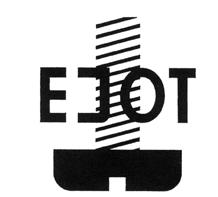
No matter where a building was rented or built, at home or abroad, Hans Werner Kocherscheidt would be there to ensure that his ideas about the image were implemented. Corporate identity was very important to him and he wanted to ensure that the new logo was displayed on all company property. The new trademark had a modern logo, which, thanks to its timeless design, has remained unchanged to this day.
2005
Foundation of the new company EJOT Fastening Systems Co., Ltd, Taicang in China. 50 km northwest of Shanghai, Taicang is a central location of German-Chinese cooperation. Other companies such as Waelzholz or Schaeffler are also located there.
2005
The ERAS font served as a base, but the letters were moved slightly closer together so that the text couldn’t simply be inserted in the corresponding font, a mistake that is often made. If the font appears familiar to you, you might already know it from the logo of the CDU, Germany’s Christian Democratic Union party. Here, too, the basis is the font ERAS, with the sole difference being that the letters CDU were tilted to the right, and therefore arranged somewhat differently.
The first version of the design manual, which was typically referred to by engineers at that time as a company standard, was created in the early 1990s. The logos and fonts, like the standard Helvetica font, were also written the same as the first additional logos like “EJOT Qualität verbindet” (EJOT: The quality connection) - and were directly made available in several languages.
For brochures and other advertising material, an inventory was first necessary. Green and purple logo variants existed mostly with Asian licensees.
We have of course developed over the years: today, a modern design manual is available where the most important design elements are described, from the logos and business equipment to the description of image worlds. With the design manual, we also want to achieve a uniform appearance of the EJOT brand
Foundation of the subsidiary EJOT Tehnika Spajanja d.o.o. in Serbia. The site is located 15 km from the center of the capital of Serbia, Belgrade. With three employees it is intended to further the southeast expansion for the construction division.
2005
Over the last few years the structured, goal oriented project work has become a steady part of our business processes. For this reason, a project workshop is now held annually.
01 >> 2022 EJOT moment 56
>>Text: Annemarie Bremer
CORPORATE DESIGN
DESIGN


2.1 Brochures
2006
Relocation of the VBT business unit “Fensterbauschrauben” (industrial window fasteners), as Business Unit IFF at Building Fasteners. The windows and glass facades product areas complement the building envelope product port -
internationally. This manual is a living document and is continually being developed.
The red EJOT logo even has its own fixed place at the rear of the vehicles that make up the EJOT fleet. When it comes to the colour of the vehicle, the following sentence still applies today: The colour doesn’t matter, as long as it is white. Picking white was a clever marketing decision at the time, because for a long time the colour white was rather unpopular for cars and therefore rare. Consequently, white EJOT vehicles stood out and became somewhat of a unique selling point for the company. Werner Kocherscheidt was always proud of the white EJOT fleet. An attempt to introduce the colour silver to the EJOT company vehicles was unsuccessful.

folio. The product area of window construction deals with products for the industrial production of windows and doors made of PVC, wood and aluminum. In Germany, EJOT is one of the market leaders.
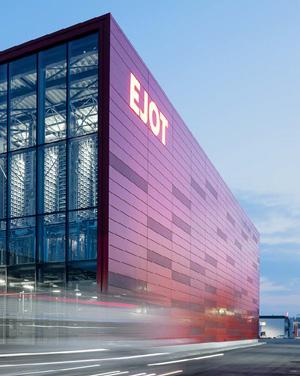
2006
The new company pension plan offers advantages for both the employer and the employee. An in-house collective agreement stipulates that employees can convert a fixed number of overtime hours into the SENECA program, plus a performance-related component. The employee receives an additional retirement benefit and the employer achieves flexibility with overtime hours.
EJOT moment 01 >> 2022 57
CORPORATE
Style Guide Version 2.4 | 04-2022 Style Guide Version 2.4 04-2022 6 In order not to impair the effect of the logo, a free space is defined in which no other graphic elements may be placed. The free space is minimum 50% of the height of the word and figurative mark EJOT. Four "x" correspond to 100% of the logo height. 1.1 EJOT® logo 1.1.2 Free space Style Guide Version 2.4 04-2022 45 Design 1. A large image about the topic or the content is placed in the upper area. 2. The image motif is cut at the lower edge at an angle of four degrees rising to the right. The height of the image motif varies depending on the type of the cover. 3. On the left side of the image motif, there is a transparent area for describing the subject (80% white). 4. Text box for describing the subject 5. For the headline, the defined title head with a font size of 34 pt and a line spacing of 40 pt is the standard. For the sub headline, the title sub is used. Font size is 18 pt and line spacing 24 pt.
E
2.1.1.1 Cover page > General design The same print space and the same dimensions of the logo and the claim apply to all cover pages. Anwendungen Produkte Spezial Title head 2020, 34/40 pt Adis di omnimo Title sub 2020, 18/24 pt, Adis di omnimo 1 2 3 4 5 Adobe InDesign Templates Design templates for Adobe InDesign are available for download in the Marketing Cloud: > Download templates
The EJOT architecture
Around Christmas time in 1989, Christian Kocherscheidt called to ask if we would like to look at an old factory building in Bad Laasphe at 10:00 a.m. on a Friday. He was talking about the former Mirella plant, which was being considered for acquisition.
It was bitterly cold and we got into a BMW 7 with a C-Netz telephone on the console in the middle. First encounter with H. W. Kocherscheidt and EJOT. After inspecting the dilapidated building, we drove around the building in the heated vehicle for almost two hours and discussed the architecture, preservation options, refurbishment, cooperate identity and EJOT’s brand image. Around noon, a call came asking him to come home for lunch
2006
The countries Croatia, Bosnia, Hungary and Serbia are supplied from the EJOT Austria warehouse in Voitsberg. Therefore, a capacity expansion of the warehouse is necessary. With this step, 3,170 pallet spaces are made available, so that further sales growth is also possible.


and we got the job. Visits to Eberhard Jaeger in Bad Laasphe, in Berghausen, in the law office followed.
The company buildings were partly brown, beige, grey; some extensions, some new buildings dipped in red paint with white plaster. Table trays, hole punches, coffee pots, chair frames in red, red, red. We got to work and tried an analogy: A car rental company at
2006
Foundation of Middle East FZE, Dubai. In the emirate of Sharjah directly at the airport, the new company is founded. The construction boom in the Arab Emirates also offers interesting prospects for the Building Fasteners division.
2006
The new plant in China is officially inaugurated. Official representatives of the city and the political party as well as other numerous other guests watch the festive opening ceremony followed by fireworks.
01 >> 2022 EJOT moment 58
>>Text: Monika Weber-Pahl and Prof. Burkhard Pahl
CORPORATE DESIGN
the airport makes all of its products red, yellow or green to make them easier to recognise and differentiate, including the ties and scarves of the staff.
A “local hero” or “hidden champion” may take a back seat with their buildings in terms of perception and emphasise more qualitative characteristics. The trademark “EJOT quality connects” was already set. For us, this meant transferring the metal, the quality of the connection, the authenticity of the products, and the attitude of the company in the architectural appearance. The ubiquitous RAL tone 3002 – carmine red – was used as an accent colour and only for moving parts such as casements and doors, the white was assigned an accompanying tone, a grey hue and a design level was sought, similar to that achieved by Otl Aicher for and with Lufthansa (note: accent colour yellow, metallic grey and white. Lufthansa has currently eliminated the accent colour yellow, which we would never suggest for EJOT).
Material quality and honesty in the products should be reflected in the brand image and in the architecture. So we used surfaces with a high-quality feel, real wood veneers instead of imitation plastic, sustainable building approaches, e.g. for the EDP expansion in Berghausen with the first cooling ceiling, exhaust air facade and extensive roof greening in South Westphalia.
The opportunity for a complete new building did not arise in the first few years. Nevertheless, a legible brand image developed, which was accompanied by the growth (Factor 10) of the EJOT Group, which was copied worldwide (porthole doors, etc.) and further developed.
With the expansion of the locations in Bad Berleburg and Ciasna in Poland, we were able to develop a brand-typical building type for EJOT, consisting of a white envelope surface with elements in graphite grey colour set back at the front.
The heart of the screw production, the automatic high rack warehouse in Bad Berleburg, could then also be dipped in red, given the dimensions of the overall plant. Inside, transparency, visual relationships, working in daylight and flexibility for still unknown processes were to become characteristic and be realised as a prototype in the production hall 4.0. Meanwhile it became not only an attractive place to study and work for employees, but also architecturally interesting for external guests.
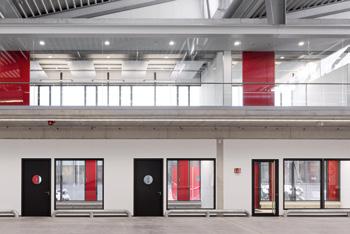
Now comes the next step. We will reduce the ecological footprint of buildings and production out of responsibility to the environment and the next generation.
The building process was characterised by extensions and additions. We were able to significantly improve functional processes, as at the Berghausen and Bad Laasphe sites, and thus an architectural appearance on a small and large scale. This also applies to the transformation of the “old electro-plating shop” at the Bienhecke site in Bad Laasphe into an area for marketing and an oval meeting room – the egg.
2006
With the foundation of EJOT Iberica S.L. EJOT is also represented on the Iberian Peninsula. The name „Ibérica“ also includes the country of Portugal as part of the Iberian Peninsula.
The new construction of the Tec Center in Bad Laasphe will be a pilot project for reduced CO2 consumption, for the use of renewable raw materials, for the re-use of materials (keyword urban mining) with possible interactions in research and development, in the development of new or reusable products and detachable connections.
We are so glad to have been able to help shape the “world of EJOT” and want to continue setting trends in the future. E
2006


New building for EJOT Slovakia. The new rented building provides 850 pallet storage spaces as well as new office space.

EJOT moment 01 >> 2022 59
Drawing of the “In der Aue” site taken on the occasion of the inauguration.
Foundation of EJOT ATF Mexico. The new company is based in San Luis Potosí, in north-central Mexico. It is not far from the main locations of the automotive industry Mexico City, Puebla or



01 >> 2022 EJOT moment 60 TRIATHLON
2007
Querétaro.
2007
Construction of the new logistics center at the Stockwiese site in Bad Laasphe.
EJOT and Triathlon: An unprecedented success story
From humble beginnings. EJOT initially supported TV Buschhütten in its annual regional triathlon events. Later, in 2000, an intensive partnership developed with the support of the triathlon teams, which led to an unprecedented success story:
EJOT Team TV Buschhütten has been a national and international leader for years and has acquired a leading international reputation in triathlon sport.
The cooperation got off to a promising start in the world of sports: the 1st men’s team celebrated promotion to the 1st triathlon national league in 2001, the 2nd team was promoted to the premier league. Just one year later, relegation to the 2nd Bundesliga made for a sobering experience. Rainer Jung, sports director triathlon at TV Buschhütten, remembers it well: “At the last competition at Lake Breitenau near Stuttgart, the finish area was already dismantled, everyone had already crossed the finish line and the broom wagon was following behind our last athlete. But all the team members, coaches and fans were waiting for him at the finish line to show that we are one team.” At that moment it was clear: “We’ll be back – and next time through the main entrance.” That is the plan and the agreement with EJOT.
In the period that followed, there was intense work on both the sports and management side of things. The teams were strengthened, new partners and sponsors were acquired. In 2005, the EJOT Team TV Buschhütten was promoted back to the 1st Triathlon Bundesliga and four years later became German Team Champions for the first time. As of 2021, the men’s team has won a total of 10 German championship titles, while the women's team has secured 9 German championship titles. In addition, there are numerous titles in the 2nd Triathlon Bundesliga, the NRW League and the Senior League.
Another highlight is the German championship title in Team Mixed Relay in Berlin in June 2021: millions of people watched the exciting sprint competition, broadcast live by ZDF, in which the EJOT team competed with top athletes Lena Meißner, Lasse Lührs, Lisa Tertsch and Justus Nieschlag and secured the title in the end.
As important as the successes at the top are, sustainable development and promotion of children and young people with a holistic approach are necessary. Here, too, the people in charge at TV Buschhütten are doing an excellent job. With a well thought-out concept and professional training methods, the triathletes of the future are trained and carefully built up here.
The annual EJOT Triathlon Buschhütten, a sporting showcase for the entire region, shows that the triathlon is not just a brand in South Westphalia. Athletes from Germany and neighbouring European countries flock to this competition, which is as demanding as it is popular, to compete in the first competition of the season at the beginning of May after a long winter break. In addition to hundreds of ambitious amateur triathletes, the international triathlon elite also compete in Buschhütten year after year. Experiencing top stars like Jan Frodeno, the winner of 2019, up close in competition – makes the EJOT Triathlon Buschhütten an absolute highlight for spectators and fans as well.
2007
With the acquisition of the Holz-Weber hall EJOT creates the possibility to concentrate the Wittgenstein production of the Industrial Fasteners Division at the location "Astenbergstraße" in Berleburg in the long term. In addition to the existing 50,000 square meters of the Astenbergstrasse site, further land with buildings will be added in the immediate vicinity.
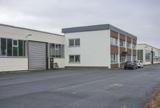
2007
EJOT receives the Roswith-OerterPrize of the Christian Democratic Workers’ Union (CDA) and is thus honored for its social commitment.

EJOT moment 01 >> 2022 61
>>Text: Andreas Wolf
2001–2022 Triathlon successes

2001
• Rise to the 1st Triathlon Bundesliga Men

2002
• Promotion to the 1st Triathlon Bundesliga Men
2003
• Champion 2nd Triathlon Bundesliga Men
• Champion Regional League Men
2004
• Vice-Champion 2nd Triathlon Bundesliga Men
• Vice-Champion Regional League Men
2005
• Champion 2nd Triathlon Bundesliga Men
• Champion Regional League Men
2006
• 10. 1st place Triathlon Bundesliga Men
• Vice-Champion NRW League Men
2007
• 3rd Place 1st Triathlon National League Men
2008
• 2nd place 1st Triathlon Bundesliga Men
• Champion NRW League Men
2009
• German Champion
1st Triathlon Bundesliga Men
• Champion 2nd Triathlon Bundesliga Men
• Vice-Champion Regional League Women
2010
• Vice-Champion 1nd Triathlon Bundeslig Men
• Vice-Champion 2nd Triathlon Bundesliga Men
• Champion NRW League Women
2011
• German Champion
1st Triathlon Bundesliga Men
• Champion 2nd Triathlon Bundesliga Women
• Champion 2nd Triathlon Bundesliga Men
2012
• German Champion
1st Triathlon Bundesliga Men
• German Champion
1st Triathlon National League Women
• Vice-Champion 2nd Triathlon Bundesliga Men
• Champion Regional League Women
2007
Logistics hub for EJOT construction fasteners established in the south of Taiwan, where many suppliers are also located. Activities in Taiwan are initially focused on placing goods from the various local suppliers (over 700 million screws in 2007) in the company’s own warehouse and then subjecting them to quality inspection.
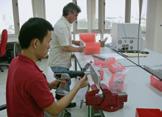
2013
• German Champion
1st Triathlon Bundesliga Men
• German Champion
1st Triathlon National League Women
• Champion 2nd Triathlon Bundesliga Men
• Champion NRW League Women
2014
• German Champion
1st Triathlon Bundesliga Men
• German Champion
1st Triathlon National League Women
• Champion 2nd Triathlon Bundesliga Men
• Champion 2nd Triathlon Bundesliga Women
2015
• German Champion
1st Triathlon Bundesliga Men
• German Champion
1st Triathlon National League Women
• Champion 2nd Triathlon Bundesliga Men
• Vice Champion 2nd Triathlon Bundesliga Women
2016
• German Champion
1st Triathlon Bundesliga Men
• German Champion
1st Triathlon National League Women
• Champion NRW League Women
• 3rd place NRW League Men
2007
EJOT pursues the goal of increasingly filling important key functions worldwide with employees from its own ranks and establishing long-term succession planning. For this purpose, the JuniorPEP (Junior Personal Development Program) is launched. Employees are nominated by their supervisors and selected by management to participate in the program.
01 >> 2022 EJOT moment 62
TRIATHLON
2017
• German Champion
1st Triathlon Bundesliga Men
• German Champion
1st Triathlon National League Women
• Champion NRW League Women
• Champion NRW League Men
2018
• German Champion
1st Triathlon Bundesliga Men
• German Champion
1st Triathlon National League Women
• Champion NRW League Women
• Champion NRW League Men
2019
• German Champion
1st Triathlon Bundesliga Men
• German Champion
1st Triathlon National League Women
• 3rd place NRW League Women
• Senior League Champion
2020
No triathlon season due to Corona
2021
• German Champion
1st Triathlon National League Women
• German Vice Champion
1st Triathlon Bundesliga Men

• German Champion Team Mixed Relay
• Champion NRW League Women
Why does EJOT support a triathlon team? This came about more or less via a coincidental, private contact between the former managing director of EJOT Baubefestigungen, Werner Born, and Rainer Jung from TV Buschhütten in the 1990s. The sporting success of the past 20 years is inseparably linked to the couple Rainer and Sabine Jung, who have formed top men's and women’s teams with professionalism and a high level of personal commitment – right up to the establishment of a professional team management, with extensive media work or the acquisition of sponsors. The EJOT Team TV Buschhütten enjoys a high reputation in sports and is a brand whose impact reaches well outside the region of South Westphalia.

This also benefits the company EJOT, whose level of recognition as a so-called “hidden champion” has increased in recent years due to the success as well as the regional and national presence of the triathlon teams. Success takes hard work. This applies equally to EJOT and the triathlon team. Willingness to perform, consistency, team spirit and discipline are just as indispensable for the staff as they are for the athletes. That, too, is what makes this a success story. E

2007

2008
After only ten months of construction, the new logistics center at the Bad Laasphe site is put into operation on schedule. All work can be completed on time so that commissioning can also take place as scheduled.
EJOT moment 01 >> 2022 63
Reconstruction and inauguration of the new EJOT plant in Küçükköy, Türkiye.
Women and Technology –That’s the way
After 14 years in Germany, the Turkish native with German citizenship, who was born and raised in Istanbul, decides to return to her home country in 2007. This decision was probably the most difficult and at the same time one of the best in in Zihnet Tanriverdi’s life. The reason: a call from a German company in Istanbul. EJOT Tezmak.
The 51-year-old is a passionate mechanical engineer. Zihnet Tanriverdi was already fascinated by technology during her school years in Istanbul. She studied mechanical engineering at the renowned Istanbul Technical University and wanted to complete her internship in Germany after graduation. Which
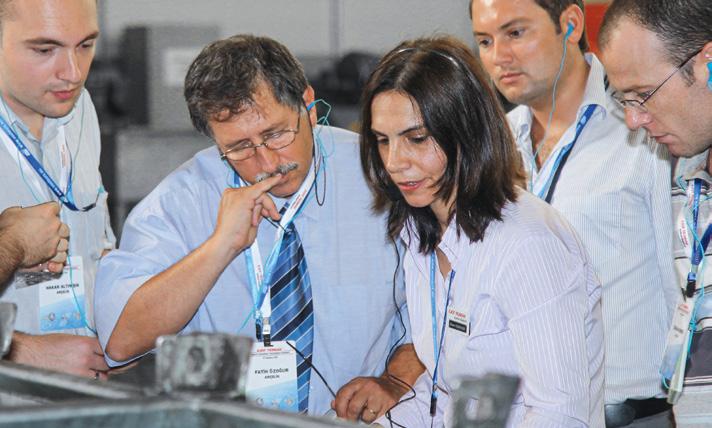
country is better known for mechanical engineering than Germany? “That's why I wanted to go to Germany”, she says. When she came to Germany in 1993, she did not speak a word of German. She attended a German course for six months and began to study business administration at the University of Bielefeld in parallel to
2008
The EJOT Supplier Award 2008 is awarded for the first time in the rooms of castle Wittgenstein in Bad Laasphe. For a company the size of EJOT, suppliers play an important role for the success of the company.

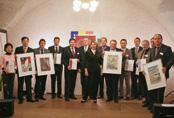
2008
Compatibility of work and family at EJOT: Participation in the pilot project “Family-conscious personnel policy”, with the aim of training mentors in the participating companies, who then develop recommendations for action and measures.
01 >> 2022 EJOT moment 64
>>Text: Eva-Maria Homrighausen
PEOPLE AT EJOT
her internship at a ball bearing company in Bielefeld. Shortly afterwards, she was offered a permanent position by the company and worked there for 14 years as a test engineer. She wanted to stay in Germany. Therefore, after five years, she decided to become a German citizen. The option of choosing dual nationality did not exist at the time.
Returning to Istanbul was not an option for Zihnet Tanriverdi at the time. She loved her life and her demanding job in Germany. But her family in Istanbul tried to persuade her to return home to work for a German company. Without her knowledge, her sister sent applications to German companies in Istanbul on her behalf. Shortly before Christmas 2007, Zihnet Tanriverdi unexpectedly received a call from a German company based in Istanbul. EJOT Tezmak. She was invited for an interview and spontaneously decided to visit her family in Istanbul over the Christmas holidays to see the company.
The conversation with managing director Sedat Aricioglu unexpectedly turned her life upside down. She sensed the warm, friendly atmosphere and recognised the great development potential of the company. Zihnet Tanriverdi reconsidered her professional and private future in Germany and thought about returning to Türkiye. She was faced with the question: did she want to spend her life in Germany forever or return to Istanbul? “Leaving Germany completely behind me – that was probably the hardest decision of my life”, she says. At the same time, she received an offer from Mercedes in Istanbul. But the great development potential of the smaller company appealed to her and she said to herself: “It’s now or never.” She decided to leave everything behind after almost 15 years in Germany and to start fresh in Türkiye.
“I didn’t unpack my suitcases for the first five weeks”, she says. “So that in case of doubt, I could quickly go back to Germany.” But she stayed.
Today, as Production and Engineering Manager in a male domain, she is responsible for the entire production at the site with an output of over 200 million parts per month. What she particularly likes about her job is “that we surprise and impress with out technical know-how. And, of course, the success of the company. That is simply teamwork. We work together like a family”, she says. She deliberately chose EJOT back then because she saw the great potential, and she still sees it that way today. “We have already achieved a lot and still have a lot of potential. If we continue to train our employees so well here, then a lot is still possible with EJOT”, she says with confidence.
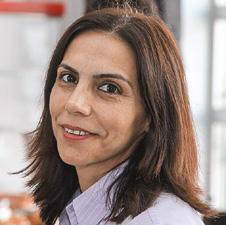
2008
With a Day of Nations EJOT participates in the 750th anniversary celebration in Bad Berleburg. This emphasises the international orientation of the company. All foreign subsidiaries participate.
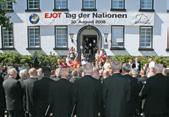
“When you say in Türkiye that you work for a German company in Istanbul, everyone always thinks directly of Bosch, Mercedes or other famous German companies. But working for a family business offers so many advantages. You see successes much faster, the company culture is familiar and you have a good and trusting relationship with your superiors and the management. If you have a good idea, you can discuss it quickly and also implement it quickly together.”
Zhinet Tanriverdi, EJOT Tezmak
She describes her return to Türkiye and taking over as production manager as her most important professional decision. “Manufacturing is always exciting in new ways because various factors play a role, such as people, tools, machines and materials. I always have a healthy respect for the fact that it is not solely my own performance that is decisive for success. If I didn't succeed in my work, it would make me very unhappy in the long run. So it was not an easy decision, but in retrospect it was definitely the right one”, she says.
With her decision to return to Istanbul in 2007, her private life also changed. She met her husband, who was living in the USA at
2008
Hans Werner Kocherscheidt turns 80. In addition to an official reception with regional VIPs from business and politics, it was especially important to him to have two employee parties, held in Bad Berleburg and Tambach-Dietharz.

EJOT moment 01 >> 2022 65
the time, got married and had twins in 2009. For her and her husband, balancing family and career is a matter of organisation. Five weeks after the birth of her twins, she returned to work full-time 45 hours a week for EJOT with the support of a nanny. “I had to make a decision: work or stay at home. Then I decided – working is less stressful than being at home with twins”, she laughs. What is essential for her and her husband is the quality of the time they spend together, not the quantity. “I
still have enough strength and energy after my working day to spend quality time with my children.” In addition to their mother tongue, the twins are also learning German and English and have German citizenship.
What does she appreciate about EJOT to this day? “The freedom and the learning processes.” There hasn’t been a single day at EJOT where she hasn’t learned something new. E
From “Rothose” (red work trousers) to Head of Maintenance
At the age of 14, Sophie Wiegandt worked in maintenance for the first time during her student internship. She was immediately enthusiastic. An experience that significantly influenced her later professional career. Today, the 32-year-old is head of maintenance at the EJOT site in Tambach-Dietharz, Thuringia. She is the boss of 46 men.
When Sophie Wiegandt first entered the maintenance department in 2005 as a “Rothose” (red trousers), as the trainees at the local regular school are still called today, her passion for technology was awakened: “I was captivated by maintenance”, she says. “I was fascinated by the fact that at the end of the day I had a visible result from practical work with my hands.”
In 2006, she became the first – and still is the only – woman to start training as an industrial mechanic at the Tambach-Dietharz site; she completed her training in 2010. After her apprenticeship, she decided to study mechanical engineering at the Schmalkalden University of Applied Sciences. The situation was familiar: 100 fellow students and only one female student. But she is glad that she chose this path for herself. “The fact that there have always been few women in my professional
2009
TOP JOB Award as one of the best 100 employers in medium-sized businesses The EJOT group mainly scored with above average dedication for a good work-life balance of their employees. These include work-life balance offerings such as flexible working hours, parental leave or the health weekends.
environment has never bothered me”, she says. “The topics of conversation are the classic men's topics. But I enjoy working with my colleagues because it involves technical processes that I, as a woman, am just as proficient in as my colleagues.”
Sophie Wiegandt completed her Master’s degree in 2015 and initially moved to the technical-commercial office as a project manager. When the opportunity to take over the management of maintenance opened up two and a half years later, she didn't think twice and jumped at it. “My heart has always been in maintenance”, she explains. In 2018, the then 29-year-old became the first woman to take over the management function at the EJOT site in Tambach-Dietharz. The department consists of 46 men. Sophie Wiegandt enjoys a high level of acceptance. She has never regretted her decision.
2009
EJOT presented with the Marketing Award
2008. The Marketing-Club Siegen awards the concept “Increasing System Performance”

The theme of the concept: it is not just the price of the screw that is decisive, but the entire joint. This concept is optimally “staged,” according to the laudatory speech.

01 >> 2022 EJOT moment 66
>>Text: Eva-Maria Homrighausen
PEOPLE AT EJOT
Start of manufacturing in China: Screw production starts in Taicang with six headers and six rollers for the diameter range M1 to M6 in the usual lengths. Approximately 7 million screws are produced each month. At first, only existing customers are supplied, but the potential is far greater.


Her day-to-day work is as varied as her career. She likes the combination of office work and close contact with production, as well as her department’s responsibility for the proper functioning of machines and systems. “In addition, I guide my staff, analyse when problems arise and do organisational work”, says the 32-year-old.
Her decision to pursue a technical career away from typical role models is anything but ordinary to this day. The proportion of women in metalworking occupations has been below 10 percent for years. The majority of girls choose from only ten different apprenticeships, such as medical assistant or hairdresser – not a single scientific-technical one among them.

To change this, Sophie Wiegandt is regularly involved in training fairs in the Gotha area and promotes more young women in technical training. “I hope that I can be a role model for other young women with my career and that my experiences, which I share with the female students at the training fairs, have a positive influence on the image of technical professions.” Technical understanding is not a question of gender. What counts is enthusiasm and interest in technology. E
The Industrial Fasteners business unit receives an order from Continental’s Chassis & Safety Division to supply high-precision cold-formed parts for the assembly of valves for electronic braking systems (EBS).
This marked the start of the Forgings production at the Bad Berleburg site.

EJOT moment 01 >> 2022 67
“I hope that I can be a role model for other young women with my career and that my experiences, which I share with the female students at the training fairs, have a positive influence on the image of technical professions.”
Sophie
Wiegandt, EJOT Tambach-Dietharz
2009
2009
Georg Dickel – 53 years a sought-after specialist
0 parts per million (ppm) does not yet exist. The screws produced at Adolf Böhl in Bad Berleburg-Berghausen are packed into burlap sacks, driven to the railway station in the neighbouring village of Raumland and loaded there. This is always accompanied by a small box with additional parts so that the customer can see what else is being produced. This is how Georg Dickel experienced it when he started in the shipping department at the Adolf Böhl screw factory in 1968. 100 employees worked in the company at the time.
Ahen he finally retired in autumn 2021, he had been working for Adolf Böhl and EJOT for 53 years. “Finally” because he already reached retirement age in 2012, but subsequently passed on his knowledge in many ways within the company. 53 years is an eternity, especially in technical terms.
In the early 1960s, when wood screws were still turned with a spindle rather than being rolled. The rolling dies were made on a plane and hardened in a field forge. That's how it all started for Georg Dickel after he moved from shipping to the rolling department.
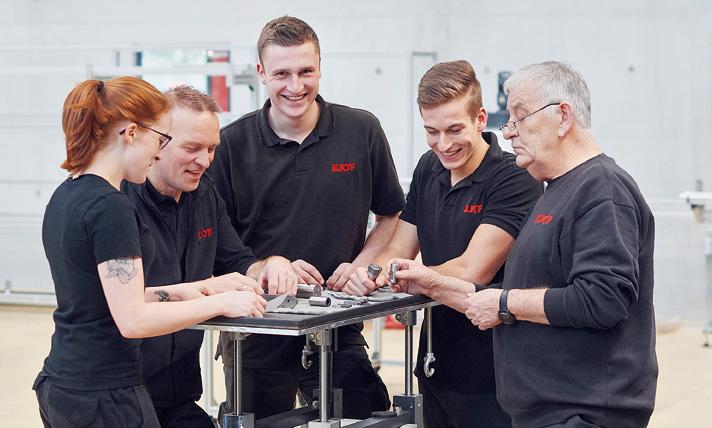
2010
The EJOgreen project aims to counteract the increase in energy consumption. Of course, with increased production, more energy is also consumed, but the aim is to permanently reduce the share of the cost volume. To this end, an energy management system is introduced so

that costs can be accurately allocated to the polluters. Employees are also called upon to participate in energy reduction suggestions.
2010
Inauguration ceremony and production start-up “Holz-Weber Halle” Bad Berleburg. The building’s old stock is integrated as much as possible and the segmentation of technologies is pursued. Building fasteners at in der Aue, Engineered Plastic Components in Berghausen and the screw production in Bad Berleburg.

01 >> 2022 EJOT moment 68
>>Text: Andreas Wolf
PEOPLE AT EJOT
“I have always been particularly interested in technology”, says Georg Dickel, who completed his apprenticeship as a technician after leaving school at the agricultural machinery school in Warendorf. At home he helped with the farming and worked in his parents’ haulage business before he started working for Adolf Böhl in 1968. In the 1970s, he switched to the heading department. At the same time, plastics production began in the basement. “I can remember it well when I walked through the factory shed with the first manufactured buckets.” The use of the first two die, three blow headers in Berghausen brought considerable progress from a technical point of view. Hans Werner Kocherscheidt purchased the two machines before having received any customer orders. “We approached this technology, did trials and when we were finally ready for series production, we recorded the results on graph paper”, Dickel recalls.
Everything developed further in the 1970s: the technical office was set up, two-shift operation was introduced, staff discussion groups were set up to pass on information. “The authoritarian foreman was becoming more and more obsolete at this time”, Dickel reports. Employees were given more responsibility in their work areas, which also increased motivation overall. Initial inspection plans were drawn up, set-up operations on the machines and tool wear were documented. The first carbide die-plate had a capacity of up to 300,000 parts. “That was a revolution”, Dickel emphasises. The use of two-die-plate, three-stroke presses was expanded and the employees were better trained.
Until 1989, when the first Formax multi-die header FX 3 (12171) was delivered from National Machinery in the USA. There were no orders for three blow formings at this point. Nevertheless, this step was also an investment in the future, with which EJOT was creating the basis for technological leadership in forming technology. The first five-step header FX 5 (12172) was purchased in 1991. “We practised on these machines until we were competent with the new, very demanding technology”, says Georg Dickel. “In addition, there were training courses in the USA. Not all competitors managed this technical leap at the time and many gave up”, Dickel recalls. With the use of the Formax headers, the use of materials is also expanded: “We formed stainless steel, which was enormously difficult at the beginning.” The composition of the wire was then closely examined and an incoming goods inspection was introduced. Many things were optimised and further developed during this time.
Machine setter and foreman in the heading department, shift supervisor, department head and most recently, from 2010 to 2012, Georg Dickel was production manager at the “In der Aue”
2010
EPD for all ETICS anchors: The EPD includes the assessment of products (synonymous also for product groups, systems, etc.) with regard to their environmental compatibility.

EPD stands for “Environmental
site in Bad Laasphe. In addition, there was a lot of training and further education, also in the USA at National Machinery. As a sought-after specialist, Georg Dickel remained with EJOT even after reaching the age of 65. In Mexico and Türkiye, he set up machines and trained colleagues. In the learning workshop at the Herrenweise site in Bad Berleburg, which is equipped with modern machines, Georg Dickel passed on his knowledge to the trainees. His experience has immense value at EJOT.
Cooperation with Hermann Großberndt, who revolutionised plastic screw fittings with the invention of the PT ® screw in the 1970s and who significantly developed and promoted further technical innovations, was formative for Georg Dickel. “EJOT was very lucky to find this man. A fine person”, as Georg Dickel says. Großberndt’s joy of experimentation has never diminished and he and his colleagues have always embraced a culture of mistakes. “Dealing with mistakes in the right way leads to reaching the goal faster.” That was one of Großberndt's defining statements, which Georg Dickel has remembered to this day. Or: “One shouldn’t just record and write down what works, but also what didn’t work.” Adolf Sonneborn, the long-term plant manager at Adolf Böhl in Berghausen, remains particularly memorable as both an individual and another influential figure.
Georg Dickel has experienced a lot in 53 years at EJOT. Not only technical challenges and innovations. His many anecdotes and stories could almost fill a book. The screws that fell from the truck, scattered over two to three kilometres on the country road at the Rhine-Weser Tower. “We went there with five men and swept everything up.” Or the the holiday interruption when he travelled from the North Sea to Berleburg after a “call for help” to help colleagues set up a machine. “When the first 50,000 screws were done, I went back to my wife at the North Sea.”
He particularly remembers September 11 2001, the terrorist attacks in New York and Washington. On September 9th, he had planned to visit Niagara Falls with a colleague after a training visit. Bad weather. They decided not to go for it and did not extend their stay by one day, but flew from Detroit to Chicago and took a plane back to Germany on the evening of September 10th. When the first passenger aircraft crashed into the North Tower of the World Trade Center on September 11th, Georg Dickel was lying in bed at home, asleep.
2011
Product Declaration”. EJOT is the only anchor manufacturer to have its complete ETICS program declared with an EPD and has thus documented its performance leadership and pioneering role to the industry.
Rationalisation in Wittgenstein: Expansion of the “In der Aue site” in Bad Laasphe with the production of the construction screw, highlighting the special importance of the site as the central construction screw production site in Germany. The building is inaugurated with an open house day.
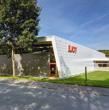
EJOT moment 01 >> 2022 69
E
From apprentice to technical manager licensing
When Fabian Unterweide started his apprenticeship as an industrial mechanic at EJOT at the age of 16, he had no idea that a few years later he would leave his small hometown in the rural district of Siegen-Wittgenstein. It was one of the most important decisions of his life, both privately and professionally: Going to Mexico as an expat for several years.
In 2005, Fabian Unterderweide decided to train as an industrial mechanic at the EJOT site in Bad Laasphe. He decided early on that he would like to pursue a practical profession in industry. He immediately chose EJOT as the largest and bestknown employer in the region. One year after completing his apprenticeship, he decided to complete a technician’s course in night school while working. At this time, EJOT planned to recruit a junior staff member for the joint venture in Mexico. “That was my luck. It was perfect timing”, he says.
When he began his technician training in 2010, Fabian Unterderweide moved from the Production department to the International Processes department and went through all the production areas at the German production sites in preparation for his assignment abroad. “That way I was able to learn an incredible amount. During this time, I made numerous contacts in the company”, he says. This allowed him to clarify many things directly with his colleagues in Germany, which was very helpful for him in his daily business later in Mexico.
In October 2014, his three-year stay at EJOT ATF began. With a three-month Spanish language course under his belt he travelled to San Luis Potosí, a large Mexican city with about 900,000 inhabitants in north-central Mexico and the location of EJOT ATF. “My language skills were just enough to survive”, he jokes and laughs. “For the basics, like saying ‘hello’ and
‘bye’ and ordering food.” But that didn't worry him at the time. “I used to be very hesitant to speak English – I never had that in Spanish.” Abroad, he learned to just speak without any inhibitions. Today, he speaks fluent English and Spanish. He is convinced: “Communication in the native language is the key to close and trusting cooperation with my colleagues in Mexico, especially in manufacturing.”
At EJOT ATF, he was responsible for production, the acquisition of new machines, project management and the implementation of new processes from 2014 to 2017. He describes the local culture as very open and warm: “Here the motto is ‘mi casa es tu casa’ – my house is also your house. And that is really how they live”, he explains. “I was welcomed like a member of the family from the first day. Mexico is now a second home for me.”
He returned to Germany in October 2017. In April 2020, he moved to the position of Technical Manager in License Management. In this role he supports production roll-outs of EJOT patented products for licensees, acts as the contact person for technical questions and problems and introduces new production technologies.
But Mexico didn’t let him go. Fabian Unterderweide has been back in Mexico since November 2021. He currently works 50
2011
EJOT is awarded as Supplier of the Year by Continental. The prize recognizes the best of the global company’s more than 900 strategic suppliers. At the “International Purchasing Manager Meeting”, which was attended by around 140 Continental Automotive

buyers from all over the world in Frankfurt, Continental’s Executive Board Chairman Dr. Elmar Degenhart emphasized the importance of firstclass partners for Continental as one of the world's leading automotive suppliers.
2011
Since May 2011 EJOT has a company page on Facebook. Once or twice a week photos, short reports about EJOT, links to newspaper articles in which EJOT is mentioned, or current job advertisements are posted.
01 >> 2022 EJOT moment 70
>>Text: Eva-Maria Homrighausen
PEOPLE AT EJOT
percent for EJOT ATF and 50 percent in a management role for EJOT License Management. So he spends up to eight months a year in Mexico and comes to Germany for four weeks every three months. A well-functioning model: “For ATF, it is important that I regulate and advance things on site. While I can easily control the technical license management from Mexico”.
Today Fabian Unterderweide is 32 years old. Going abroad as an expat at a young age was a formative experience that he
would not want to miss. “My day-to-day work as an industrial mechanic would certainly be different today”, he says. A time that has helped him both professionally and personally: “I became much more independent and have grown significantly”, he says and adds: “In addition, I met my fiancée in Mexico.” For Fabian Unterderweide, the opportunity to work as an expat in Mexico is a success story both in his professional career and private life. E
2012
EJOT Italia with a new company. Activities in Italy began as early as 2001. After the sales in the area of ETICS and Building Fasteners have grown strongly, the company invests in its own building with warehouse.


2012
Environmental certification for EJOT TEZMAK concluded. The Istanbul location is the first international production site with ISO 14001 environmental certification.
EJOT moment 01 >> 2022 71
Fabian Unterderweide (front row, 3rd from left) with his Mexican colleagues from EJOT ATF.
Machines are his passion
At work, Thomas Prasse’s heart beats for FORMAX ® machines. They are the pinnacle of multi-die headers. “Mechanics and machines have always fascinated me, but the FORMAX ® is the ultimate,” says the 44-year-old, who quickly familiarised himself with the details of this type of machine after joining EJOT in 2000.
Today, Thomas Prasse has become a specialist for the FORMAX ® headers with special orders. With his passion for mechanics and technology, he’s the perfect fit for EJOT. Good thing, too, because it was only by happenstance that his career path led him to Bad Berleburg.
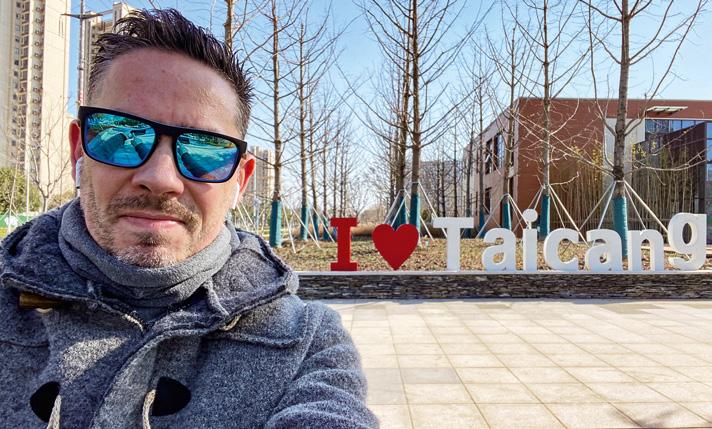
When the Berlin Wall fell on 9 November 1989, Thomas Prasse was twelve years old. He grew up in the small district town of Zittau in the extreme southeast of Saxony, where Germany, Poland and the Czech Republic converge. After the fall of the Berlin Wall, he completed an apprenticeship as a body and
2012
Prognosis program ALTRA Calc: EJOT also offers a solution for the area of light metal fastening with the ALtracs Plus screw. This is now supplemented by the ALTRA Calc prognosis program. Customers can send calculation orders free of
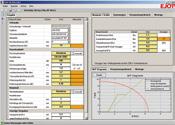
charge via the Internet. These will be processed by qualified EJOT employees and the results will be returned to the client via e-mail in the form of so-called calculation reports.
2012
New ETICS anchor STRU 2G. After a successful market start in 2003, the ejotherm STR U has developed into one of the most successful products of the EJOT Group. The new member of the ejotherm family, the “STR U 2 G”, is the result of this
01 >> 2022 EJOT moment 72
>>Text: Eva-Maria Homrighausen
PEOPLE AT EJOT
vehicle builder at the age of 16. In his spare time, he was active in professional motor sports for many years. During his military service at the Stralsund naval base, he trained as a ship operations technician and sailed the world over on the frigate Köln (named after city of Cologne).
While he was sailing the seven seas in 1999, the labour market situation in his home village became increasingly worse and his parents decided to leave Saxony. The family came to Bad Berleburg through family contacts. Thomas Prasse could not look for a new job while at sea, so his father got him an interview at EJOT. Then everything happened very quickly: he got off the ship shortly before Christmas, conducted the interview and in January 2000 started working for ‘old master’ Georg Dickel at the Herrenwiese site in the manufacturing area of the 2 die 3 blow headers.
The department quickly noticed that he was helpful, hardworking and enthusiastic about technology. Technical functions and processes came to him quickly: “For me, a machine works similarly to an engine, which made it very easy for me to understand the machines,” he said. Within a short time, he made a name for himself in the company as an accomplished header operator and two years later switched to FORMAX ® machines for multiple blow parts.
In 2007, a new FORMAX ® machine had to be accepted at the manufacturer National Machinery in Tiffin / Ohio, USA. In recognition of his good work, Thomas Prasse was commissioned to carry out machine acceptance on site for a week. “I was mighty proud to be trusted with that. A great and formative experience for me – and the first time I ever flew in my life,” he explained. At that point, he didn’t speak a word of English: “As an East German student, I had only had Russian lessons,” he said. “I was incredibly grateful that EJOT sent me.” The crucial test was a success and was the go-ahead signal for many more short stays abroad in Mexico, the USA and China.
In 2011, Thomas Prasse prepared for a one-year position as an expat at the Chinese subsidiary EJOT Fastening Systems in Taicang. There he would, among other things, assist in setting up the Chinese tools on a new FORMAX ® machine. For this, he completed a six-week intensive English course with a stay abroad at Oxford House College in London. Before setting off, Thomas Prasse wrote down the most important phrases in a small notebook, but he left it at home. “I was very excited,” he said laughing. “But luckily I somehow managed to give the taxi driver the address of my host family.”
Working at various EJOT locations abroad has since become routine for Thomas Prasse. Hans Werner Kocherscheidt was a major influence on his decision to go to China for a year and made it clear to him how important this technical support at the foreign locations was for EJOT. The senior boss, who passed away in 2017, often dropped by the production department and greeted the colleagues with a handshake: “What you all do here on the multi-die headers is a fine art. You are true artists.” An extraordinary personality, Prasse emphasised.
Thomas Prasse is certain that, thanks to EJOT and his stays abroad, he has matured a lot and developed significantly as a person. “It gets you thinking; it changes your perspective on many things in Germany. I was very fortunate to be able to take a lot of the things I learned with me – be it in dealing with people, languages or foreign cultures.”
The progress and successes at the Taicang site in recent years and the good cooperation with local colleagues are what drive him. He said: “I put all my energy into the Taicang project. Because it is important to me. Because I realise that it brings EJOT and me further.” His visa for China is valid until the end of 2024: “That’s how long I need on site to implement everything as planned and to achieve our goals.” E
extensive development process. The advantages for the customer are improved efficiency and reduced thermal bridging.


2012
EJOT supplies the drilling screws for the new protective shell that seals the dilapidated sarcophagus of the nuclear reactor in Chernobyl that was damaged in 1986. This is a prestigious order that requires the highest quality competence, especially since the new protective shell is to seal the nuclear reactor for the next 100 years. Regional and national newspapers report as well as radio and television.
EJOT moment 01 >> 2022 73
Around the world in 30 years
First EJOT U.K. in Leeds, then EJOT Middle East in Dubai, and finally EJOT-Octaqon in New Delhi. In the 30 years that he worked at EJOT, Dirk Homrighausen was always drawn to work abroad.

Apparently, he already had the affinity to move from Wittgenstein out into the world during his training as an industrial sales clerk. After completing his training and military service, he spent eight months at the then British subsidiary EJOT ECOFAST in Leeds in 1991. A bit homesick at first, he went on to write in a report in the employee magazine WIR Verbinder at the time.
The uncertainty then very quickly gave way to total enthusiasm. After his return, Dirk Homrighausen had only one thought: “I want to go back to England.” But that turned out to be a bit difficult at first because Bruno Kayser, Head of Human Resources at EJOT at the time, had entirely different plans for the then 21-year-old: Dirk Homrighausen was to be built up as an employee who could be deployed universally from sales departments to controlling. “Of course, this plan by Bruno Kayser unsettled me in my own plans,” Homrighausen recalls. Dirk Homrighausen then arranged for his return to England with the help of Don Fox, the CEO of EJOT ECOFAST in Leeds at the time, after Don had consulted with Bruno Kayser. Bruno Kayser gave his consent to the young Dirk Homrighausen at a colleague’s wedding party over a beer at the bar: “You can go to England. But you have to promise me to stay with EJOT.” Two months later, the journey started with North Sea Ferries across the English Channel to Leeds to EJOT ECOFAST.
The trip turned out to last 16 years. In 2007, Dirk Homrighausen left the national company EJOT U.K., founded in 1985, as Managing Director. First he gained experience as a field worker in the sale of window screws, followed by positions as Commercial and Sales Director with overall responsibility for the construction area, as General Manager and finally, from 2000, as Managing Director with overall responsibility for the EJOT U.K. branch office, then totaling 58 employees.
A three-year break from EJOT followed. Dirk Homrighausen and his wife Jackie, whom he met in England in 1995 and married in 2000, fulfilled a dream: converting an old farmhouse in France and renting it out as a holiday home. They found their dream property 60 kilometres east of Bordeaux, in the Aquitaine region. They realized another business idea by importing and selling Frenchstyle furniture: “When we wanted to furnish our house, we realized that there wasn't much between furniture from IKEA and furniture made from French oak.” Apparently many felt the same way, and the two discovered a gap in the market.
The contact with EJOT remained. Michael Hofmann reported regularly with interesting projects. The return to Germany and EJOT was sealed quite quickly. Dirk Homrighausen took over the business development as Sales Director International for the region of Southeast Asia and India with many trips to the regions that offered excellent market opportunities, especially in the construction industry. But of course, as a long-term solution, this back and forth was not feasible. Without a permanent presence in the region, this market could not really be served in the long term.
On the recommendation of Dirk Homrighausen and the associated business plan, the national company EJOT Asia Pacific was founded in Singapore in 2012. Dirk Homrighausen moved to Dubai with his wife Jackie to take over the management of EJOT Middle East there. Here, too, the 54-year-old did development work for EJOT. “We started with seven employees, later there were 19 at times.” As Operations Manager, his wife Jackie was responsible for the introduction of SAP at the site, among other things. Dirk Homrighausen and his team made sure that the EJOT brand could develop into an industry leader in the region. The most successful new product was the JT2 C1000 (today EJOguard), a series of
2012
2012
The Wittgenstein Education Center undergoes fundamental renovation. The Bildungszentrum Wittgenstein was established in 1975 by nine companies (amongst them EJOT) as a training shop for their apprentices. The objective was a training facility
where Wittgenstein companies from the metal, electronics and later also plastic industry were able to introduce the apprentices to the work during the first year of their career.
01 >> 2022 EJOT moment 74
>>Text: Andreas Wolf
PEOPLE AT EJOT
Open House in San Luis Potosi Mexico for the customers. This shows the commitment of ATF and EJOT to the Mexican site.
construction screws with a short development time, which originated in the Middle East. Some of EJOT's largest airport projects were supplied with JT3 screws during this period in the Gulf region.
During his successful work in Dubai, Dirk Homrighausen was already looking to India to research the market opportunities for construction screws there and at the same time to set up sales.
This time, too, it quickly became clear: “It doesn’t work without being there, it doesn’t work without an EJOT site,” emphasizes Homrighausen. A country of 1.3 billion people, 65 percent of whom are under the age of 35. A country that is building up an industry and has China as a model – meaning it does not want to remain a country of imports. “Anyone who wants to be successful in India in the long term should also have their production there,”
says Dirk Homrighausen. And so the journey continues to India: At the beginning of 2019, Dirk Homrighausen and his wife Jackie and their three dogs, a 12-year-old Cocker Spaniel from the time in France and two Salukis, greyhounds from the Middle East, move to New Delhi.
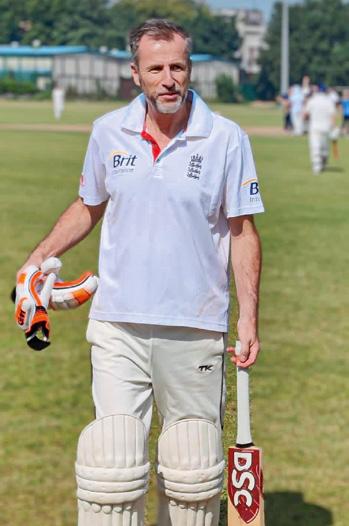
From “glitz and glamor” in Dubai to New Delhi and a completely different culture, in a country full of contrasts: A visible economic boom, on the one hand, with average growth rates of over 5 percent, and, on the other hand, people who live in the poorest of conditions. Added to this is the extremely strong and persistent air pollution, especially in New Delhi. “It takes a lot of getting used to and has nothing in common with western lifestyles,” Dirk Homrighausen points out. Social networks work very well among expats in Delhi. “There is a lot of contact with people of various different nationalities and you make friends very quickly.” In terms of sport, Dirk Homrighausen has dedicated himself to the popular Indian sport of cricket and is a member of the Delhi Expat Cricket Club “The Viceroys”.
The EJOT-Octaqon Fastening Systems production branch has 35 employees, most of whom are trained specialists with experience from other fastener manufacturers. In the area of sales, experience from the industry is important.
The expert knowledge of EJOT products is trained internally. “We are in a permanent recruiting process, not only because of our strong growth, but because the people here often only think very short-term,” explains Dirk Homrighausen. If the salary is two or three percent higher somewhere else, there is a risk of losing an employee. Nevertheless, the employees value the fact that EJOT-Octaqon is a multi-national company and is managed by a Western manager: “That looks good on the CV.” The employees can also relate to EJOT’s 100-year history, since traditional companies in India generally have a good reputation.
“EJOT will continue to be successful with its products in India.” In this regard, Dirk Homrighausen has a very positive forecast. “We have unique selling points, we are the first quality manufacturer of self-drilling screws in India.” There is nothing comparable. And the investments to be made in infrastructure in India over the next few years are enormous. This is not only good for our business in India, but also for the continuous international growth of the EJOT Group. E
2013
Start of the eCommerce sales channel. The new channel has to be integrated into the existing organisation which involves concepts for designing order processes, dovetailing with logistics processes, or outlining a suitable pricing structure.
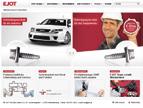
2013
Opening of the new building at EJOT Taicang in China with a ”Grand Opening“ and 300 invited guests. Optionally, an area expansion of 11,000 m2 is possible on the site.

EJOT moment 01 >> 2022 75
EJOT is a family matter for the Hauer household
The Austrian Managing Director Jürgen Hauer has been working for EJOT for 30 years. He has experienced a lot over the years and draws a clear conclusion: There is nowhere he would rather work than in the family business EJOT.
EJOT is a family business. In the case of the Hauer family in Voitsberg, this is to be taken literally. Because there was a time when the entire Hauer family was employed at EJOT Austria: Father Jürgen has been working for EJOT Austria as a long-standing CEO since 1992 and will retire in summer 2022. His wife Anna joined in 1994 as the head of HR. She has been retired for a year now. Daughter Julia has been working in marketing at EJOT Austria and the Southeastern Europe region for years and will be returning from parental leave in autumn. And last but not least, son Thomas also worked at EJOT in Voitsberg during his studies and was also employed at EJOT Construction Fasteners in Germany for a time.
30 years at EJOT – Looking back on his time at the company, Jürgen Hauer says: “Discovering EJOT was like winning the lottery for me.” “But,” the 62-year-old admits, “if you take responsibility seriously, like I do, you are running at full speed around the clock, which isn’t always healthy.” When he retires he says he will allow himself more time to rest – and to spend with his family and friends.
The Japanese are to blame. As QA manager of the ATOMIC company in 1990, he first became aware of EJOT. And how else could his EJOT story begin, than with the search for a special screw joint: The largest Japanese importer of his then employer, ATOMIC, asked that the heels of the ski boots manufactured by the company not be fastened with nails, but with a plastic screw so that the heel parts could be replaced. “While researching potential suppliers, I came across EJOT thanks to the plastics supplier Du Pont,” says Hauer. However, because the responsible EJOT sales representative never showed up at ATOMIC, Jürgen Hauer
called the EJOT export manager at the time, Wolfgang Basedow. Very soon Wolfgang Basedow and the EJOT sales manager at the time, Bernhard Reck, were sitting in the office in Köflach with Jürgen Hauer and solved the connection problem on the ski boots. “And over a nice dinner, the foundation for my future at EJOT was laid.”
His future at the company was sealed during a job interview in the sweltering summer heat of 1991 in Bad Berleburg, when Jürgen Hauer and his wife Anna were extensively interviewed by Hans Werner Kocherscheidt, Christian Kocherscheidt, Bruno Kayser, Bernhard Reck and Wolfgang Basedow. “I was slightly nervous and was greatly relieved that Hans Werner Kocherscheidt created a familiar atmosphere with his brilliant way of conducting the conversation.” And after the interview, we had dinner together. “A toast was made to my future at EJOT with a glass of champagne – it was my first glass ever,” laughs Jürgen Hauer.
Whe he started at EJOT, Jürgen Hauer completed a three-month training course covering the entire technical program: production in Bad Laasphe, Applitec and all other departments. “I learned a lot back then from Peter Hau, who had started the training programme a little earlier than me,” says Hauer. Hauer not only experienced something new during the day, but also at dinner at the Hotel Fasanerie in Bad Laasphe: “For the first time in my life I saw that you can also eat a Wiener Schnitzel with sauce, the Wittgensteiner Krüstchen.”
Jürgen Hauer started as an application engineer for fastening technology in Austria in January 1992. “I took the Austrian market by
2013
EJOCLEAN clean room Bad Berleburg. The orders for goods packed according to special requirements become more extensive. For this purpose, a two-part space is set up. One area is used for packing of finely cleaned goods (ISO class 8), the other area is a clean room for secondary packaging (ISO class 9 ).
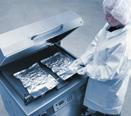
2013
EJOT supplies over 10,000 sandwich screws for state of the art distribution centre in Erlensee near Frankfurt. The cladding is made with a high-quality sandwich panel facade system with 200 millimeters of insulation thickness. More than 10,000 EJOT stainless steel screws are used to fix the facade.

01 >> 2022 EJOT moment 76
>>Text: Andreas Wolf
PEOPLE AT EJOT
storm with the service that EJOT was able to offer its customers thanks to the support of the export department and the technical office.” The customer meeting was scheduled in the morning, and the draft including the offer was already delivered to the customer by afternoon. “It was just perfect.” For two years Jürgen Hauer was on the road as a “lone wolf” before his wife Anna and Eugen Perisutti joined him. When EJOT Austria GmbH was founded in 1999, the company had seven employees. The sale of EJOT building products followed. The number of employees increased continuously – there are currently 65 at the Voitsberg site. Since 2000, EJOT Austria has established branch offices across Southeastern Europe: Croatia (2001), Serbia (2003), Hungary (2003), Bosnia (2007) and Italy (2010). A total of 144 employees work in the region. Jürgen Hauer sees the motivation and freedom of the employees as the key to this strong growth: “Everyone should be allowed to demonstrate their entrepreneurial skills,” says Jürgen Hauer. Workers shouldn’t simply receive orders and act according to rigid
specifications, but should be allowed to use the freedom to help shape success and failure in equal measure.

After 30 years at EJOT, the mountain bike tours organised by Christian Kocherscheidt across the Alps and the fantastic bike tours in Mallorca organised by Wolfgang Bach are still fresh in the memory. “Those were great experiences.” The visits to the foreign companies also remain firmly in Jürgen Hauer’s memory. Getting to know the country, its people and their cuisine: “That has enriched my life a lot.”
Is EJOT still a family business? “Yes”, says Jürgen Hauer. Of course, the larger a company gets, the more difficult it becomes to maintain the family character the way it used to be. But the feeling of working in a family business has remained to this day. “The owners look after their EJOT family in an exemplary manner and are interested in the people who work there.” E
2013
In 2013 the EJOWELD ® strategy project became a separate business unit. With this step EJOT is now on the path from fastening element manufacturer to system supplier of friction welding equipment. The first plant delivered is used in the production of the Audi Q7.
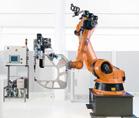

2013
Opening of the Automotive Center Südwestfalen GmbH. This represents an important step towards networking the local automotive supplier industry, the university of Siegen and the technical university Südwestfalen. The research facility is equipped with state-of-the-art technology for the study and further development of lightweight automotive construction.
EJOT moment 01 >> 2022 77
Balancing act between Germany and the Middle Kingdom
The summer of 2020 was the original end date for Charlotte Haas’ China project, but the outbreak of the COVID-19 pandemic at the beginning of 2020 cut the project short. For 14 months, the 32-year-old headed a project designed to transfer the international EJOT standards of the engineering department to the Chinese subsidiary EJOT Fastening Systems in Taicang.
Atask which the young industrial engineer found both interesting and challenging. While she still managed to implement some new measures with her colleagues in Taicang, even though she was stuck in Germany during lockdown, the next challenge already awaited her: Becoming the youngest plant manager in the entire EJOT Group, Charlotte Haas took charge of the Bienhecke site in Bad Laasphe, Germany, a plant with a total of 43 employees. She was responsible for the extensive realignment and renovation of the aging building complex.
Charlotte Haas’ professional career at EJOT started in 2014 as a project management trainee. She worked for a total of three and a half years as a project manager for EJOFORM® FORGINGS, a customer-specific technology for cold-formed parts made of steel, aluminium or copper. In project engineering – a department which plays a significant role for the engineering department, design engineering and manufacturing, as well as quality management –she learned a lot about procedures, processes, and interface management.
When the transfer of the international standards of the engineering department to the Chinese subsidiary EJOT Fastening Systems in Taicang was pending in 2018, she took charge of the project management. In her new role, she flew to China every two weeks for 14 days over a period of 14 months. It proved to be an exhausting, physically demanding time for Charlotte, with flights as long as 12 hours and a 6 hour time difference on top: “I was more physically
2013
With the conversion of the CAQ system to a multi-language capable software, the link between the worldwide production locations is expanded and improved with regard to quality-relevant processes.
The CAQ system is a software for
test data acquisition, incoming goods inspections, for first sampling, rejection management, inspection equipment etc. and supports more than 450 employees of EJOT in their work every day.
resilient than I thought”, says Charlotte. From her time in competitive sports she knew that she could demand a lot of herself. As a teenager, she raced for the German squad in snowboard cross for several years before deciding to train as an industrial clerk at the age of 18 and quit competitive sports.
A permanent move to China was out of the question for her due to personal reasons at that time. Despite the long hours spent travelling, she saw the continual trips between China and Germany as the key to the project’s success: “I was constantly visiting both sites and was able to pick up on and situate issues during each visit relatively quickly.” At the Chinese site, Charlotte deliberately chose to move into an office in the immediate vicinity of production rather than be hid away in the upper floors of the building. She wanted to have direct contact with the employees she oversaw:
“It was very important to me to work closely and openly with my Chinese colleagues,” she says. “The fact that I put on safety shoes and went to inspect the machines with my colleagues from the office caused some surprise to the Chinese employees, who come from a more hierarchical business culture,” she says and laughs.
There are still a few anecdotes that make her laugh even today: On board a boat trip to Shanghai with an EJOT colleague, she was once asked on deck by a Chinese man if he could take a photo with her. She politely agreed to the photo, but before she knew it, every Chinese person on deck was asking for a photo with her –
2014
New construction of the finished goods storage in Bad Berleburg. The eye-catching red cube, which is clearly visible from all sides, houses the new automatic small parts storage system from EJOT. A complex conveyor system is built inside.

01 >> 2022 EJOT moment 78
>>Text: Eva-Maria Homrighausen
PEOPLE AT EJOT
she thinks it must have been her “light blond hair” that did it. She can't remember anything else from the rest of the boat trip
In April 2020, six years after joining the company, Charlotte Haas took over as the plant manager of the Bienhecke site. The building complex located on the site is set to be completely renovated with a total investment of 4 million euros by 2024 and will undergo strategic realignment. As plant manager, she is responsible for optimising the areas of electroplating, hardening, maintenance, incoming goods, the sorting of micro

2014
2014
screws and the complete renovation of the production halls. There are many complex procedures, processes and manufacturing methods for Charlotte to familiarise herself with, but she is quick to adapt to her new environment: “Where others stop asking questions, that’s where I come into my own.” Charlotte Haas and her experienced team are shaping and developing the site for the future. So that none of her team at the site get left behind, it is important to her to always be fair and authentic: "I want to move forward quickly, but I don't want anyone to be left behind in the process." E
EJOT is one of the world market leaders.
“They tend to work in small towns rather than large cities, are independent, very innovative and cosmopolitan despite all ties to their homeland.” This is how North Rhine-Westphalia’s Economics Minister
Garrelt Duin characterizes the region’s “hidden champions” in his foreword to the brochure “World Market Leaders and Best Industrial Performances from South Westphalia”.

EJOT moment 01 >> 2022 79
Foundation of the joint venture LPS-EJOT India together with the GFA partner Lakshmi Precision Screws, one of the largest screw exporters in India.
How it all began with the “nail shack”
Today, when people talk about the beginnings of production in 1922, they often refer to the “nail shack” – in German “Nagelbude”. That is where Adolf Böhl, at the age of 33, had started producing nails: Behind his parents' house on Berghäuser Street in the village of Berghausen near Bad Berleburg. The first nail press was in his workshop, where he worked as a cartwright. The craft that he was no longer able to practise due to a back injury from the First World War.
Wilhelm Herberg, a wartime comrade from Dahle near Altena in Westphalia, persuaded Adolf Böhl to start producing nails. Herberg operated a factory for the production of wire and cold-rolled strip that was already technically advanced for the time. The friend from Altena provided the necessary expertise as well as the first used nail press.

The connection to Altena should never be broken and runs like a golden thread through the 100-year history of the company. This is where the future owner Hans Werner Kocherscheidt grew up and went to school. From Lennewerk in Altena came various personalities who have significantly shaped the development of the company over the decades – in both commercial
2014
ASYST Technologies LLC has experienced strong growth over the past several years. Due to new developments in the lighting business unit (headlamp adjustment systems) and a good economy sales are increased. Due to the additionally required
manufacturing capacity, an expansion of 4,400 m2 is planned. The largest part of the area becomes production area. A larger tool shop and additional offices are also planned.
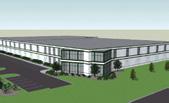
2014
Foundation of the joint venture EJOTFEY Sistemas de Fixação Ltda. in Brazil. EJOT Systemas de Fixação becomes EJOT FEY. Together with the Brazilian screw manufacturer Metallurgica Fey, the new joint venture EJOT Fey is founded. Both partners bring
01 >> 2022 EJOT moment 80
>>Text: Andreas Wolf
HISTORY
Hans Werner Kocherscheidt with Adolf Sonneborn, who had a decisive influence on the development of the Adolf Böhl company over decades.
Adolf Böhl
Adolf Böhl, born on 31 December 1889, was the second oldest child of the farmer and cartwright Ludwig Böhl and his wife Katharina. While his brothers Heinrich, Gustav and Fritz became teachers, Adolf Böhl initially continued the trade of his father, who died early. A back injury he sustained during the First World War prevented him from continuing his physically demanding work as a cartwright. On the side, Adolf Böhl did some farming.
His war comrade Wilhelm Herberg from Dahle near Altena supported him in setting up a production of nails and also arranged the purchase of the first used nail press.
Adolf Böhl was mayor and local group leader of the NSDAP in Berghausen municipality for twelve years. He had joined the NSDAP because he saw no other way out in the turmoil of the 1920s and early 1930s with unemployment high and the economy in crisis. During this time, Adolf Böhl served not only his parish but also his company with a great sense of social and Christian responsibility.
At the beginning of the Second World War, he had at last recognised the criminal nature of the Nazi regime and made his comments in the closest of confidence, which was dangerous. He suffered under the very National Socialists whom he had initially trusted. Adolf Böhl went to church every Sunday, which was completely unusual for a local group leader. He did this out of religious conviction, but it was also a way to make his position known.
In 1945, Adolf Böhl was detained by the Allied occupation authorities because of his political office. During the almost three years of internment, his wife Luise passed away. After returning from internment, he married Martha
Frank from the Laasphe district of Bernshausen in 1948. This marriage also remained childless.
Adolf Böhl treated his employees like family members. It is said that he had the machines shut down during heavy thunderstorms and gathered together with his employees for prayer in the production hall. At Christmas, he invited his employees to his home and gave each of them an individual gift, including for their wives and children.
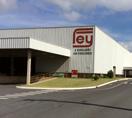
In 1960, Adolf Böhl became seriously ill and died at the age of 71. He had previously transferred his company and the rest of the property to his nephew Hans Werner Kocherscheidt. Hans Werner Kocherscheidt was already working as a lawyer in Bad Berleburg at this time.
added value in the new joint venture enterprise: FEY knows about the market and conditions there, EJOT has a world known product port-folio with corresponding application technology.

Note from the editor: There are no direct contemporary witnesses known to us from the early history of the Adolf Böhl company, and hardly anything has been recorded from this period. During the research, we used material from the 75th anniversary edition of the EJOT employee magazine, conducted interviews with descendants from Berghausen, looked through book publications we knew about the Berghausen municipality and editions of the Wittgensteiner Kreisblatt, and referred to stories from Hans Werner Kocherscheidt.
Hans Werner Kocherscheidt had a trusting relationship with his uncle Adolf Böhl, which led to many joint discussions, especially about the National Socialist era.
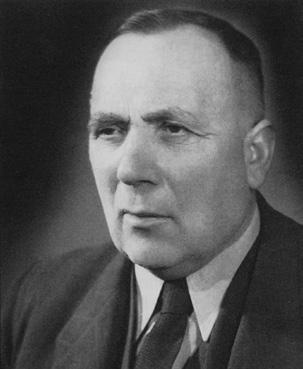
2015
EJOT & Avdel in Sweden celebrates its 25th anniversary. It all started with two white garden chairs in an office, dedicated and knowledgeable people, supported by the best manufacturers of screws and rivets. Now after 25 years, the staff is equally dedicated and skilled, numbering almost to forty coworkers, and since beginning of this year EJOT & Avdel is fully owned by EJOT.
EJOT moment 01 >> 2022 81
>>Text: Andreas Wolf
PORTRAIT
and technical terms. To this day, long-term wire suppliers of the EJOT Group are located in Altena.
The beginnings of nail production were very modest. It soon became apparent that the workshop, where a second nail press had been installed in the meantime, was unsuitable. In the issue of the Wittgensteiner Kreisblatt newspaper from 11 February 1924, an official announcement states that Adolf Böhl applied for “approval from the trade police to erect a factory building with a turbine system” on his property in Trufte. The water from the Trufte stream was to be dammed up in an existing feeder and used to drive a turbine.
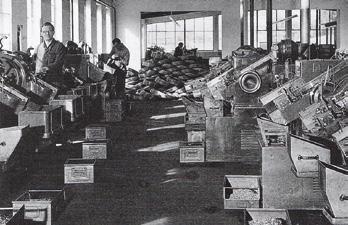
In 1926, Adolf Böhl moved production to a small new building in the Trufte, where he could rely on licensed hydroelectric power. The company developed very slowly in the early years. This may also have been due to the fact that Adolf Böhl had neither specialised technical knowledge nor any previous commercial training. Another reason was the very remote, primarily agricultural location. Even the severe recession of the 1920s with high unemployment was not a good basis for establishing profitable production For example, the employees were also temporarily employed in agriculture, during hay harvesting, gorse cutting or broom binding.

Contemporary witnesses say that Adolf Böhl was actually “all thumbs”. It is said that he always had good people in his company, even from the pre-war period. Adolf Böhl's brother Gustav, head of the village school in Berghausen and organist in the church, was more technically adept. After school, Gustav Böhl always walked to the Trufte and helped his brother in the business. He did not have a car.
In 1928, Adolf Böhl succeeded in hiring Heinrich Henk, a native from Wittgenstein with knowledge of wire processing. Henk had acquired his knowledge at the company called Knipping in Altena. The company Knipping later became Lennewerk, the cradle of sheet metal screw production. Another skilled worker was the locksmith Wilhelm Wagner from Berghausen, who was soon able to make pinching tools for the pin presses. In 1935, when the company had four employees, Adolf Böhl hired a 16-year-old young man, Adolf Sonneborn from Berghausen, who later had a decisive influence on the company’s fate for over 50 years. He had just graduated from business school and was first of all happy to have found an employment opportunity. His love of flying led him to serve in the air force during the war until 1945. Having returned in 1945, he did his apprenticeship as a toolmaker and passed his master craftsman’s examination in 1953 with the grade “very good”. The mas-

2015
New heat treatment plant in TambachDietharz. Long lead times and insufficient capacities have so far led to considerable backlogs for customers. This changes with the investment in the fifth hardening line.

2015
EJOT Tech Center opened in Detroit. The new EJOT office is inaugurated with a very successful opening ceremony. The new rooms in Wixom are equipped with one application technology laboratory for thread-forming screws and
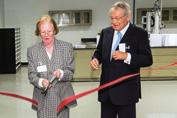
01 >> 2022 EJOT moment 82
HISTORY
terpiece he presented was a cutting-edge spindle for cutting wood screw threads, the operation of which was later widely used in the company.
The first company vehicle was an American Jeep, with a flatbed in the back and a cabin in the front – with versatile use: the neighbours were invited to pick blueberries in Neuastenberg and sat on the flatbed in the back.
Between 1935 and 1939, sales revenues for nails deteriorated. The company switched to the production of screw nails. A manually operated flat jaw roller was purchased for this purpose. The production of screw nails remained an important mainstay of the company until the 1960s. In addition, wood screws were also produced from the end of the 1930s, which led to an expansion of the company with the acquisition of new machines. The company was entered in the Siegen Commercial Register in 1938.
Production stagnated during the Second World War, and operations were temporarily suspended towards the end of the war. As mayor and local group leader of the NSDAP, Adolf Böhl was classified as “NS-incriminated” by the American occupation authorities and was detained from 1945 to 1948. During this time, the company was under the trusteeship of Otto Stahlschmidt. Production was gradually resumed after the war, under extremely difficult conditions. The economy mostly ran only through barter transactions. For example, butter had to be procured in order to get wire in Altena. On the other hand, good consideration had to be given to what was suitable for ready-made screw products as an exchange.
Even after the currency reform, the operational situation was difficult. Money was very scarce, the economy did not yet flourish. At the beginning of the 1950s, the situation improved and led to the number of employees increasing to about 60 by 1960, with an annual turnover of two million DM.
Adolf Böhl passed away at the age of 71. His nephew Hans Werner Kocherscheidt took over the business in 1960. Hans Werner Kocherscheidt invested in the company and, among other things, created the basis for modern, more competitive production with the purchase of two high-performance double printing presses from the company National. As a “beginner” in this business, this daring investment put a lot of mental strain on him at the time, it is said. Investments were also made in the financial and EDP administration.
Production changed from wood and slotted screws to case-hardened sheet metal and chipboard screws. There was fierce competition in the small screw market. The good economic situation at the beginning of the 1960s was followed by a recession that led to many insolvencies in Germany. However, Hans Werner Kocher-
scheidt and his team succeeded in winning new customers during these difficult times. When the economy picked up again, it became clear that investing in new machines early on was the right thing to do.
After the acquisition of the Eberhard Jaeger factory in 1965, the sheet metal screw production was moved from Berghausen to Laasphe. But sheet metal screw production was also under considerable price pressure.
Even then, Hans Werner Kocherscheidt focused on diversification and innovation - in contrast to the low-cost strategy pursued by most small screw manufacturers. He invested in the development and manufacture of construction screws, which managing director Kurt Machate had pushed significantly. In construction technology, extreme lightweight construction with steel and aluminium sheets developed during this time.
In 1971, with the intention of further diversification, the Adolf Böhl company received a second mainstay with the addition of a plastic injection moulding plant, which developed alongside screw production. In addition to technical moulded parts, connecting elements in a combination of plastic and metal were soon being manufactured.
At the end of the 1970s, this product range was expanded to include the manufacture of elements for fastening in the field of thermal insulation in house construction, which soon led to independent development and an increase in capacity. In this sector, the Adolf Böhl company developed into the market leader and covered about 80 percent of the German demand with its fastening elements for thermal insulation.
Towards the end of 1978, the Eberhard Jaeger company succeeded in applying for a patent for an independent development, which later became a market-leading product: self-tapping screws for thermoplastics, which have come to be known under the name of EJOT PT® screw. The PT® screw became the market and technology leader.
This was the beginning of a new era. Today one would say that “EJOT 2.0” was created. With the invention of the PT® screw, the sales philosophy changed: the customer is not only supplied with a part, but from now on also with the complete application technology. Contact persons for customers are no longer only the buyers, but primarily development managers and designers. This sales strategy, which is new in the industry, was also implemented in the marketing of construction screws. E
one for friction element welding. We hope that our two fastening technologies for auto body lightweight design – FDS® and EJOWELD® – will take a hold in North-America.
2016
• Opening of plant 2 at EJOTATF Fasteners de Mexico
• Grand opening of the light weight design tech centre at EJOT Japan L.L.C. in Kawagoe
2016
The Construction Fasteners division is strategically new aligned. Part of this realignment is a new name. The division is now named “Construction Division” the DWF business unit is named “Building Fasteners” and ETICS is now the business unit “ETICS Fasteners”.
2016
The first issue of the new customer magazine “moment” is published. In future, the new magazine will be published twice a year.
EJOT moment 01 >> 2022 83
The cradle of the clever (EJOT) heads
There has been a close connection between EJOT and the town of Altena in Westphalia for 100 years. Especially in the period after 1960, there were quite a large number of Lennewerk employees who moved from Altena to Wittgenstein to work for Adolf Böhl or Eberhard Jaeger, bringing with them a great deal of technical know-how.
The solidarity with Altena, which has grown over decades, was expressed in July 2021 when employees of the German EJOT locations as well as the Kocherscheidt family of shareholders donated 135,000 euros for victims of the flood disaster. 40 percent of the streets in the city area were severely damaged, as were numerous houses; people lost their belongings; company buildings were completely under water – including those of long-standing wire suppliers of the EJOT Group.
Flashback to the founding year 1922: Wilhelm Herberg, who ran a wire drawing mill in Altena-Dahle, supported Adolf Böhl in the first steps towards implementing nail production in Berghausen and also arranged the purchase of the first used nail press. A few years later, Adolf Böhl hired another expert, Heinrich Henk, who had acquired his knowledge of wire processing at the Company called Knipping (later Lennewerk).
Hans Werner Kocherscheidt, born on 7 October 1928 in WerdohlKleinhammer, attended the secondary school for boys in Altena before being drafted as an air force helper at the age of 15. He graduated from high school in 1949 and went on to study law.
Shortly after Hans Werner Kocherscheidt took over the company from his deceased uncle Adolf Böhl in 1960, he maintained close contact with the technical director of the Lennewerk Altena, Dr. Wevelmeyer. “You cannot run the company from your office, you need a managing director, a man on site. ” This is how Dr. Wevelmeyer is said to have advised Hans Werner Kocherscheidt and at the same time recommended a potential managing director in Kurt
Machate, then an authorised signatory at the Lennewerk Altena. Hans Werner Kocherscheidt published a job advertisement tailored to Kurt Machate. Far be it from him to simply poach the authorised signatory of Lennewerk.
In fact, Kurt Machate moved to Berghausen to join Adolf Böhl as the new managing director in 1963. A stroke of luck for the company. Machate was a businessman par excellence and also had considerable technical understanding. Step by step, Machate gave the Adolf Böhl company recognition. Together with plant manager Adolf Sonneborn, he formed an excellent team that started off with dedicating itself to the expansion of sheet metal screw production and later also to the production and marketing of the chipboard screw. Steady growth during this period leads to the Berghausen site becoming the largest manufacturing location for drilling screws in Germany in the 1980s.
After Kurt Machate, Winfried Hayn and Bruno Kayser also moved to Berghausen to join Adolf Böhl. Many years earlier, Machate was Hayn's and Kayser's superior at Lennewerk. The idea of bringing this successful “triumvirate” together again in Berghausen was put into practice. Machate, Hayn and Kayser had excellent knowledge of the screw industry as well as its distribution channels and clientele.
In 1980, Bruno Kayser became a member of the management board, responsible for purchasing, sales and personnel. In 1990, Bruno Kayser also took over the commercial responsibility for the Tambach screw factory acquired by EJOT and played a significant role in the economic development of the site in Thuringia.
• EJOT receives the award TOP 100 Innovator.
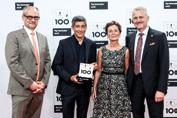
• 38 new Apprentices in Germany
• The 15th International Licensee Meeting for plastic fastening takes place in Hamburg, Germany.

01 >> 2022 EJOT moment 84
>>Text: Andreas Wolf
HISTORY
2016
• 20th anniversary EJOT Switzerland The round birthday is celebrated with a big party in Dozwil.
• Start of production at the Brazilian joint venture company EJOT-FEY in Indaial.
Manfred Volkmann was head of production until 1998, first in Berghausen and later in Astenbergstraße in Bad Berleburg – he also came from Lennewerk.
Hermann Großberndt and Kurt Ociepka made for two more employees who came from Lennewerk in the town of Wittgenstein to Eberhard Jaeger in Laasphe. Kurt Ociepka was a trained confectioner and initially worked as a journeyman baker. He switched to Lennewerk and was trained there as a presser because the pay was higher. Ociepka had just started a family. Two years later, the engineer Hermann Großberndt followed, who was considered a proven expert and whose research in the field of drilling screws resulted in patents.
Hermann Großberndt was the plant manager of Lennewerk with responsibility for several hundred employees. In Laasphe at Eberhard Jaeger, where about 30 employees were working at this time, Großberndt had more time for the practice; the amount of administrative tasks was much less.

Großberndt became technical director at Jaeger and invented the PT® screw (Plastic Thread) in 1977, which is suitable for self-tapping into plastic. In production, Kurt Ociepka was one of Hermann Großberndt’s most important employees with a “fantastic feel for the machines”, as they say. Other former Lennewerk employees that transferred to Eberhard Jaeger were, amongst others, Fritz Stephan, Otto Franz, Günter Thee and Reinhold Henkel. E
2017
In the course of a strategic expansion the EJOT Group has acquired Sormat, a Finnish manufacturer of high-quality heavy load fasteners. Sormat is now part of the global EJOT Group of companies.
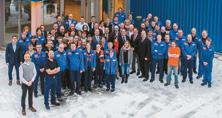
EJOT moment 01 >> 2022 85
German Wire Museum Altena
Source: © Märkischer Kreis/Phtographer: Klaus Sauerland · CC BY-SA
2016
Christian Schäfer completes his training as a tool mechanic at the Berghausen site with the grade “very good” and becomes the national winner with the best score.
A strategic coup: the merger of Böhl and Jaeger
In 1946, Eberhard Jaeger founded his screw factory in a barrack that had served as accommodation for French prisoners of war during the war and which he had rented from the Reichsbahn for 15 Reichsmarks per month.
To make the tools for the production machines, he was able to use machines in the Mirella locksmith shop, which was two kilometres away and owned by his father. The initial set of machines consisted of a Hilgeland double-blow header CH00, a slotting machine TV0 and a thread roller TR0.
The procurement of materials was problematic during this time. The wire suppliers were located in the Altena, Werdohl and Lüdenscheid area. Occasionally, Eberhard Jaeger collected the material from wire drawing factories with a “tempo tricycle”. This was a small load vehicle frequently used at the time, which had two rear wheels and a front wheel directly driven by a two-stroke engine, with which it was also steered. He used it to drive the 200 km round trip, summer and winter.
Before production could begin, they had to wait for the allocation of so-called iron certificates. Therefore, the young company initially specialised in the production of brass screws. This material was not rationed like the iron materials. In addition, there was also the possibility of obtaining brass wire from parents' and grandparents' businesses.
The incoming orders in January 1946 were around 200,000 brass screws; by April, 3 months later, 1.2 million. In 1953, the company moved into a new building with a production hall and office building at Bienhecke in Laasphe. At that time, the company had six employees. As early as 1957, the company invested in a electroplating plant and opened up the possibility of applying zinc, copper, brass and nickel coatings to the screws.

The company was granted a water abstraction and re-injection permit for the immediately neighbouring Banfebach stream for the operation of the plant, under the mandatory condition that they detoxify and neutralise wastewater.
At that time, Eberhard Jaeger KG produced almost exclusively slotted screws with metric threads according to DIN, but these came under increasing price pressure in the 1960s. One cause of the price pressure in the slotted screw sector was that the manufacturing industry began to switch from slotted screws to the more advantageous Phillips-head screws.

The end of an era. At the age of 88, Hans Werner Kocherscheidt died on Good Friday, 14 April, after a short but serious illness. With his entrepreneurial vision, his drive and his gift to inspire people for himself and for his ideas, he has developed the EJOT Group from a small screw factory to a successful global company.

01 >> 2022 EJOT moment 86
2017 Inauguration Poland factory. With the new plastic production at EJOT Ciasna in Poland another important construction project has been finished. The factory was planned according to the most modern standards.
>>Text: Andreas Wolf
HISTORY – FROM 1946
2017
Eberhard Jaeger
 >>Text: Andreas Wolf
>>Text: Andreas Wolf
The Jaegers were an entrepreneurial family that was well-known beyond Laasphe and had grown over several generations. The oldest company founded with the Lüdenscheider Metallwerke dated back to 1879. After completing secondary school, Eberhard Jaeger received his first practical insights into his grandfather's company, the Busch-Jaeger company in the Berleburg town of Aue.
After studying mechanical engineering, he worked at AEG in Berlin. Eberhard Jaeger then took over the technical management of his father’s company. His father Wilhelm Jaeger had bought the factory called “Mirella” from the mill owner Otto Strack in Laasphe in 1930. Initially, coal cookers and later electrical household appliances were produced there.
Soon after his return from war imprisonment in autumn 1945, Eberhard Jaeger left this father’s company to set up his own business. Together with his wife Margarete, the 36-year-old founded Eberhard Jaeger KG in 1946.
Margarete Jaeger came from a long-established Lüdenscheid industrialist family. Her father managed the Westfälische Kupfer- und Messingwerke AG in Lüdenscheid, where she completed her commercial apprenticeship before spending two years in England to improve her language skills. After the founding of Eberhard Jaeger KG, she was responsible for the commercial area and looked after their four daughters. Her husband was responsible for the technical area.
However, in order to manufacture them, a production licence was required, which entitled the holder to purchase or manufacture header dies and measuring tools and with which production know-how was also acquired. The electrical industry was a little more reserved about this change, especially with regard to screws for contact terminals. For this reason, however, a considerable, highly specialised competition had already established itself due to the immense market demand. The company Jaeger was therefore urgently looking for a niche product that would lead out of the price crunch.
These were extra-long slotted screws used in the manufacture of switching relays for telecommunications and control tech -
2017
Start of the digitalization project: EJOT responds to the rapidly advancing change with central projects. Aiming to provide customers with more and better services, to increase the productivity of the plants and to improve training, quality and knowledge in all areas.

nology. In 1962/1963, therefore, investments were made in further machinery, as well as in a 450-square-metre extension. However, the expected market demand for extra-long screws decreased again in the following years. In order to compensate for this misery, Eberhard Jaeger introduced new items such as screws made of stainless steel and especially difficult double-blow formed parts into production.
At that time, the American screw industry already had much cheaper production machines and processes than in Europe. These were increasingly exported to Europe by American machine and tool manufacturers since the beginning of the 1960s. American high-performance headers produced about
2017
The production hall 4.0 at the Herrenwiese site in Bad Berleburg is inaugurated. The decision for the new building and the machine set-up in the hall is closely connected to the outstanding success of the EJOFORM® product group.

EJOT moment 01 >> 2022 87
PORTRAIT
twice the amount of screws per unit of time compared to European headers. The screw industry gradually switched to the American machines.
In 1965, Eberhard Jaeger sold his company to the Berleburg-based lawyer Hans Werner Kocherscheidt, owner of the Adolf Böhl screw factory in Berghausen near Bad Berleburg. His company, like Eberhard Jaeger KG, produced mainly metric slotted screws. Their sales were in different market sectors than Jaeger’s, which meant market expansion for Böhl. Furthermore, 22 employees with relevant knowledge were available, which was otherwise difficult to find in the region. In addition, there was a permit to operate the electroplating plant,
which could be used for both companies after appropriate expansion. In 1965, turnover at Eberhard Jaeger AG was about DM 1 million.
Böhl and Jaeger
In order to improve the unfavourable production conditions that had arisen due to the many less lucrative small orders for slotted screws, some of the orders with more favourable batch sized were initially transferred from Adolf Böhl to Eberhard Jaeger in Laasphe. A little later, Jaeger also took over the entire sheet metal screw production from Böhl. But even this mass product, which required only slightly more vertical integration, was under considerable price pressure.

2017
The joint venture EJOTATF Fasteners de Mexico in San Luis Potosi, which was founded ten years ago by EJOT and ATF Inc. from Lincolnwood/USA, is a real success story. Over the years, various measures have been taken to expand and optimize production, including a new heat treatment plant.

2017
National winner Victoria Muth: The 23-year-old completes her training as a materials tester specializing in heat treatment technology with 93 points and the grade “very good”, making her the national winner.

01 >> 2022 EJOT moment 88
HISTORY – FROM 1946
Although the smaller range and cheaper production sizes led to a better overall result, it became apparent that this “ageing” product group would not be a sustainable business base.
At the end of the 1960s, a technique originating in the USA and Canada began to establish itself in the building industry in Europe as well: extreme lightweight construction with steel and aluminium profile sheets. Special screws had already been developed in the USA for fastening the profiled panels, which could be up to 14 metres long, to the steel or wooden substructure. They were made of austenitic stainless steel to resist corrosion, and because the profiled sheets could only be installed from the outside of the building, the screws had to form their own female threads. These 'sealing screws' were imported from the USA at a high price.
Inspired by the Canadian ALCAN-Aluminium, Böhl carried out the first production trials, which were immediately successful with regard to the thread forming properties of the screws. A “know-how licence” from Cleveland (Atlas Bolt & Screw) significantly shortened this development time to production. The production of construction screws was relocated to the Jaeger factory in Laasphe and became an important mainstay of the company over the next few decades. In 1968, a new production and storage hall with a floor area of approx. 700 square metres had to be added for the production of construction screws.
During this time, Jaeger products were still sold from the central sales office in Berghausen. However, the distribution of the construction screws showed that it was advantageous or even necessary to supply practical know-how in application.
In 1971, the “Bauschrauben” sales department was therefore relocated to Laasphe, where an office extension with an area of 270 square metres was built. This product needed explanation on the market because it was new. This placed new demands on the company's market presence. Salespersons and employees with experience in construction technology were hired for the field service. External warehouses were operated and more intensive, technically sophisticated advertising was carried out: strategies that were completely foreign to the small screw industry at that time.
Diversification and innovation became overarching goals that both companies then pursued. In contrast to this, the low-cost strategy, which was consistently pursued by most manufacturers of small screws, increasingly took a back seat at Böhl and Jaeger in favour of an innovative quality strategy. E
2017
Winfried Schwarz, Managing Director of EJOT Holding GmbH & Co. KG, is retiring. The 68-year-old lawyer was responsible for Personnel, Legal Affairs, Public Relations, Environmental and Building Management and, until 2014, also for the Engineered Plastic Components division.

2017
In April, the new location of the national subsidiary EJOT Hungaria near Budapest is completed.
2018
Foundation of the new Canadian EJOT subsidiary in Cambridge/Ontario. Sales are mainly focused on roof and wall fasteners, industrial window and facade technology, anchoring technology and solar fasteners.

EJOT moment 01 >> 2022 89
Historically grown EJOT on expansion course
In 1984, the EJOT logo is introduced for all previously existing company names. In the same year, EJOT Baubefestigungen GmbH is founded with headquarters in Bad Laasphe. EJOT expands in Europe with its first sales offices in the UK, Norway and France. The company continues to pursue a strategy of expansion and even founds its own production companies.
The EJOT Group also expands its operations in Germany, opening a second production site in Bad Laasphe. In 1993, EJOT takes over the Tambach screw factory in Thuringia, making it one of the largest manufacturers of small screws in Europe. The awarding of DIN ISO 9001 and DIN EN ISO 14001 certifications demonstrates the high quality standard at EJOT. At the Bad Berleburg site, production is also expanded with the commissioning of a new production hall.

In 2000, the reorganisation of the group structure takes place, with the connection of the companies to the EJOT Holding GmbH & Co. KG and the establishment of an advisory board for the holding company. In the course of further international growth in Europe, America and Asia, the first Asian production facility EJOT Fastening Systems in Taicang, China, and the joint venture EJOT ATF in Mexico are founded. The new logistics centre of the Building Fasteners division is put into operation in Bad Laasphe, Germany. As a family-owned business, ensuring EJOT employees find a healthy work-life balance is a top priority for the company. The certificate “audit berufundfamilie” (work-life balance) is awarded to EJOT in 2011.
The following years are also characterised by the worldwide growth of the EJOT Group, combined with intensive construction activity of modern industrial architecture. The most important projects in 2013 are the inauguration of a new production hall in Taicang, China, the construction of the logistics centre and production hall 4.0 with a learning workshop in Bad Berleburg and the opening of Tech Centres in Detroit, USA, and Tokyo, Japan.
As a founding member and co-shareholder, EJOT is involved in the Automotive Center South Westphalia (acs) in Attendorn, Germany, a platform for research and development work and the exchange of knowledge between car manufacturers, suppliers and university institutes in South Westphalia. EJOT formally becomes part of the German innovation elite and in 2016 is announced as a “TOP 100” German medium-sized business at the “Deutschen Mittelstands-Summit” (German medium-sized business summit).
With the death of Hans Werner Kocherscheidt in April 2017, EJOT loses its founder, who, with his tireless dedication and entrepreneurial vision, made the EJOT Group, with then 3,150 employees worldwide and annual turnover of over 530 million euros, what it is today.
The year 2018 starts with a strong economic tailwind. Virtually all industrial sectors in Europe are working at maximum capacity due to a combination of successfully won customer projects and a generally strong demand across the entire supply chain. Screw production increases to 10.5 billion parts. While the situation in the automotive industry becomes increasingly bleak in the course of the year, developments in the construction industry continue to be positive.
At the Tambach-Dietharz production site, 2018 marks the 25th anniversary of the site's affiliation to the EJOT Group and the plans to expand the site are announced. At the heart of this development is the modernisation and expansion of heat and surface treatment. Another milestone for the Tambach-Dietharz site is reached with
2018
New HR6 machine prototype is presented. The HR6 is a new development of a heading-rolling machine combination After several years of planning and design phase, the first two prototypes were put into operation.
2018
Ground-breaking ceremony for new production hall at Tambach-Dietharz site. The area of surface technology is being expanded The functional areas
EJOMAT, final inspection, dispatch, workshop maintenance, electrical workshop, technical rooms as well as a goods depot with four HGV-docking stations will be relocated to the 4,400 m2 hall.
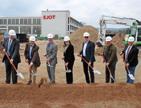
01 >> 2022 EJOT moment 90
>>Text: Andreas Wolf
HISTORY – FROM 1946
the “rate adjustment” project. It is decided that the working hours and pay levels of employees are to be brought up to western German standards in three stages. For its THREAD FORMING division at the Tambach-Dietharz site, EJOT is awarded for its “outstanding site development” in the renowned “Factory of the Year” competition.
In the industrial sector, a patent application is filed for the newly developed EVOT PT®, the third generation of the PT® family. Capacities for further international growth are also extended. In Poland, work begins to expand the new production building, which had only been inaugurated in the previous year. In San Luis Potosi, Mexico, the expanded production area is put into operation and in Delhi, India, employees start work at a new production hall and warehouse.

EJOT stands its ground in an increasingly difficult economic environment – for the EJOT Group, the year 2019 can be summarised in these words. Trade conflicts and the Brexit destabilise global markets. 2019 reaffirms that the EJOT Group has two stable pillars in the automotive and electrical industry and the construction industry. In addition, the international positioning of the EJOT Group helps to offset the local risks of individual markets. Annual turnover increases to 540 million in 2019 and the number of employees reaches a new all-time high at 3,600.
Hopes are high for the business year 2020. Order levels are high and employees are enthusiastically completing customer projects. Then the COVID-19 pandemic hits. At the production site in Taicang, China, production comes to a halt. In Europe, there is still hope that the spread of the virus can be stemmed and controlled. Sadly, this hope does not materialise. By mid-March, Germany also goes into lockdown. A wave of order cancellations follows. EJOT is also in crisis mode. Sales projections are drastically lowered and a restrictive savings plan is introduced. All business activity that does not directly lead to sales and earnings is carefully examined. EJOT's successful management of its finances following the 2008/2009 financial crisis pays dividend and the company has a financial cushion for such crises. Company efforts are focused on maintaining its delivery capacity, a goal which in turn is achieved. By the summer, the situation improves again, but by autumn worsens considerably. In November, 1.1 billion parts are produced – a new company record. In a great joint effort, EJOT overcomes the difficulties of the crisis year of 2020 surprisingly well. E
For more on the history of EJOT, please also see our timeline on all pages of this centenary edition of the EJOT customer magazine.
2018
EVO PT ® – Successor to DELTA PT ® is presented. At the licensee meeting, the results of the new EVO PT® were officially reported for the first time. The third version of the screw for direct fastening in plastics – an area in which EJOT has earned a reputation as a world market leader through its predecessors PT ® and DELTA PT ®.

2018
EJOT established the joint venture ClickBuild together with Wierig Profiltechnik GmbH. The common objective is to develop an Internet
platform that can be used to simplify the most important steps in the refurbishment of hall roofs. The project was discontinued in 2021.
EJOT moment 01 >> 2022 91
PT ® screw revolutionises the screw market

For customers and competitors it is the EJOT screw. The PT ® screw, invented in the 1970s. No other product is connected with EJOT as much as the PT ® screw. It has a special thread suitable for fastening most of the thermoplastic materials known at that time. It was a revolution in the screw market.
2018
New company collective agreement for TambachDietharz: As the first company in the metal and electrical industry in eastern Germany, EJOT, headquartered in Bad Berleburg, will adjust weekly working hours and remuneration to West German levels for its employees at the production site in Tambach-Dietharz in Thuringia.
2018
25 years of EJOT Tambach and the “Outstanding Site Development” award. The business unit Thread Forming at the location in Tambach-Dietharz receives the award in the category “Outstanding Site
Development” in the “Factory of the Year” benchmark competition. A success story for the 25th anniversary, which will be celebrated in December.
01 >> 2022 EJOT moment 92
>>Text: Heinrich-Georg Homrighausen and Andreas Wolf
For the first time, the PT ® made it possible to fasten into plastics without having to pre-form a female thread, use the failure-prone and expensive metal inserts or the sheet metal and wood screws that were not process-safe. The Eberhard Jaeger company in Bad Laasphe, Westphalia (Germany), which Hans Werner Kocherscheidt, owner of the Adolf Böhl screw factory, had acquired in 1965, was the think tank for the Plastic Thread, as the name is in full. Both companies merged in 1992 under the company name EJOT Verbindungstechnik GmbH & Co. KG.
The development of direct fastening into plastic is inseparably connected with the engineer Hermann Großberndt. He already attracted attention in the industry in the late 1960s as co-author of the “legendary” sheet metal screw manual. The owner of the EJOT Group, Hans Werner Kocherscheidt, recognised Großberndt's instinct for screws and application technology and was able to convince him to move to Bad Laasphe. Herrmann Großberndt later described the initial situation for the invention of the PT ® screw with his co-author, Kurt Ociepka, in one of his many scientific publications as follows:
“... According to today's state of the art, two types of connections can be made by means of metallic screws:
- Threaded inserts which are either inserted into the open tool and moulded in or are pressed in, screwed in, welded in or dowelled after the parts manufacturing process. The fasteners are screwed into these inserts.
- Screws that form or cut their female thread in so-called screw-in tubes (eyes).
Increasing pressure to rationalise has recently led to the latter process becoming increasingly important. The screws used here are mainly sheet metal screws in various versions (with fine or coarse pitch, in the case of harder thermoplastics also as notched screws or with polygon shaped cross-sections), wood or chip board screws as well as special screw designs (e.g. double helix screws) ...” (article “Self-tapping screws for thermoplastics – thread profiles and screw-in tubes”, 1979)
So in Bad Laasphe, a small team of engineers and technicians led by Hermann Großberndt worked on a screw connection for plastic products. Together with Kurt Ociepka he produced the prototypes and carried out thousands of screw tests by hand. Hermann Großberndt had recognised long before that the sheet metal and wood screws produced by Eberhard Jaeger were unsuitable for plas -
2019
Website Relaunch: At the end of February, the long-planned go-live of our new website took place. In total, 19 local online presences of our international subsidiaries go live in addition to the ejot.com site.

Hermann Großberndt
The development of plastic fastening at EJOT is inseparably connected with the engineer Hermann Großberndt, who died in 1999. He invented the PT® screw on the drawing board and thus closed the important gap he had identified in the joining of plastics.With this screw and the associated application philosophy, EJOT became the industry leader in the field of plastic fastening in the 1980s.
Hermann Großberndt also significantly developed the successor patent, the Delta PT® screw.
Hermann Großberndt also made other discoveries: the invention of the first drilling screw in the 1950s revolutionised fastening technology worldwide.
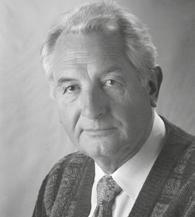
Hermann Großberndt also had a decisive influence on the development of the FDS® screw (Flow Drill Screw), which is used in car body construction to join thin sheets of steel and aluminium with high quality and without a pilot hole.
tics. The market situation became increasingly difficult for EJOT because plastic products were conquering the world, especially in the household appliance sector. A competitor used a screw for fastening into plastics which did not solve the connection problem optimally, but better than the sheet metal screw from EJOT. Because of this, EJOT lost market shares and customers at that time. In light of this, Hermann
2019
The new production hall of EJOT Polska in Ciasna is officially opened. This is the second construction stage of the factory in Poland, which was finished less than two years after the completion of the first plant.

EJOT moment 01 >> 2022 93
Großberndt was in the process of developing a screw that was technically superior to the standard screws for plastics on the market.
At the University of Kassel in the neighbouring state of Hesse, mechanical engineering student Stephan Weitzel, later CEO of EJOT, was also dealing with the problem of fastening into plastics. Hermann Großberndt contacted Prof. Gottfried Wilhelm Ehrenstein through publications of the Chair of Materials Science/Plastics at the University of Kassel. And he referred Hermann Großberndt to Stephan Weitzel, whose diploma thesis at the Institute in Kassel dealt with the subject of “Effects of thread geometry on the quality of screw connections in plastics”. This was the topic that Hermann Großberndt also dealt with intensively. After countless test series, it was finally possible to develop the PT ® screw, as it was later called by EJOT, for fastening into plastic. “The PT ® screw was objectively better and this could be proven by tests,” recalled Stephan Weitzel, who moved to Eberhard Jaeger in Bad Laasphe after completing his studies in 1980.
“My first task was the construction of a test stand where we could work with rotation speeds, just as I had developed and built it at the institute in Kassel as a prerequisite for my diploma thesis,” explained Weitzel. On this test stand it was possible to carry out tests under assembly conditions. This was very important because so much frictional heat was generated during the screwdriving process that the thermoplastics were melted. That's why the PT ® screw worked so well during assembly. All tests in which the screw was screwed in by hand resulted in poorer assembly conditions.
'At that time I gave countless expert lectures and wrote publications about the PT ® screw, which led to all those who had problems with the plastic fastening coming to us,' recalled Stephan Weitzel. These were not buyers, but development managers and design engineers. This resulted in intensive and close customer relationships. The marketing of a product in combination with the complete application technology was born.
But all beginnings are difficult and this was no different: “My business card read Eberhard Jaeger, a company that hardly anyone in the industry knew,” says Stephan Weitzel. In addition, all the experts were very sceptical about the plastic fastening: “I can only warn you against fastening into plastic, it doesn't work,” a wellknown chief engineer of a large corporation had said in a lecture
at the time. And because it was known that it could not be implemented technically, metal inserts were used, with insert nuts or inserts into which a metric screw could be screwed. This was the solution that worked in plastic fastening at the time, but it had a serious disadvantage: it was expensive and heavier than direct fastening with the PT ® screw.
According to Stephan Weitzel, at this lecture event he then carefully pointed out the use of new geometries that had not existed before. He also referred to other test methods with which he had achieved quite good results. The first comment after Stephan Weitzel's speech came immediately from that experienced chief engineer: “Young colleague, I admire your courage. I wish you much success.”
And this success then came about. The word spread quickly in the industry about initial successful applications with customers such as Grundig. The customer received a test report with all the results, which was unique at the time. Stephan Weitzel took care of marketing the PT ® screw for three years before Jürgen Behle, also a graduate of the University of Kassel under Professor Ehrenstein and a proven expert in plastic fastening, joined the team in 1983. Meanwhile, PT ® sales had risen continuously: from DM 1 million in 1981 to DM 3.5 million two years later. In the course of the 1980s, exports to European countries started. France, Switzerland, the Netherlands, Austria and Great Britain, where PSM was the first foreign company to receive a licence to manufacture the PT® screw.
The interesting applications of the PT ® screw at that time were primarily household appliances or the large 1100-litre waste containers. Another important application was in cathode ray tubes in televisions. The large cathode ray tube with its glass body weighed about 15 kilograms. The complex and cumbersome fastening consisted of 28 parts, which were replaced by four PT ® screws. This was a technical revolution “from the Stone Age to a modern age,” as Stephan Weitzel emphasises. All German and European television manufacturers used this technology, later also American and Japanese companies. In the course of this strong demand, further licences for the production of the PT ® screw were granted. The PT ® screw was the market and technology leader.
Development continued at a rapid pace. Since the 1950s, the production of plastic components has grown at an annual rate
2019
The new EVO PT ® screw is presented at the K trade show.

The EVO PT ® is the evolutionary development of self-tapping fastening in thermoplastics. In addition to excellent fastening properties and a large potential for
standardization, only the EVO PT ® offers opportunities for the pre-calculation of torques and clamp loads as well as the clamp load relaxation under temperature and over time.
2019
Establishment of ASYST’s subsidiary in Mexico for plastics production. Mexico is developing into the fifth largest automobile location after the USA, China, Germany and Japan. All leading automobile manufacturers and suppliers are in Mexico.

01 >> 2022 EJOT moment 94
HISTORY
2019
EJOWELD® nominated as a finalist for the “2020 Automotive News PACE™ Awards” The award is regarded as an industry-wide recognized benchmark for innovation and excellence in the automotive supplier segment. The EJOWELD® technology is an efficient and flexible friction element welding for joining materials in mixed and lightweight construction.
of over 8 percent, and in the late 1970s, the world's production of plastic components rose again steeply. An impressive statistic from the incredible world of plastics: world production increased from 50 million tonnes in 1976 to over 380 million tonnes in 2017.
New plastic materials also posed new challenges for fastening technology. The degree of automation increased and new fields of application were assigned to plastics, e.g. in automotive engineering. Oscillations and vibrations, exposure to high temperatures and increased failure requirements consequently raised the bar again for direct fastening. The improved service life of the connection and the desire for predictability were included in the list of requirements for future connection solutions.
Once again it was Hermann Großberndt, CEO of the EJOT Group, who together with Dr. Gottfried König, Head of R&D at the time, laid the foundations for the next generation of plastic fastening technology: the EJOT DELTA PT ®

With the knowledge gained from countless practical applications of PT ® screws in almost all available polymer versions, a new standard was created which revolutionised the market once again. Features such as a higher clamp load, higher tensile and torsion strength, increased fatigue strength and the market innovation, a prognosis programme to enable a clamp-load-oriented design of thermoplastics, convinced customers as well as existing and new licensees in all markets.



How will the history of direct fastening into plastic continue? The trend towards e-mobility as well as mixed and lightweight construction will question designs and material systems that have been developed over decades and find new answers. Autonomous systems, including in the field of aircrafts, demand ever greater perfection and operating safety. In the future, all components and processes along with their data and properties must be able to be digitally mapped and integrated. The demands placed on manufacturing processes and their stability will increase. With the EVO PT ® screw, EJOT has developed the next generation of the PT ® family – with the knowledge of the aforementioned requirements. It also sets new standards in plastic fastening. E
2020
Corona outbreak in China. At the beginning of January, we received the first reports of a novel virus in China. A lockdown follows – first in China, later also in Germany and the rest of the world.

EJOT moment 01 >> 2022 95
2020 FINALIS T
Success story EJOT in Tambach
It has not only technical but also economic and ecological advantages – and it reduces dependence. The new zinc flake coating plant, commissioned in June 2022. Another milestone in the success story “30 years of EJOT in Tambach-Dietharz”.
The contract for the acquisition of the Tambach screw factory was signed in Bad Berleburg on 29 December 1992. This was preceded by negotiations with the Treuhandanstalt in Berlin. 30 years later, in 2022, the plant in Tambach-Dietharz with its 580 employees is one of the growth engines within the EJOT Group, which employs around 3,900 people in 35 countries worldwide. In retrospect, this project is a prime example of the
2020
Expansion in Tambach. The second construction stage of the heat and surface centre at the Tambach-Dietharz site has been completed. The zinc flake system will be installed in this new part of
successful structural transformation of an old nationally owned enterprise (VEB) into a cornerstone within the EJOT Group.
From day one, the Kocherscheidt family of entrepreneurs has invested in modern building technology and production facilities at the Tambach-Dietharz site and relied on the recipe for success that has made the company one of the leading producers of small


2020
the building and is expected to go into operation in 2022. To the side of the new hall there are further offices and meeting rooms.
EJOT Sweden looks back on 30 years of history. The company was initially founded as a joint venture between EJOT and Avdel.
Since 2015 EJOT Sweden is fully integrated into the EJOT group.
01 >> 2022 EJOT moment 96
>>Text: Andreas Wolf
HISTORY
screws in Europe over the past 30 years: high-quality and, where possible, patent-protected products, holistic application technology for customers and a well-developed sales network.
EJOT was and still is a reliable partner for employees. This is backed, for example, by the fact that standard wages have always been paid – and it also includes the fact that EJOT was the first company in the eastern German metal and electrical industry to gradually introduce wages and working hours on par with those in western Germany in 2019. The 35-hour week with full wage compensation has been in effect since 2021. 30 years after reunification, managing partner Christian Kocherscheidt considered this a long overdue step.
At the beginning of the 1990s, EJOT urgently needed to act to expand its production capacities at its two locations in Bad Berleburg and Bad Laasphe. The acquisition of the Tambach screw factory with its well-equipped machinery and the experience of the employees meant that this demand could be met. But this did not mean that the Tambach-Dietharz site was “just” an extension of the work bench. Over the years, EJOT has set up three innovative production areas in Tambach-Dietharz, which set new trends in cold forming, metal-plastic processing and lightweight car body construction.
The THREAD FORMING division, named after its main product range, thread-forming screws, is the largest of the three divisions at the site, with 465 employees, and produces around 3.5 billion special screws annually. In 2018, the business unit received an award in the “Outstanding Site Development” category of the renowned “Factory of the Year” competition run by A.T. Kearney management consultants. “The balancing act between a consistent focus on efficient processes and maximum flexibility for the
2020
EJOT wins DETAIL Product Award

2020 for the substructure system CROSSFIX® for rear-ventilated facades (VHF)
customer is mastered through in-house development of innovative production facilities and in-sourcing of process steps,” reads the jury’s laudation.
The largest investment project began at the Tambach-Dietharz site in 2018. A new production hall was built to expand manufacturing capacity. One focus of investment was the design of a heating and surface centre. In addition, capacity was significantly increased for all heat treatment processes and surface technologies used in screw production. The plans call for a total of 40 million euros to be invested from 2018 to 2026.
The fusion of metal and plastic in one component. Behind this is the EJOSYST ® division, which combines the skills of cold forming and plastic injection moulding, brings high customer benefits and is ideally worth preserving. A unique selling point not only in the EJOT Group but also in the market. What began in 1993 with a handful of injection moulding machines is now the EJOSYST ® division, in whose product range new assemblies and systems are constantly being developed and produced. Das Ziel ist, immer neue Produkte mit hoher Funktionalität und echtem Kundennutzen zu entwickeln. One of these sophisticated system solutions is projects for fastening and adjusting car rear lights or roof edge spoilers. EJOSYST ® products are also installed in the field of electromobility, for example in wall chargers or in various connections of the battery cells and the charging infrastructure.
With good ideas, the will to implement them, trust, a readiness to take risks, tenacity and a bit of luck, outstanding things can be achieved. That is how the project EJOWELD® can be outlined. EJOWELD® is the third division located at the EJOT site in Tambach-Dietharz. A milestone in the 100-year history of the EJOT Group: for the first time, customers are offered a complete system service. With EJOWELD® , the connection technology user has the option to join mixed joints (lightweight material/ high-strength steel) with a robot-compatible friction element setting device without any pre-treatment (cleaning, de-coating, pre-hole) of the joining elements. This technology was first used in series production in the bodywork of the top model in the Audi Q series, the Q7. In the meantime, this technology is not only used in numerous models of the VW Group, but also by numerous other car manufacturers in Europe, North America and Asia. E
2021
In November, construction work began on the new plant in Cercesköy. The construction time will be about 12 months. Installation of the first large-scale facilities, such as electroplating, hardening shop and washing plant, is scheduled to start in July/August 2022.
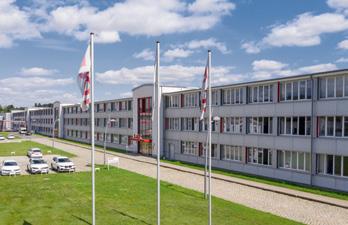
2022
EJOT withdraws from the Russian business and sells the national company Wostok to the local management.
EJOT moment 01 >> 2022 97
EJOT Holding GmbH & Co. KG
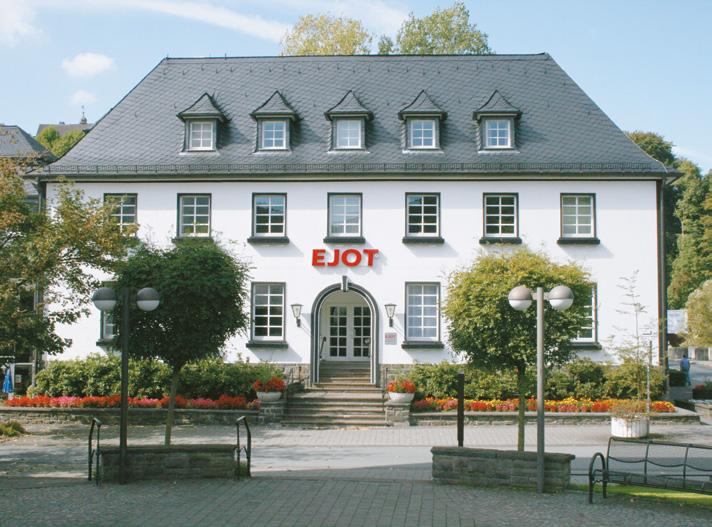
Foundation: 1992
Management:
Christian F. Kocherscheidt, Wolfgang Bach, Ralf Birkelbach, Dr. Frank Dratschmidt, Dr. Rolf Künkel, Dr. Wolfgang Scheiding, Angelika Wetzstein
Employees: 251
Im Herrengarten 1, D-57319 Bad Berleburg Info@ejot.com
01 >> 2022 EJOT moment 98 COMPANIES
EJOT SE & Co. KG
Foundation: 2022
Managing directors: Christian F. Kocherscheidt, Sedat Aricioglu, Wolfgang Bach, Ralf Birkelbach, Dr. Frank Dratschmidt, Dr. Rolf Künkel, Markus Rathmann, Dr. Wolfgang Scheiding, Dr. Jens Weber, Angelika Wetzstein
Employees: 1.848
Location “Herrengarten”
Im Herrengarten 1
D-57319 Bad Berleburg
T +49 2751 520-0 industrie@ejot.com
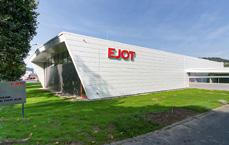

Production facility “Adolf Böhl”
Adolf-Böhl-Straße 7
D-57319 Bad Berleburg
T +49 2751 529-0 industrie@ejot.com
Production facility “Herrenwiese”
Astenbergstraße 21
D-57319 Bad Berleburg
T +49 2751 529-0 industrie@ejot.com
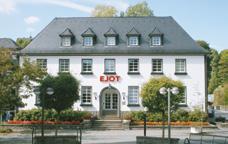
Production facility “Eberhard Jaeger”
Untere Bienhecke 16
D-57334 Bad Laasphe
T +49 2752 109-0 industrie@ejot.com
Production facility “In der Aue”
In der Aue 38
D-57334 Bad Laasphe
T +49 2752 109-210 industrie@ejot.com
Production facility “Tambach”
Im Grund 4
D-99897 Tambach-Dietharz
T +49 36252 42-0 industrie@ejot.com
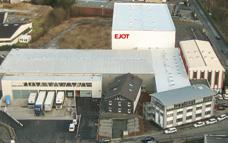


Production facility “In der Stockwiese”
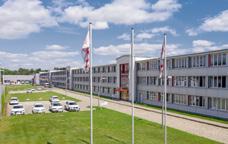
In der Stockwiese 35
D-57334 Bad Laasphe
T +49 2752 908-0 bau@ejot.com
EJOT moment 01 >> 2022 99
UAB EJOT Baltic

Foundation: 2001
Production company
Products Focus:
Market Units Industry
Main Products ETICS and Profiles
Manager: Paulius Žintikas
Employees: 52
Titnago g. 19, LT-02300, Vilnius
T +370 5 23 11-437
InfoLT@ejot.com
www.ejot.lt
EJOT Fastening Systems (Taicang) Co.,

Ltd
Foundation: 2005
Production company
Product Focus:
Market Units Industry / Construction
Management: Christian Arnoldi, Andy Ho, Erich Koch
Employees: 254
No.165 Fada Road, Loudong Taicang, Development Zone, Taicang, Jiangsu Province, P.R. China 215413

T +86 512 53 56 52 90
InfoCN@ejot.com
www.ejot.cn
EJOT Sormat Oy
Foundation: 2017
Production company
Main Products:
Market Unit Construction, Focus on anchoring technology
Manager: Jarmo Aaltonen
Employees: 83
Harjutie 5, FI-21290 Rusko
T +358 207 94 0200
InfoFI@ejot.com
www.ejot.fi
Baltic States
China
Finland
01 >> 2022 EJOT moment 100 SUBSIDIARIES
EJOT-Octaqon Fastening Systems Pvt. Ltd.
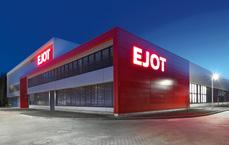

Foundation: 2014
Production company
Product Focus:
Market Units Industry / Construction
Manager: Dirk Homrighausen
Employees: 36
Plot 2 Sector 8, IMT Manesar, Gurgaon, 122051 Haryana, lndia
T +91 1244 694770
InfoIN@ejot.com
www.ejotoctaqon.com
EJOT Polska Spółka z ograniczoną odpowiedzialnością Spółka komandyto
Foundation: 1997
Production company
Product Focus:
Market Units Industry / Construction
Manager: Andrzej Bibik
Employees: 322
Ul. Jeżowska 9, PL-42-793 Ciasna
T +48 34 35 10 660
InfoPL@ejot.com
www.ejot.pl
EJOT Schweiz AG
Foundation: 1996
Production company
Product Focus:
Market Units Industry / Construction
Focus on technical parts
Manager: Ralf Herzog
Employees: 85
Uttwilerstrasse 3, CH-8582 Dozwil

T +41 71 414 52 22
InfoCH@ejot.com
www.ejot.ch
India
Poland
Switzerland
EJOT moment 01 >> 2022 101
EJOT SE & Co. KG Taiwan Branch
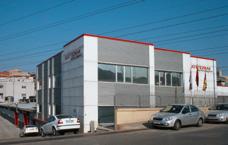
Foundation: 2007
Production company
Branch Manager: Ingo Thiel
Employees: 24
No. 8, Aly. 81, Ln. 296, Xinya Rd., Qianzhen Dist. 80673 Kaohsiung, Taiwan, R.O.C.
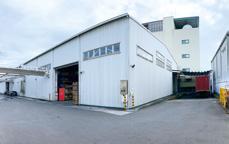
T +886 7 811 08 18
lthlel@ejot.com
www.ejot.tw
EJOT Tezmak
Foundation: 2000
Production company
Product Focus:
Market Units Industry / Construction
Managers: Andreas Radel, Georg Homrighausen
Employees: 212
Cebeci Cad. No. 84, TR-34250 Küçükköy-Istanbul
T +90 212 477 77 92-95
InfoTR@ejot.com
www.ejot-tezmak.com
EJOT U.K. Ltd.
Foundation: 1985
Production company
Product Focus:
Market Units Industry / Construction

Manager: Robert Hardstaff
Employees: 90
Hurricane Close, Sherburn-in-Elmet
Leeds LS25 6PB.
T +44 1977 68 70 40
Info@ejot.co.uk
www.ejot.co.uk
Taiwan
United Kingdom
01 >> 2022 EJOT moment 102 SUBSIDIARIES
Türkiye
EJOT ATF Fasteners de México y Compañía, S. en C.

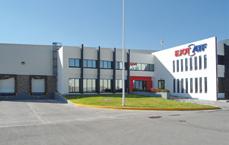
Foundation: 2007
Production company
Product Focus:
Market Unit Industry
Manager: Paulo Teixeira
Employees: 216
Av. Del Siglo No. 180 , Parque Industrial Millennium, San Luis Potosí S.L.P., C.P. 78395 México
T +52 444 8 70 82 00
info@ejot-atf.com
www.ejot-atf.com
Mexico
ASYST Tecnologías de México
S. de R. L. de C.V.
Foundation: 2021
Production company
Product Focus:
Market Unit Industry, Automotive Focus on headlamp adjustment systems
Manager: Gerold Hackenbracht
Employees: 15
Calle Tres No. 105-1, Parque Industrial Millennium, San Luis Potosí, SLP., C.P. 78395 México
T +52 444 459-0900
infoMX@asysttech.com
www.asysttech.com
ASYST TECHNOLOGIES, LLC
Foundation: 1996
Production company
Product Focus:
Market Unit Industry, Automotive Focus on headlamp adjustment systems
Manager: Gerold Hackenbracht
Employees: 175
5811 99th Avenue, Kenosha, WI 53144 USA
T +1 262 8 57 22 44
infoUS@asysttech.com
www.asysttech.com
EJOT Fastening Systems L.P.
Foundation: 2013
Distribution company
Product Focus: Market Units Industry / Construction, Focus on EJOWELD and construction screws
Manager: Edward Plomer
Employees: 22
48679 Alpha Dr, Suite 110, Wixom, MI 48393 USA

T + 1 248-773-7453
infoUS@ejot.com
www.ejot-usa.com
EJOT-FEY Sistemas de Fixacao Ltda.
Foundation: 2012
Production company
Product Focus:
Market Unit Industry
Manager: Edemilson Tomaselli
Employees: 25
Rod. BR470 – km 73,63 – n°3620 – Galpão 02
Bairro Estradinha
CEP 89083-285 Indaial, SC – Brasil
T+55 47 3301-7000
info@ejot.com.br
www.ejotfey.com.br
Brasil
EJOT Sistemas de Construção LTDA
Foundation: 2022
Distribution company
Product Focus: Market Unit Construction
Manager: Yalçin Cihan
Employees: 10
Av. Caminho de Goiás, nº 100 Bairro Jardim São Bento, CEP 13.214-870 - Jundiai, São Paulo, Brasil
InfoBR@ejot.com
EJOT moment 01 >> 2022 103
USA
Foundation: 2016
Distribution company
Product Focus:
Market Unit Industry
Manager: Fumio Ishizaki
Employees: 4
1742-1 Yamada, Kawagoe-Shi Saitama-Ken, 350-0822 Japan
T +81 49 227 9131
InfoJP@ejot.com
www.ejot.co.jp
Foundation: 1999
Distribution company
Product Focus: Market Units Industry / Construction

Managers: Dr. Andrea Camola Jochen Maaß
Employees: 62
Grazer Vorstadt 146, A-8570 Voitsberg
T +43 3142 27 600-0
InfoAT@ejot.com
www.ejot.at
Foundation: 2006
Distribution company
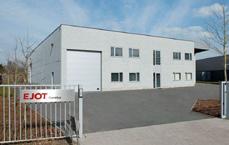
Product Focus:
Market Unit Construction
Manager: Samuel Schouppe
Employees: 12
Reedonk 19-1, B-2880 Bornem
T +32 3 740 79 70
InfoBE@ejot.com

www.ejot.be
Japan
Austria
01 >> 2022 EJOT moment 104 SUBSIDIARIES
EJOT JAPAN L.L.C
EJOT Austria GmbH & Co KG
EJOT Benelux bv / srl
Benelux
EJOT d.o.o. Sarajevo
Foundation: 2006
Distribution company
Product Focus: Market Unit Construction
Managers: Dr. Andrea Camola, Miomir Matanović
Employees: 5
Rajlovacka b.b., BiH-71000 Sarajevo
T +387 33 782 760
InfoBA@ejot.com
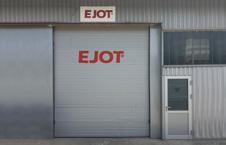
Bosnia and Herzegovina
EJOT Bulgaria EOOD & Ko. KD
Foundation: 2001
Distribution company
Product Focus:
Market Unit Construction Manager: Genadiy Pavlov
Employees: 13
Gurmazovsko shose No 96, 2227 Bozhurishte
T +359 2421 96 37
infoBG@ejot.com
www.ejot.bg
EJOT Danmark APS
Foundation: 1988
Distribution company
Product Focus:
Market Unit Construction Manager: Johan Oskarsson
Employees: 5
Industrisvinget 8, DK - 4683 Rønnede
T +45 56 39 84 00
InfoDK@ejot.com
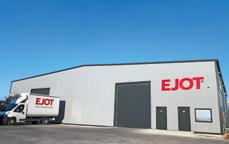
www.ejot.dk

Bulgaria
Denmark
EJOT moment 01 >> 2022 105
EJOT France S.A.R.L.
Foundation: 1987
Distribution company
Product Focus: Market Units Industry / Construction
Managers: Patrice Thil, Christian Kocherscheidt
Employees: 41
Z.I. de Villé, 5 rue du Climont, B.P. 40023, F-67220 Villé

T +33 388 58 92 00
InfoFR@ejot.com
www.ejot.fr
EJOT Ibérica, SLU
Foundation: 2007
Distribution company
Product Focus: Market Units Industry / Construction
Managers: José Miguel Rivero, Thomas Steinhauser
Employees: 22
/Adolfo Pérez Esquivel 3, Oficina 31, E- 28232 Las Rozas (Madrid)

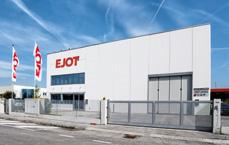
T +34 916 300 822
InfoES@ejot.com
www.ejot.es
EJOT S.A.S. di EJOT Tecnologie di fissaggio S.R.L.
Foundation: 2011
Distribution company
Product Focus:
Market Units Industry / Construction
Manager: Dr. Andrea Camola
Employees: 29
Via Marco Polo 16 - 35011 Campodarsego Padova
T +39 049 98690 00
InfoIT@ejot.com
www.ejot.it
France
Spain, Portugal
C/Plom 9, Nave 1B, E-43006 Tarragona
Tel. +34 977 218 032
Italy
01 >> 2022 EJOT moment 106 SUBSIDIARIES
EJOT Construction Fastening Systems Inc.
Foundation: 2017
Distribution company
Product Focus:
Market Unit Construction
Manager: Sedat Aricioglu
Employees: 5
6599 Kitimat Rd., Unit No. 2 Mississauga, Ontario L5N 4J4, Canada

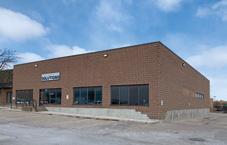
T +1 226 499 9977
InfoCA@ejot.com
EJOT Spojna Tehnika d.o.o..
Foundation: 2001
Distribution company
Product Focus: Market Unit Construction

Managers: Dr. Andrea Camola, Miomir Matanović
Employees: 12
Franje Lučića 23/3, HR-10090 Zagreb
T +385 1 349 86 12
InfoHR@ejot.com
www.ejot.hr
EJOT Festesystem A/S
Foundation: 1985
Distribution company
Product Focus:
Market Unit Construction
Manager: Johan Oskarsson
Employees: 8
Grinidammen 4, N-1359 Eiksmarka
T +47 23 25 30 40
InfoNO@ejot.com
www.ejot.no
Canada
Croatia
Norway
EJOT moment 01 >> 2022 107
EJOT Romania SRL

Foundation: 2001
Distribution company
Product Focus:
Market Units Industry / Construction
Manager: Vlad Marcu
Employees: 39
Șos. Comercială nr. 21 A, DN 65 B, Com Bradu, Sat Geamăna, Jud. Argeș, RO-117141
T +40 248 223 886
InfoRO@ejot.com
www.ejot.ro
Romania
EJOT Tehnika Spajanja d.o.o. Zemun
Foundation: 2006
Distribution company
Product Focus:
Market Units Industry / Construction
Managers: Dr. Andrea Camola, Oliver Djuric
Employees: 9
Auto put za Novi Sad 100E, RS-Republic of Serbia, 11080 Zemun
T +381 11 748 60 82
InfoRS@ejot.com
www.ejot.rs
Serbia
EJOT Fastening Systems


Asia Pacific Pte. Lte.
Foundation: 2021
Distribution company
Product Focus:
Market Units Industry / Construction
Managers: Christian Arnoldi, Andy Ho, Jochen Maaß
Employees: 3
7500A Beach Road # 15-313, The Plaza, 199591 Singapur
ejot_singapore@ejot.com
Singapore
01 >> 2022 EJOT moment 108 SUBSIDIARIES
EJOT SLOVAKIA, s.r.o.
Foundation: 2000
Distribution company
Product Focus:
Market Unit Construction
Manager: Juraj Novák
Employees: 17
Južná trieda 82 (areál VSS), SK-04017 KOŠICE
+421 55 622 17 60
InfoSK@ejot.com
www.ejot.sk
Slovakia
EJOT Sverige AB
Foundation: 1989
Distribution company
Product Focus:
Market Units Industry / Construction Manager: Johan Oskarsson


Employees: 53
Sandtagsvägen 9, S-702 36 Örebro
T +46 19 20 65 00
InfoSE@ejot.com
www.ejot.se
EJOT CZ, s.r.o.
Foundation: 1994
Distribution company

Product Focus:
Market Units Industry / Construction
Manager: Radim Matoušek
Employees: 27
Zděbradská 65, CZ-25101 Říčany – Jažlovice
T +420 323 62 78 11
InfoCZ@ejot.com
www.ejot.cz
Sweden
Czech Republic
EJOT moment 01 >> 2022 109
TOV EJOT-UKRAINA
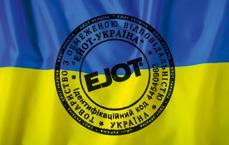
Foundation: 2021
Distribution company
Product Focus: Market Unit Construction
Managers: Aleksander Dubenchuk
Employees: 2
Ulica Myru 17A, 08702 Obuchiv, Kyiwer Region
T +38 (096) 269 75 88
InfoUA@ejot.com
www.ejot.com.ua
EJOT Hungaria Kft.
Foundation: 1996
Distribution company
Product Focus: Market Units Industry / Construction

Managers: Dr. Andrea Camola, Jochen Maass
Employees: 31
H-2310 Szigetszentmiklós, Leshegy út 16
T +36 24 519 360
InfoHUejot.com
www.ejot.hu
Ukraine
Hungary
EJOT Middle East FZE

Foundation: 2006
Distribution company
Product Focus:
Market Unit Construction
Manager: Fatih Delen
Employees: 16
Sharjah Airport International, Free Zone, P.O. Box 120588 Sharjah
T +971 6 557 97-70
InfoAE@ejot.com
www.ejot.ae
United Emirates
01 >> 2022 EJOT moment 110 SUBSIDIARIES
EJOT Sistemas de Construcción, S. DE R.L. DE C.V.
Foundation: 2020
Distribution company
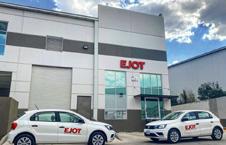
Product Focus: Market Unit Construction
Manager: Altug Asarlioglu
Employees: 13
Cuatipark II - Carr. Puente Grande, Las Ánimas S/N, Lt 5, Mz 800 Bodegas 13 Y 14, Municipio de Teoloyucan, México C. P. 54785
InfoMX@ejot.com
www.ejot.com.mx
Mexico
EJOT moment 01 >> 2022 111

01 >> 2022 EJOT moment 112 www.ejot.com Advertisement from 1992

















































































































































































































 >>Text: Andreas Wolf
>>Text: Andreas Wolf



































































